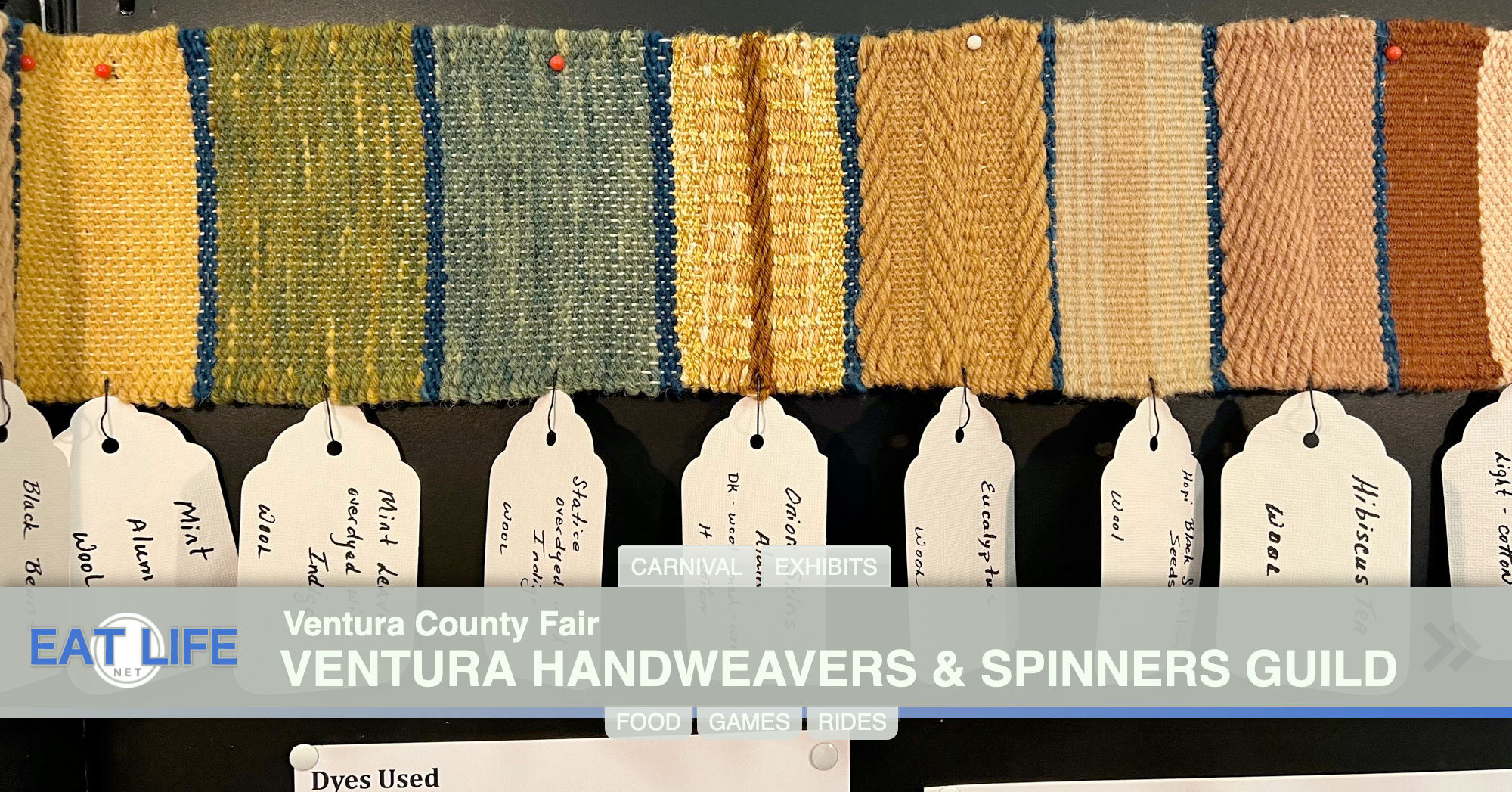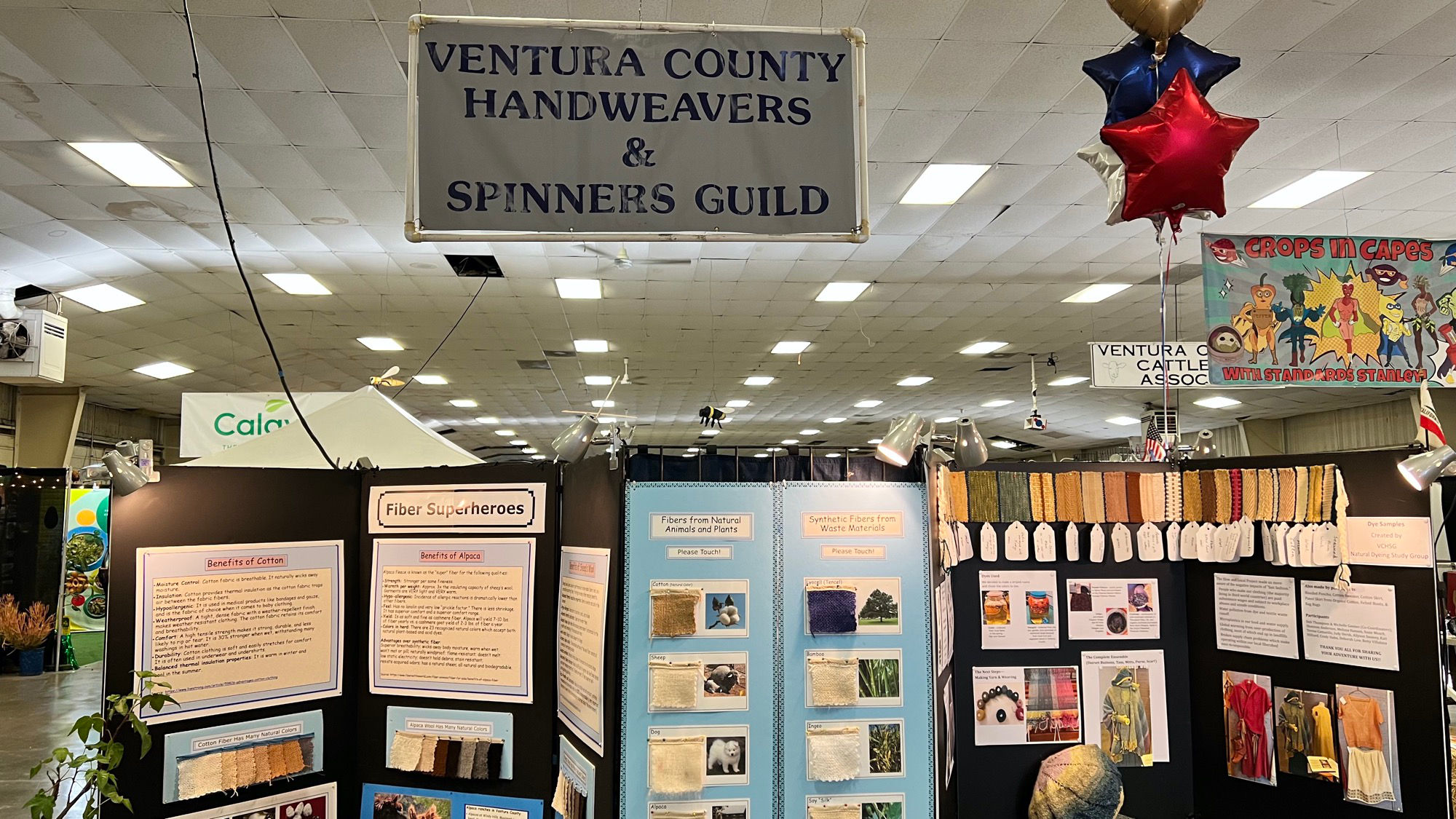
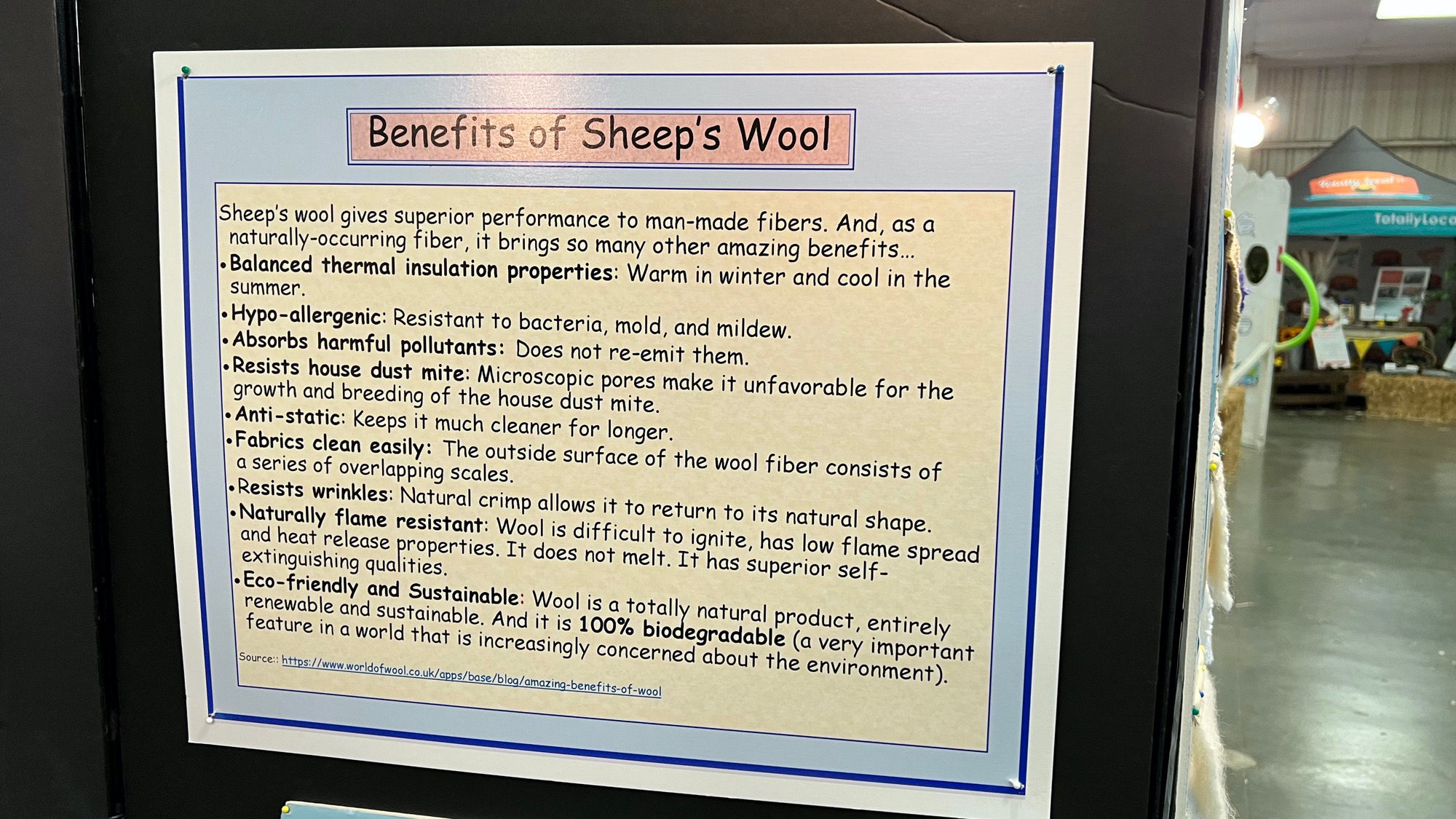
Sheep's wool gives superior performance to man-made fibers. And, as a naturally-occurring fiber, it brings so many other amazing benefits...
- Balanced thermal insulation properties: Warm in winter and cool in the summer.
- Hypo-allergenic: Resistant to bacteria, mold, and mildew.
- Absorbs harmful pollutants: Does not re-emit them.
- Resists house dust mite: Microscopic pores make it unfavorable for the growth and breeding of the house dust mite.
- Anti-static: Keeps it much cleaner for longer.
- Fabrics clean easily: The outside surface of the wool fiber consists of a series of overlapping scales.
- Resists wrinkles: Natural crimp allows it to return to its natural shape.
- Naturally flame resistant: Wool is difficult to ignite, has low flame spread and heat release properties. It does not melt. It has superior self- extinguishing qualities.
- Eco-friendly and Sustainable: Wool is a totally natural product, entirely renewable and sustainable. And it is 100% biodegradable (a very important feature in a world that is increasingly concerned about the environment).
Source: https://www.worldofwool.co.uk/apps/base/blog/amazing-benefits-of-wool
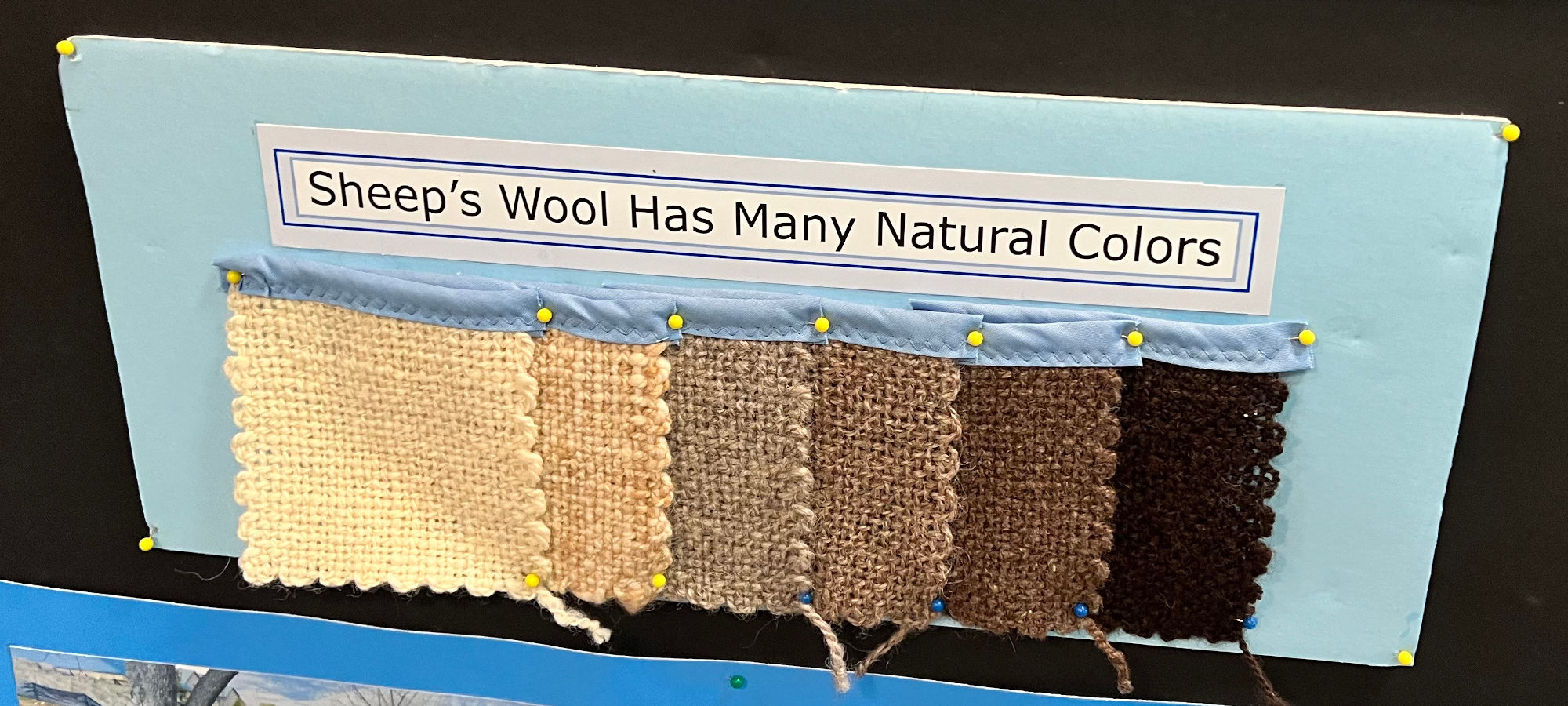
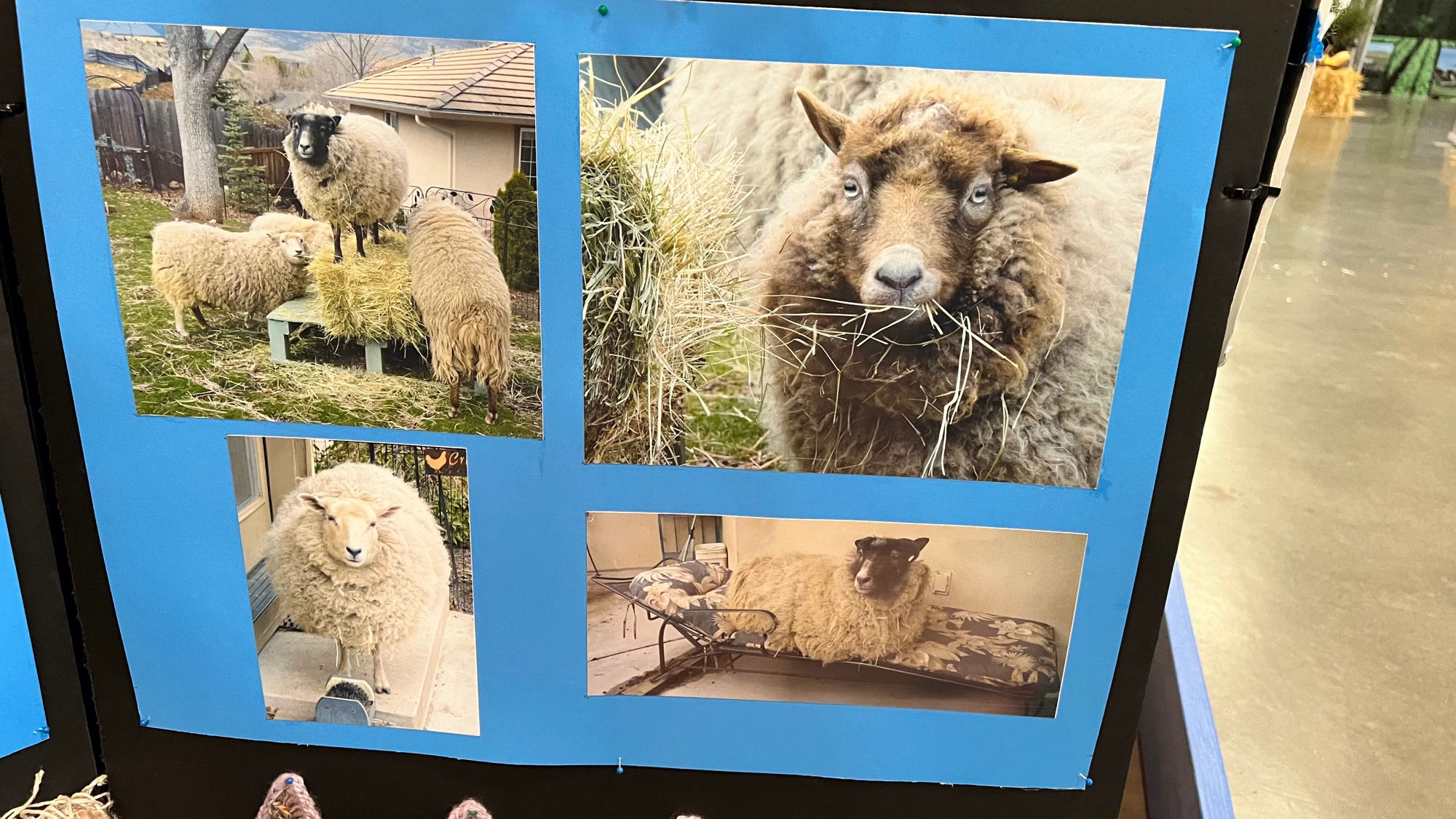
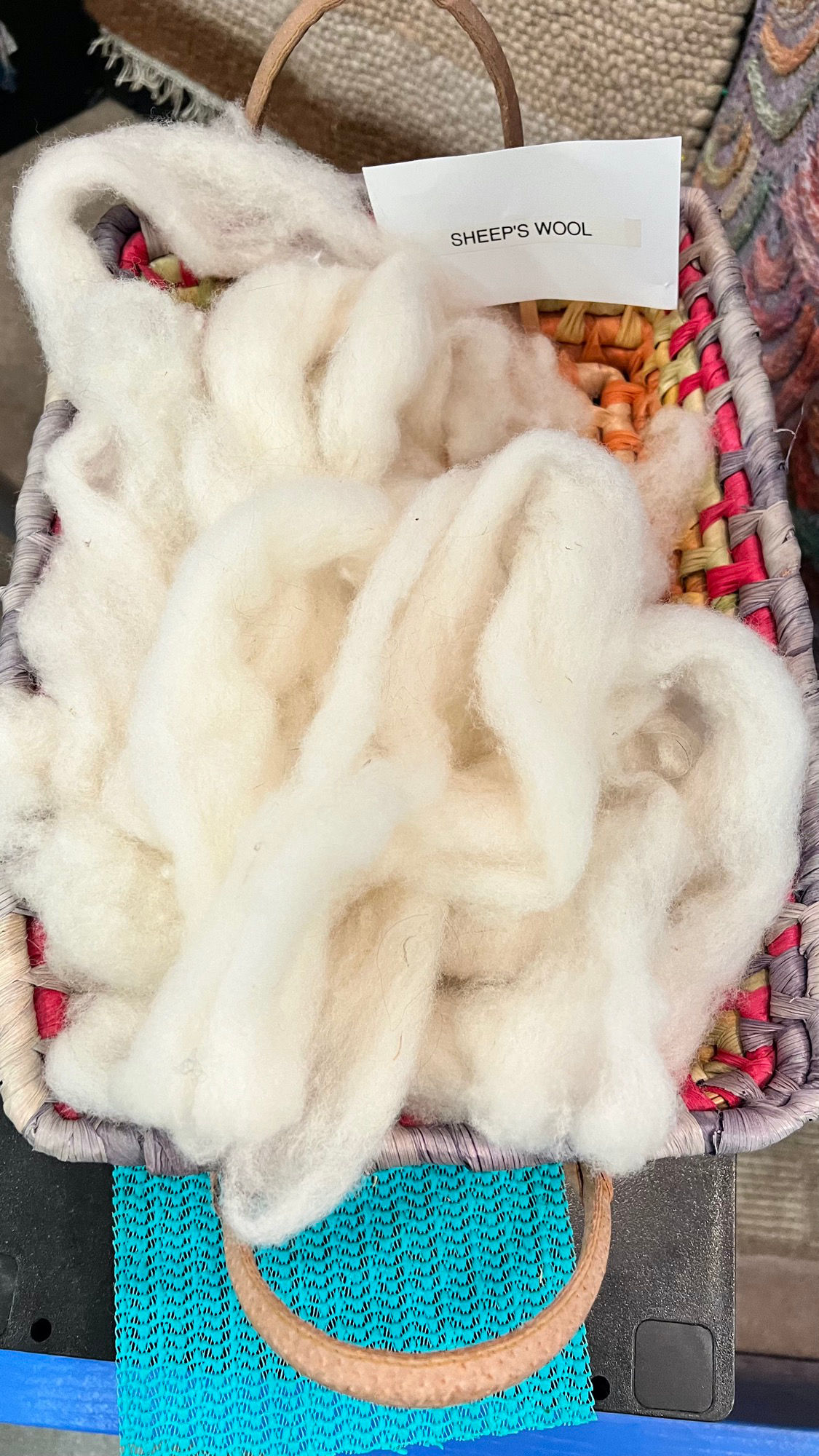
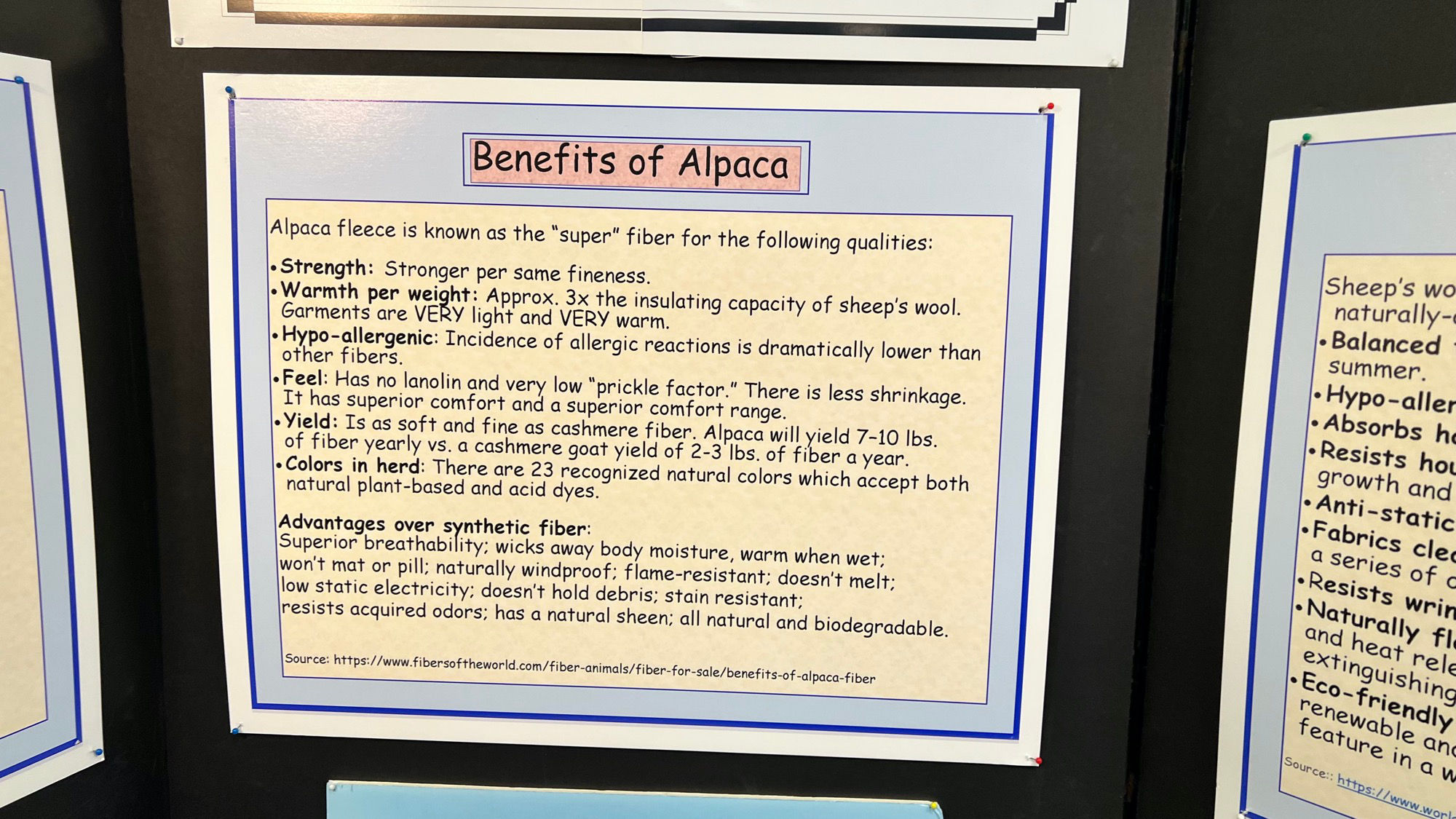
Alpaca Fleece is known as the "super" fiber for the following qualities:
- Strength: Stronger per same fineness.
- Warmth per weight: Approx. 3x the insulating capacity of sheep's wool. Garments are VERY light and VERY warm.
- Hypo-allergenic: Incidence of allergic reactions is dramatically lower than other fibers.
- Feel: Has no lanolin and very low "prickle factor." There is less shrinkage. It has superior comfort and a superior comfort range.
- Yield: Is as soft and fine as cashmere fiber. Alpaca will yield 7-10 Ibs. of fiber yearly vs. a cashmere goat yield of 2-3 lbs. of fiber a year.
- Colors in herd: There are 23 recognized natural colors which accept both natural plant-based and acid dyes.
- Advantages over synthetic fiber:
- Superior breathability
- Wicks away body moisture
- Warm when wet
- Won't mat or pill
- Naturally windproof
- Flame-resistant
- Doesn't melt
- Low static electricity
- Doesn't hold debris
- Stain resistant
- Resists acquired odors
- Has a natural sheen
- All natural and biodegradable
Source: http://www.fibersoftheworld.com/fiber-animals/fiber-for-sale/benefits-of-alpaca-fiber/
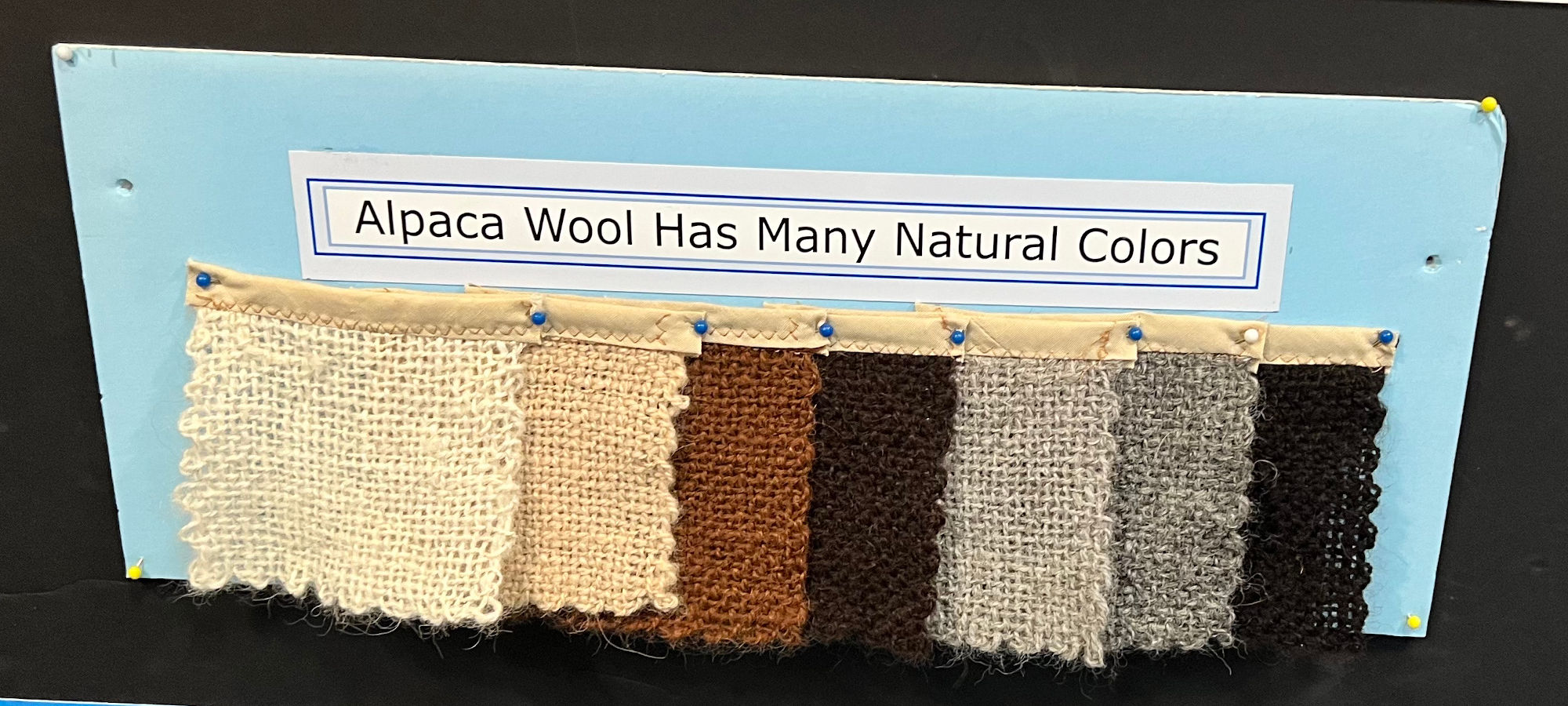
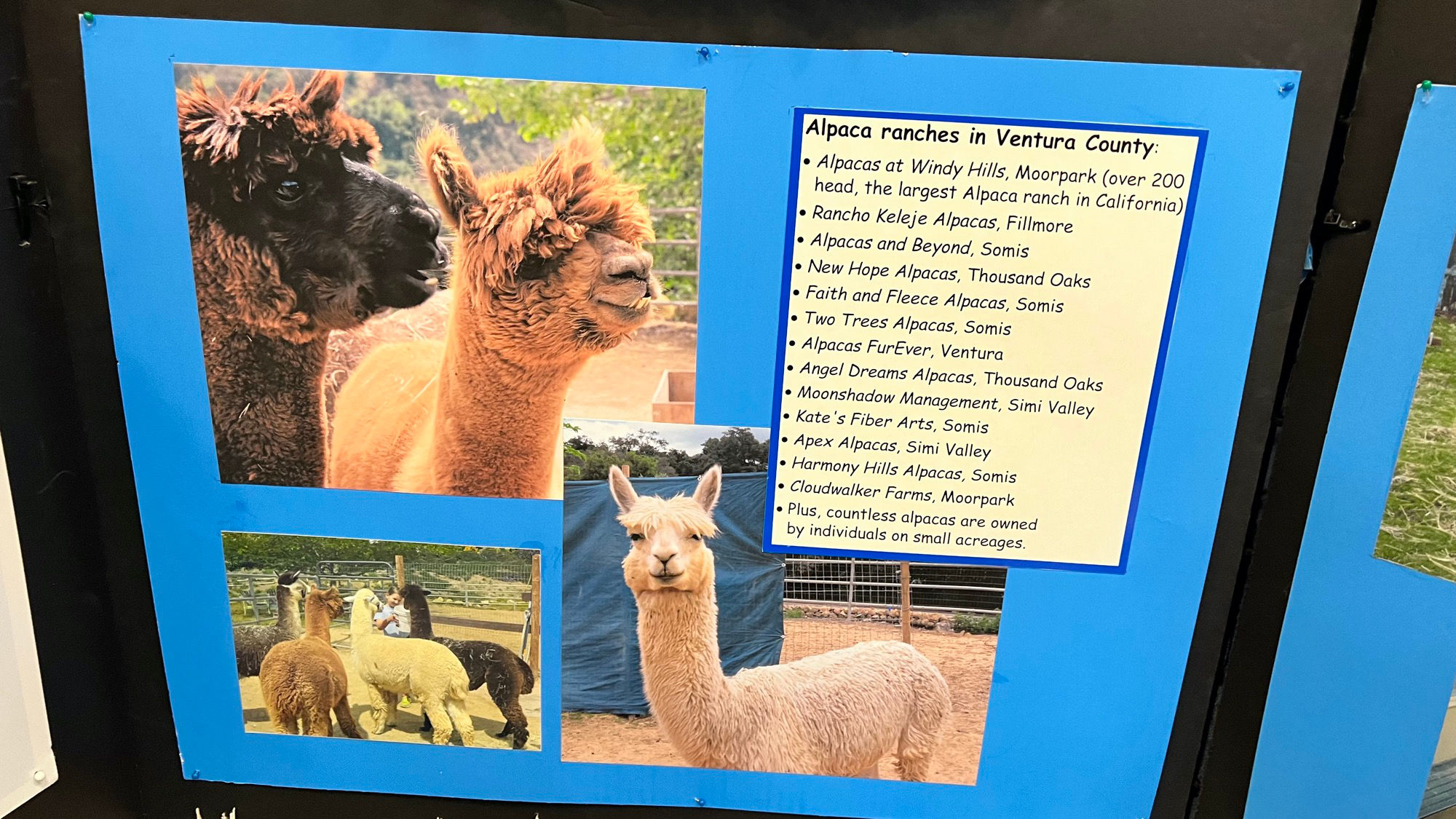
- Alpacas at Windy Hills, Moorpark (over 200 head, the largest Alpaca ranch in California)
- Rancho Keleje Alpacas, Fillmore
- Alpacas and Beyond, Somis
- New Hope Alpacas, Thousand Oaks
- Faith and Fleece Alpacas, Somis
- Two Trees Alpacas, Somis
- Alpacas FurEver, Ventura
- Angel Dreams Alpacas, Thousand Oaks
- Moonshadow Management, Simi Valley
- Kate's Fiber Arts, Somis
- Apex Alpacas, Simi Valley
- Harmony Hills Alpacas, Somis
- Cloudwalker Farms, Moorpark
- Plus, countless alpacas are owned by individuals on small acreages.
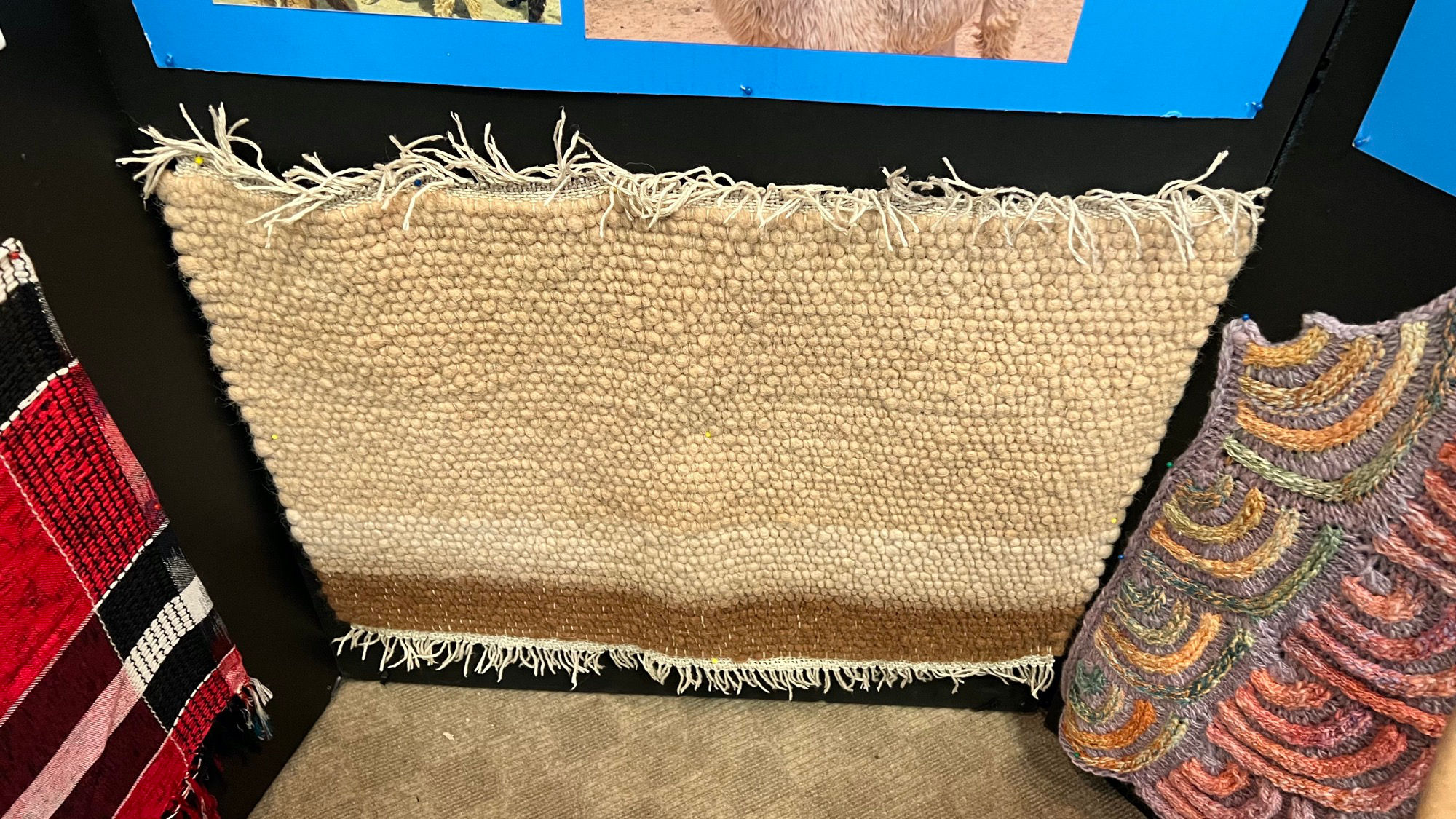
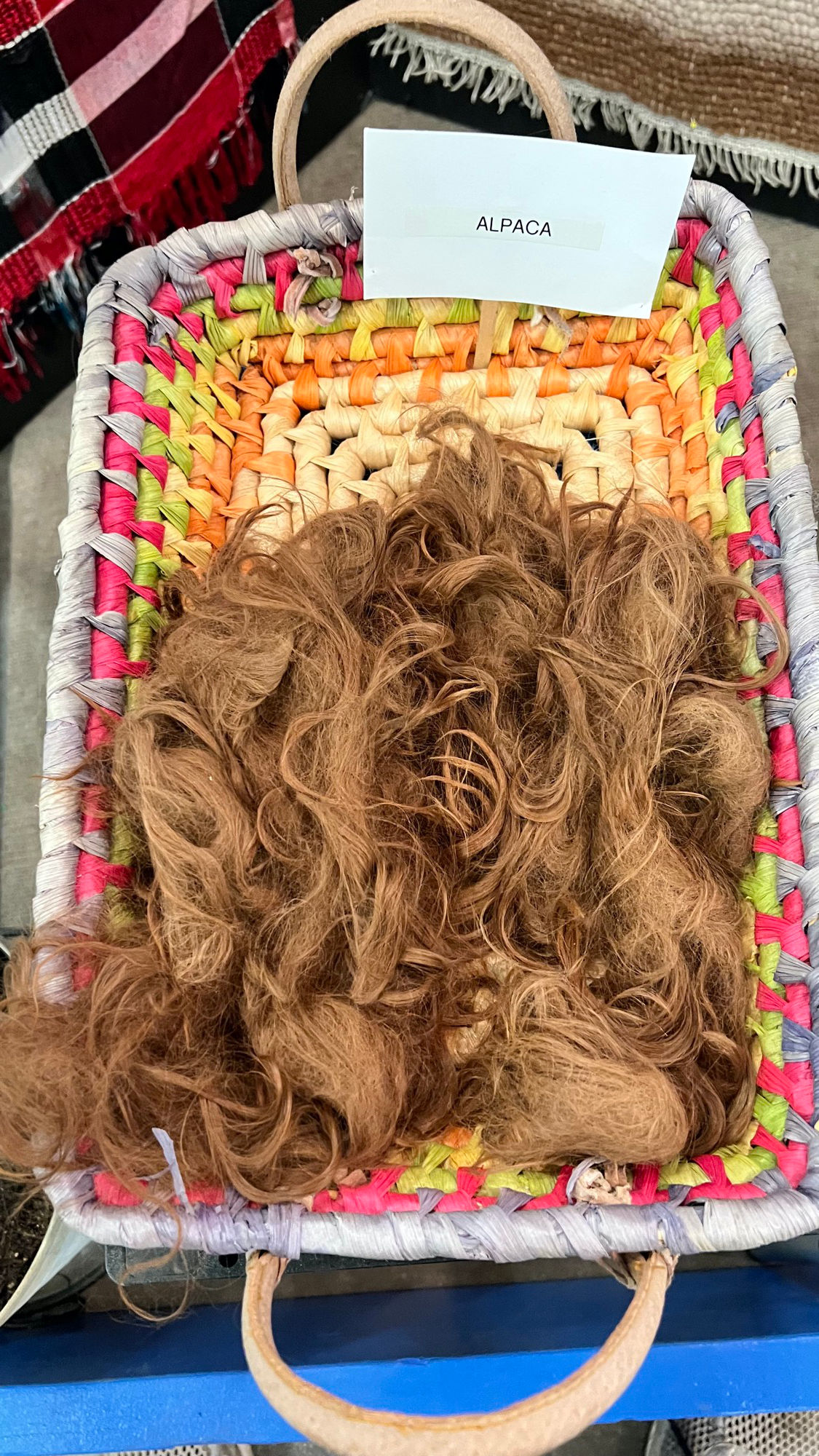
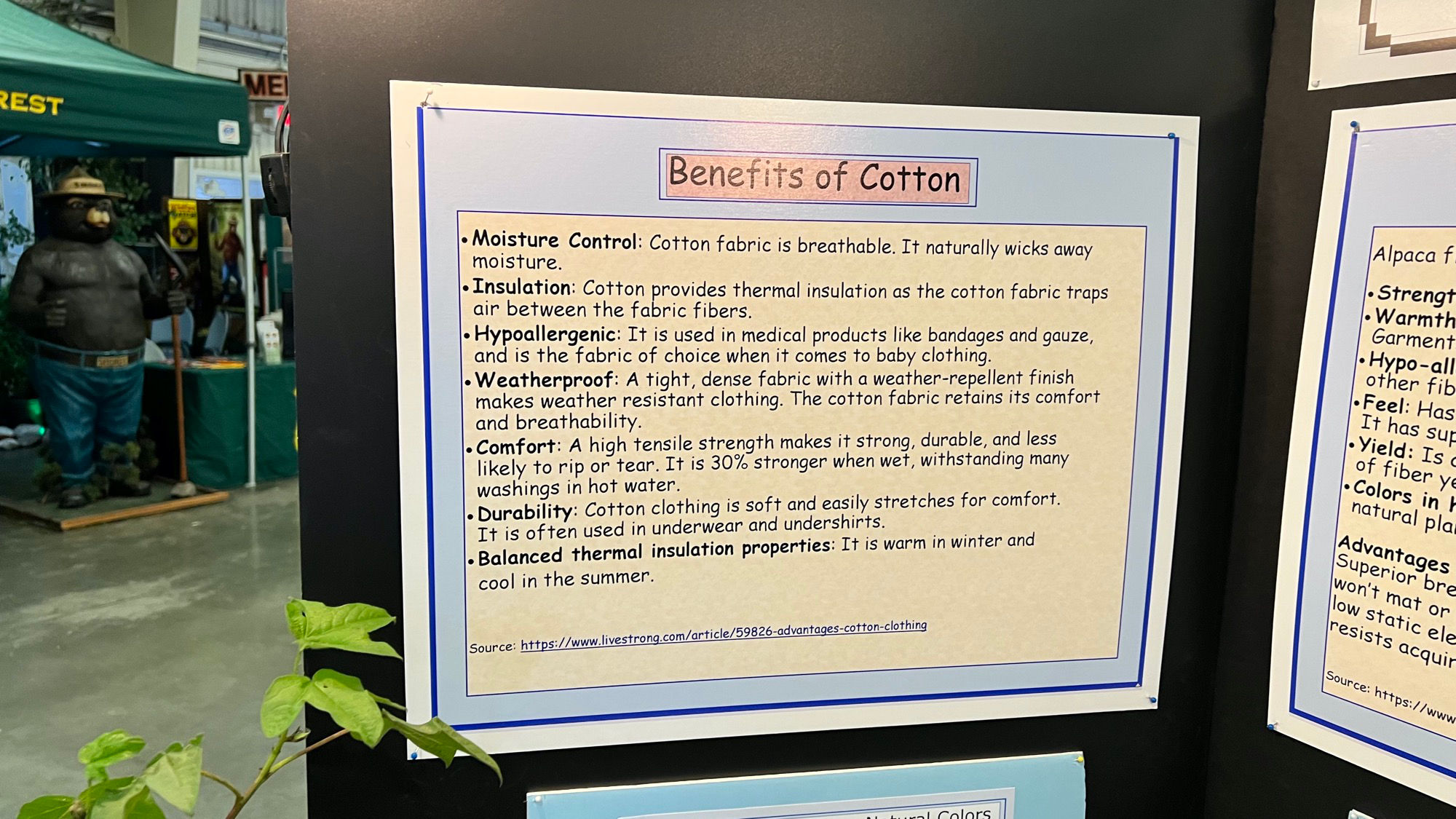
- Moisture Control: Cotton fabric is breathable. It naturally wicks away moisture.
- Insulation: Cotton provides thermal insulation as the cotton fabric traps air between the fabric fibers
- Hypoallergenic: It is used in medical products like bandages and gauze, and is the fabric of choice when it comes to baby clothing.
- Weatherproof: A tight, dense fabric with a weather-repellent finish makes weather resistant clothing. The cotton fabric retains its comfort and breathability.
- Comfort: A high tensile strength makes it strong, durable, and less likely to rip or tear. It is 30% stronger when wet, withstanding many washings in hot water.
- Durability: Cotton clothing is soft and easily stretches for comfort. It is often used in underwear and undershirts.
- Balanced thermal insulation properties: It is warm in winter and cool in the summer.
Source: https://www.livestrong.com/article/59826-advantages-cotton-clothing
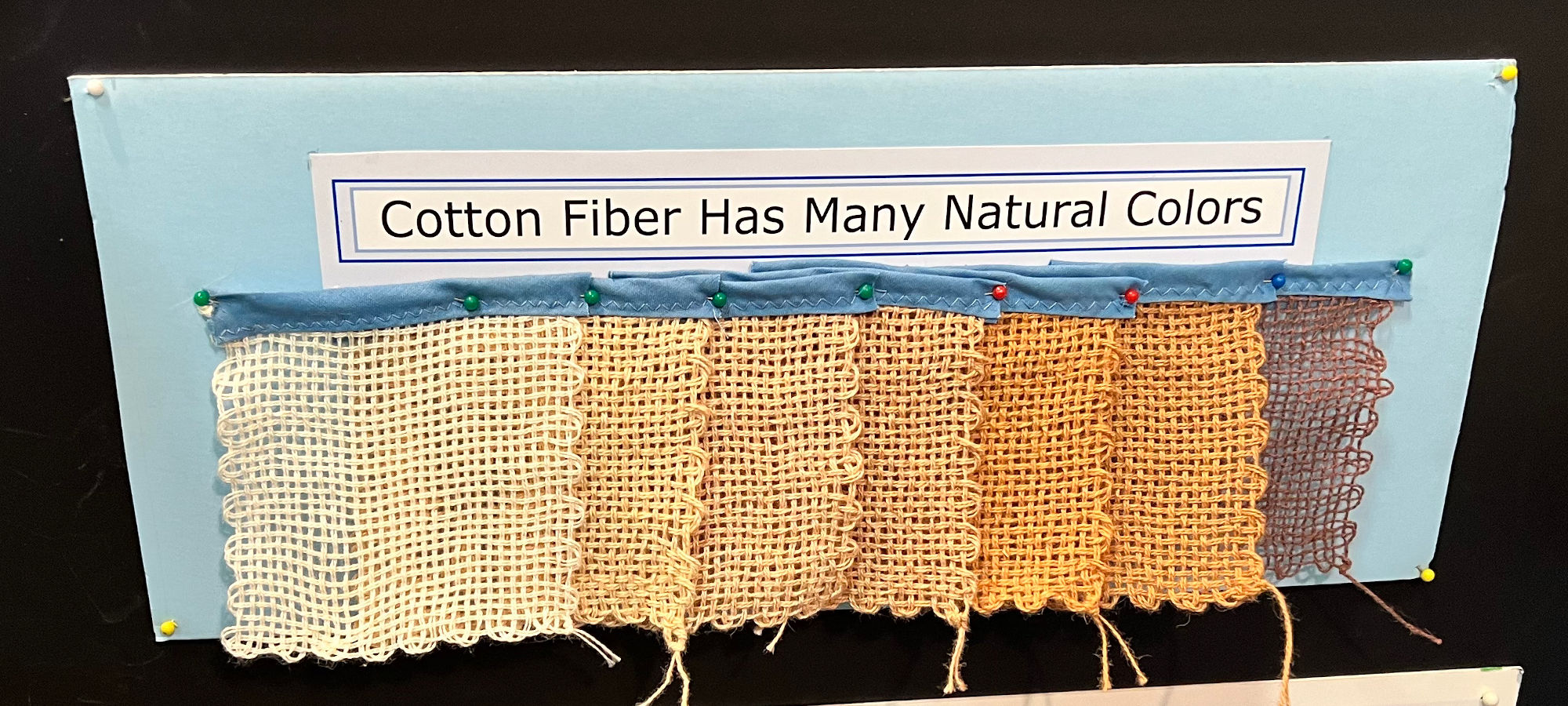
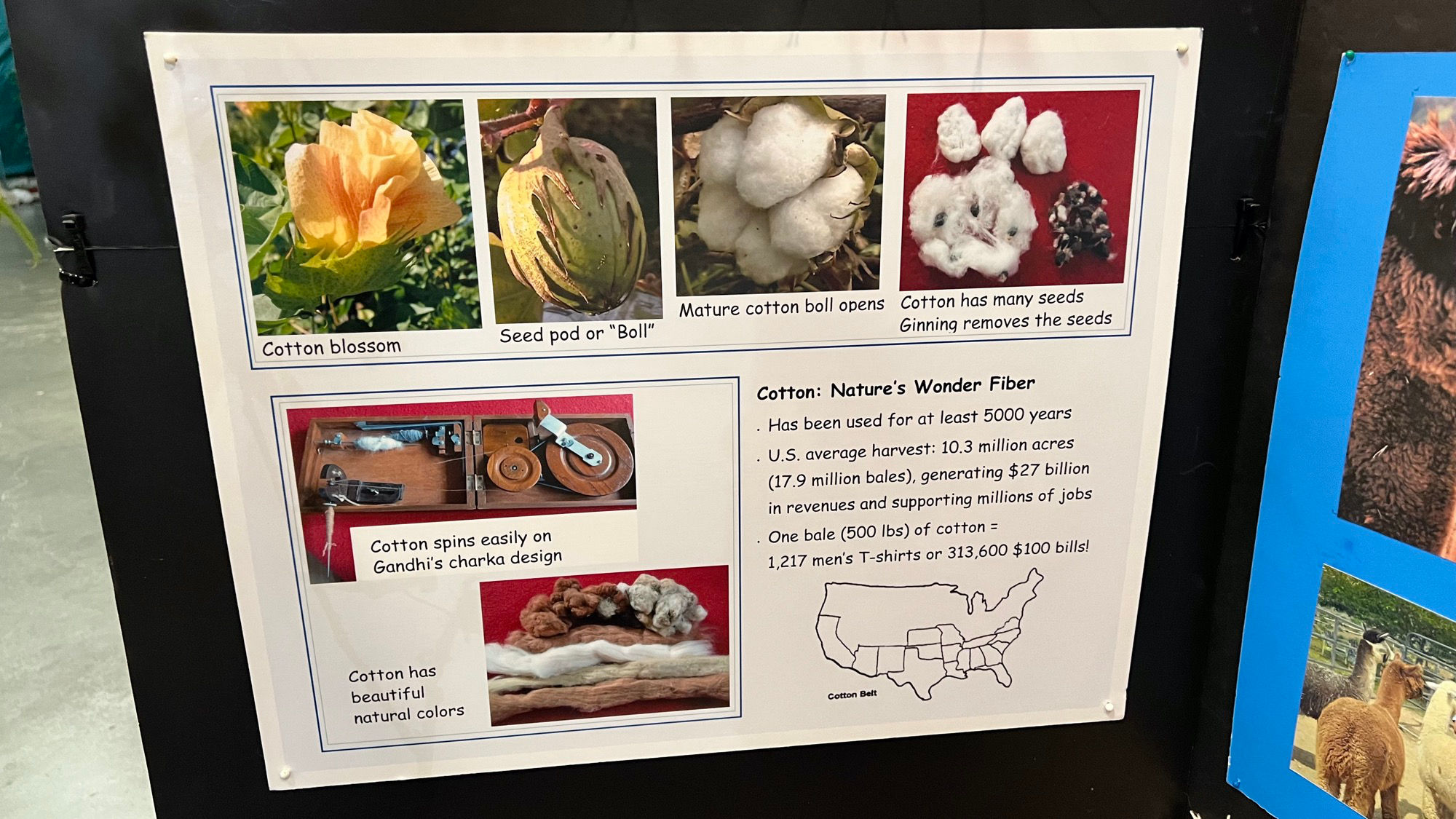
- Cotton Blossom
- Seed Pod or "boll"
- Mature Cotton Boll Opens
- Cotton has many Seeds
- Ginning Removes the Seeds
- Cotton Spins Easily on Gandhi's Charka Design
- Cotton has Beautiful Natural Colors
- Cotton has been used for at least 5000 years
- U.S. average harvest: 10.3 million acres (17.9 million bales), generating $27 billion in revenues and supporting millions of jobs
- One bale (500 Ibs) of cotton = 1,217 men's T-shirts or 313,600 $100 bills!
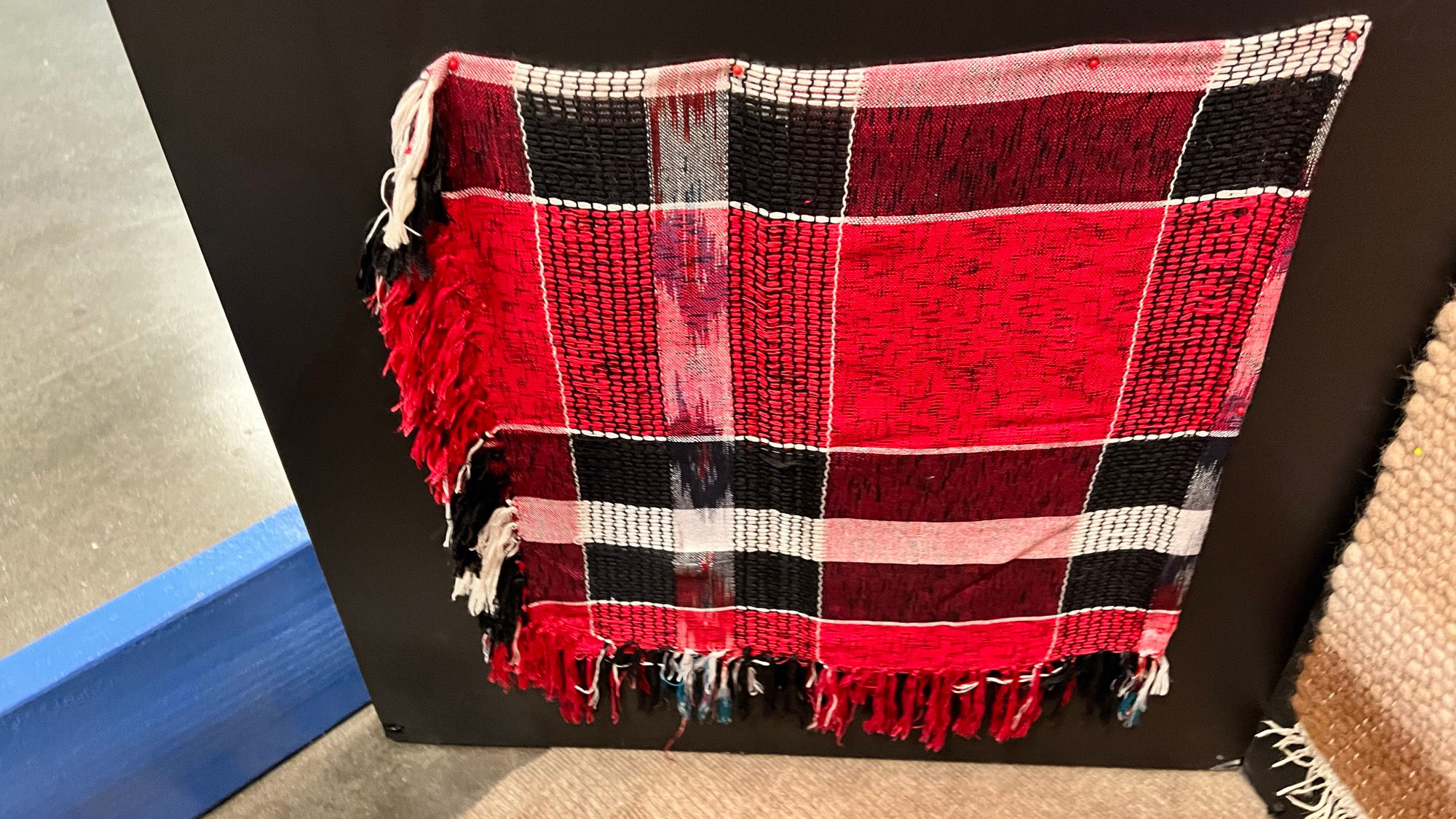
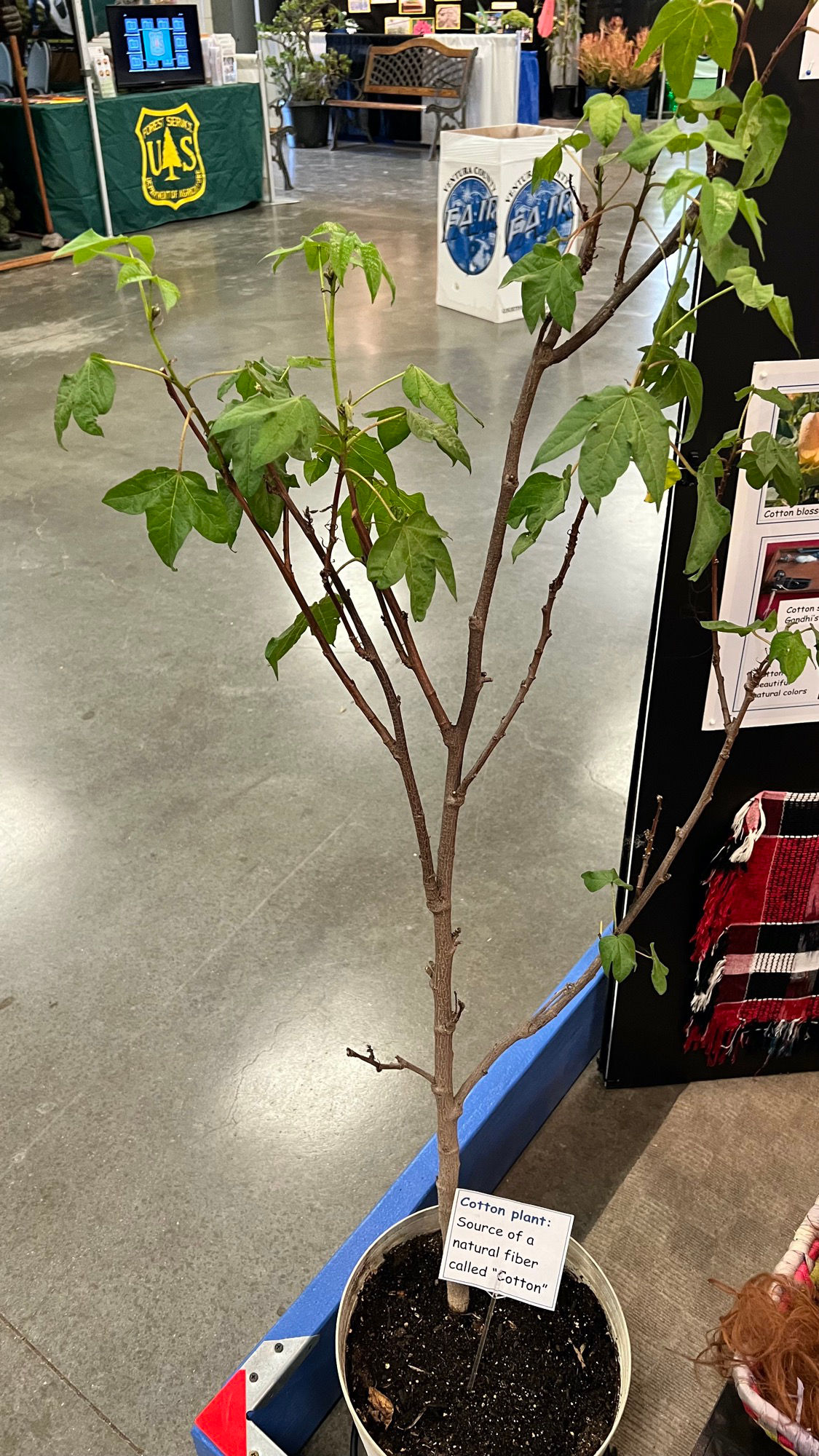
Source of a Natural Fiber called "Cotton"
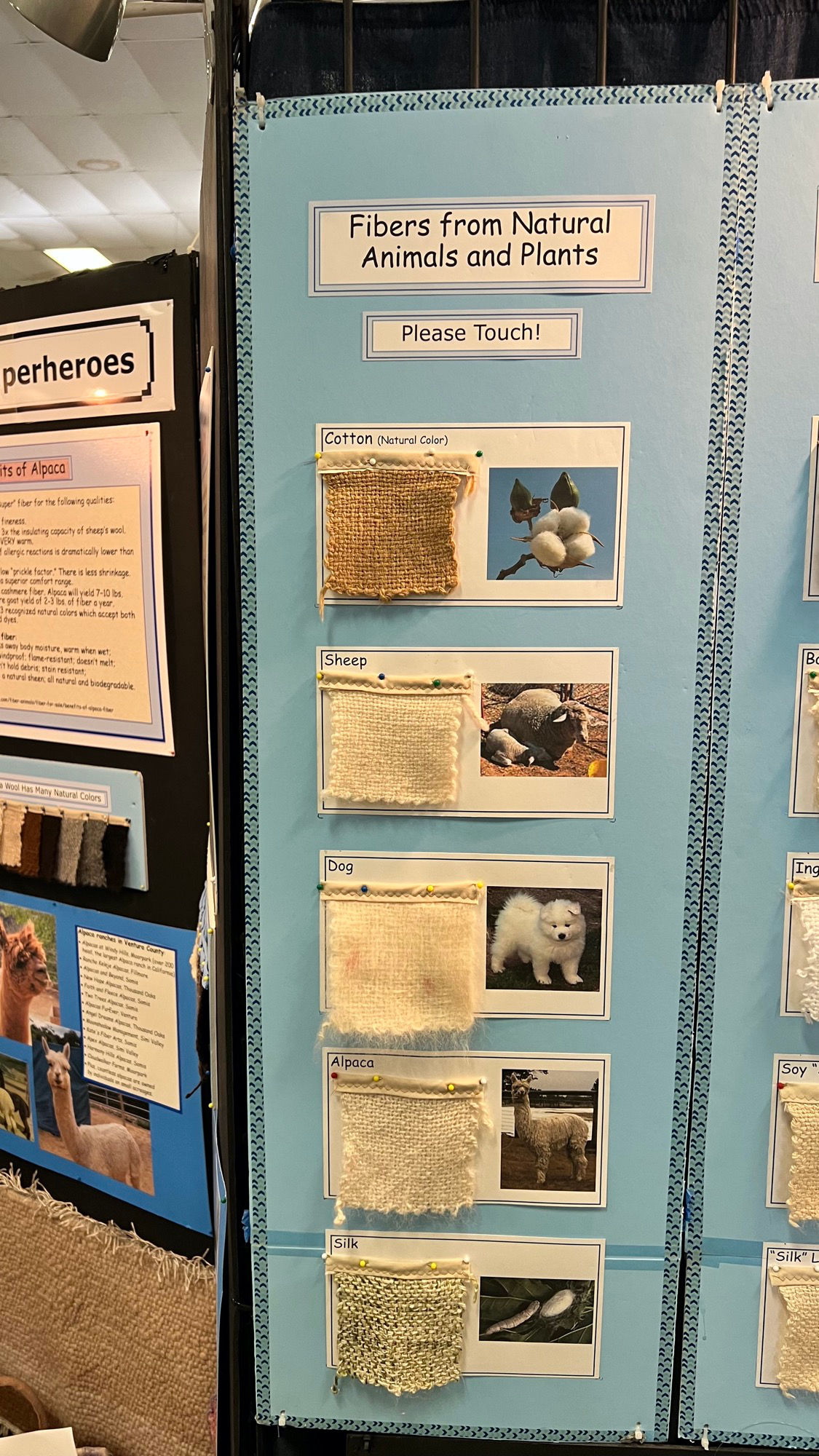
- Cotton (Natural Color)
- Sheep
- Dog
- Alpaca
- Silk
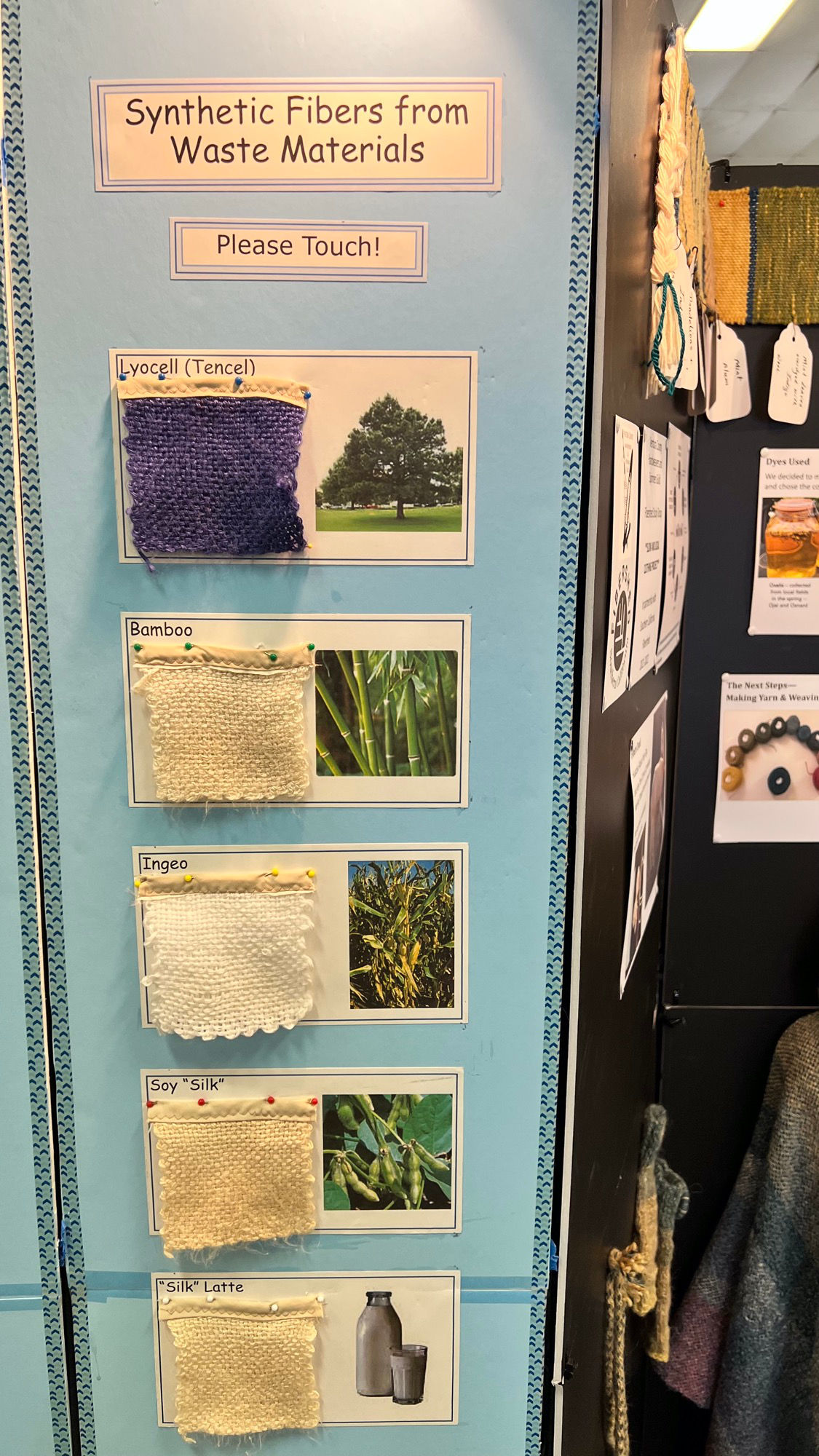
- Lyocel (Tencel
- Bamboo
- Ingeo
- Soy "Silk"
- "Silk" Latte
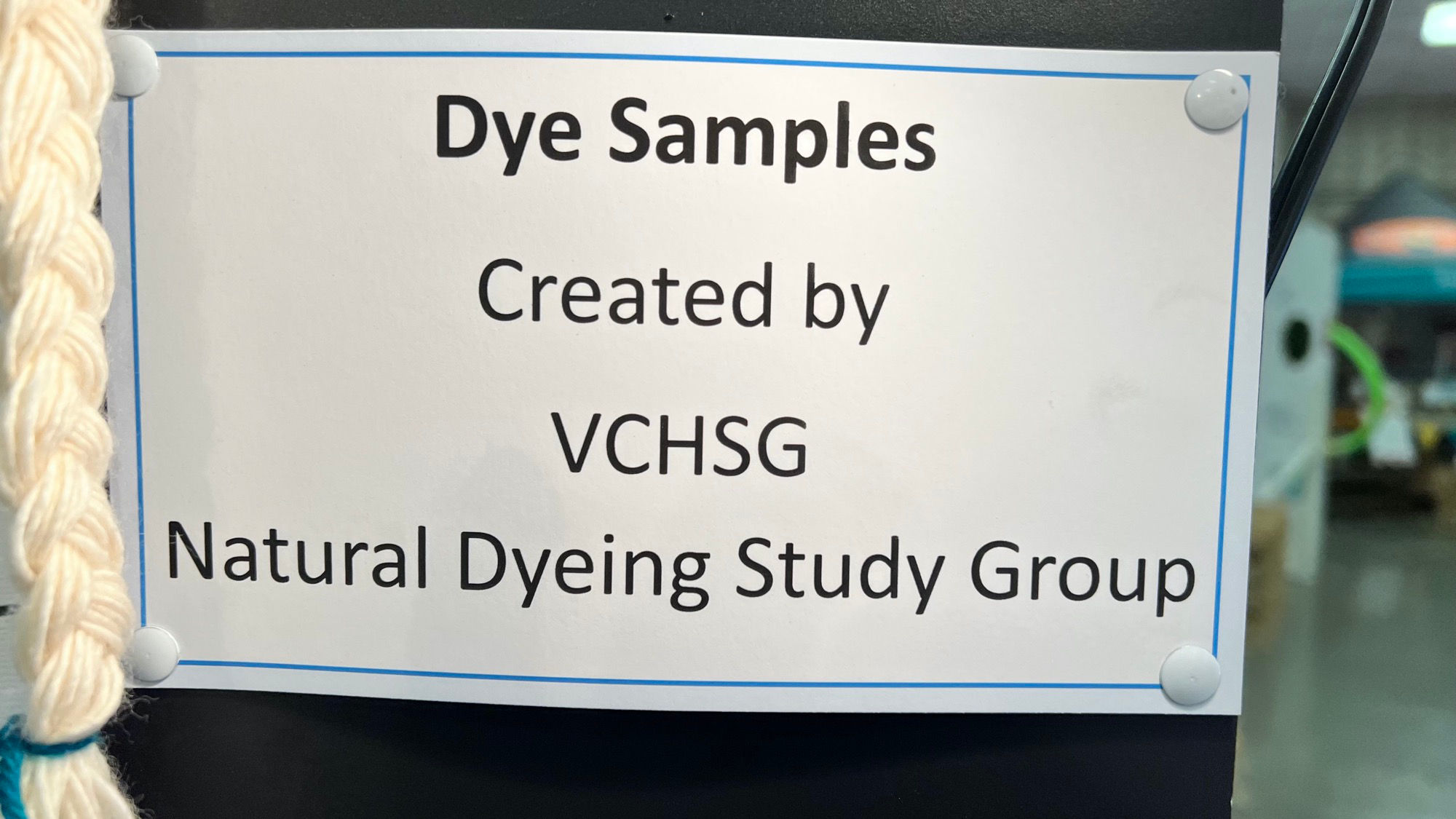
Created by VCHSG Natural Dyeing Study Group
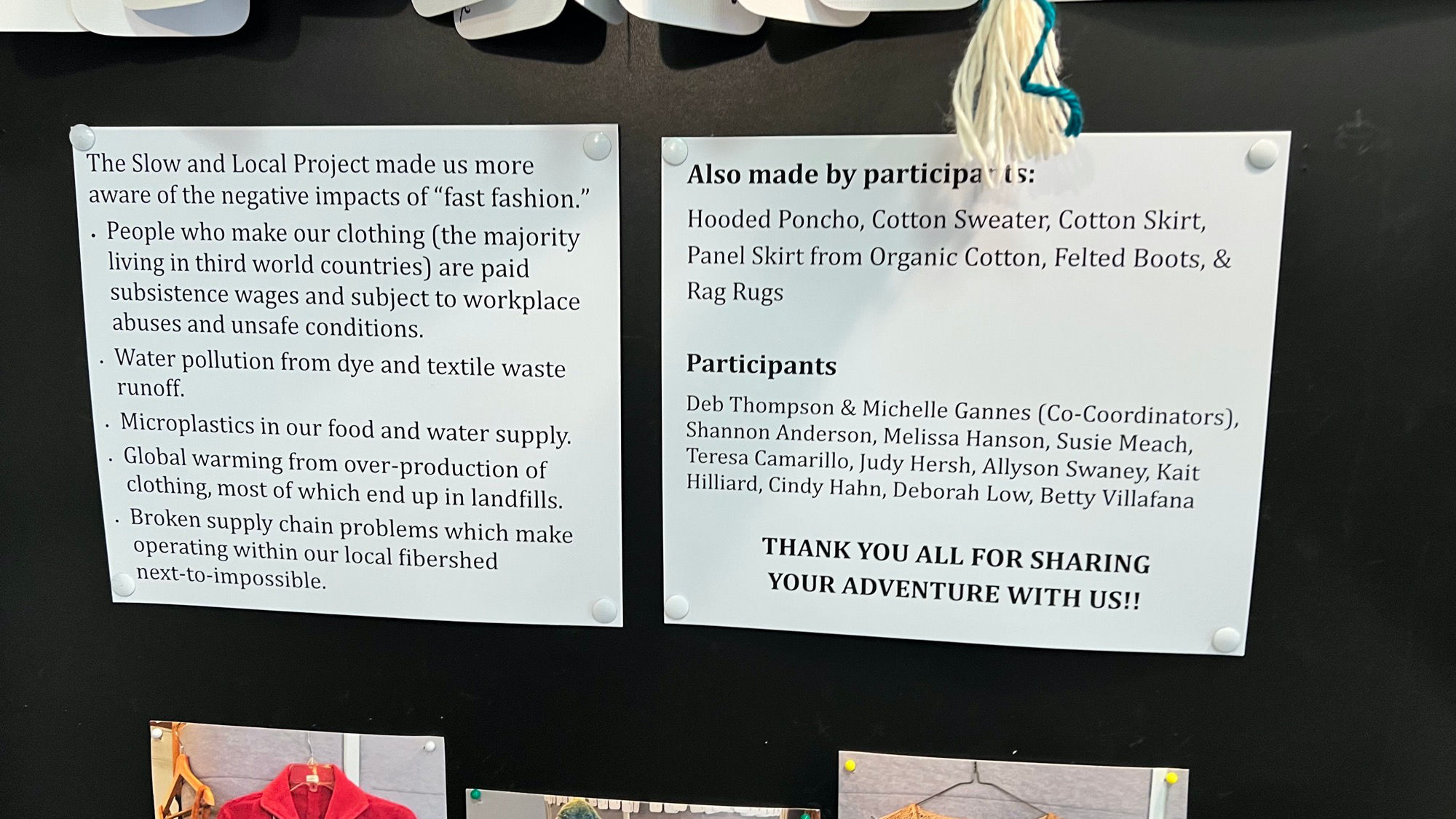
The Slow and Local Project made us more aware of the negative impacts of "fast fashion.
- People who make our clothing (the majority living in third world countries) are paid subsistence wages and subject to workplace abuses and unsafe conditions.
- Water pollution from dye and textile waste runoff.
- Microplastics in our food and water supply.
- Global warming from over-production of clothing, most of which end up in landfills. Broken supply chain problems which make operating within our local fibershed next-to-impossible.
Also Made by Participants
- Hooded Poncho
- Cotton Sweater
- Cotton Skirt
- Panel Skirt from Organic Cotton
- Felted Boots
- Rag Rugs
Participants
- Deb Thompson & Michelle Gannes (Co-Coordinators)
- Shannon Anderson
- Melissa Hanson
- Susie Meach
- Teresa Camarillo
- Judy Hersh
- Allyson Swaney
- Kait Hilliard
- Cindy Hahn
- Deborah Low
- Betty Villafana
Thank you all for sharing your adventure with us!!
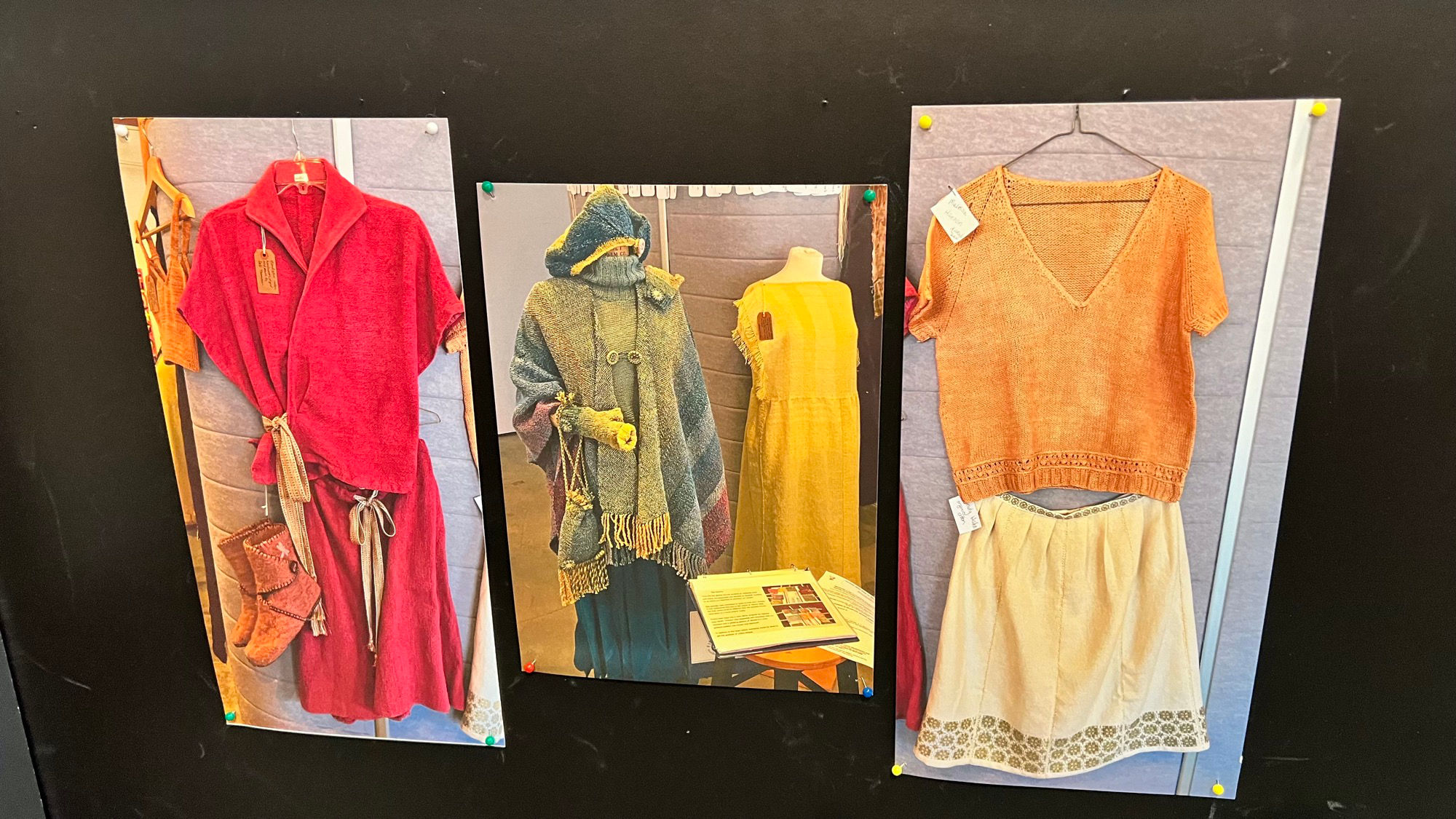
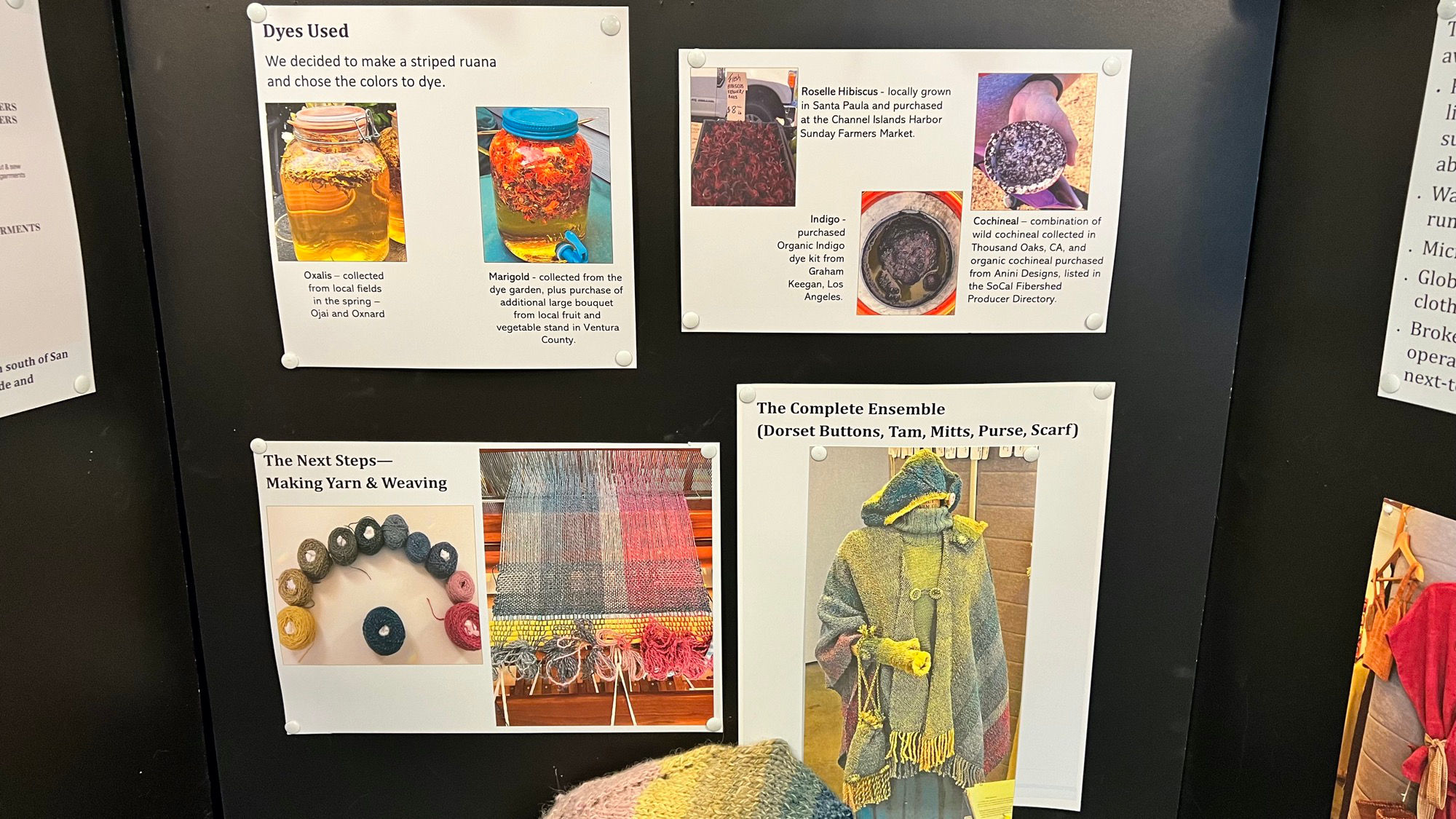
We decided to make a striped ruana and chose the colors to dye
- Oxalis - Collected from local fields in the spring - Ojai and Oxnard
- Marigold - Collected from the dye garden, plus purchase of additional large bouquet from local fruit and vegetable stand in Ventura County
- Roselle Hibiscus - Locally grown in Santa Paula and purchased at the Channel Islands Harbor Sunday Farmers Market
- Indigo - Purchased Organic Indigo dye kit from Graham Keegan, Los Angeles
- Cochineal - Combination of wild cochineal collected in Thousand Oaks, CA and organic cochineal purchased for Anini Designs, listed in the SoCal Fibershed Producer Directory
The Next Steps
- Making Yarn
- Weaving
The Complete Ensemble
- Dorest Buttons
- Tam
- Mitts
- Purse
- Scarf
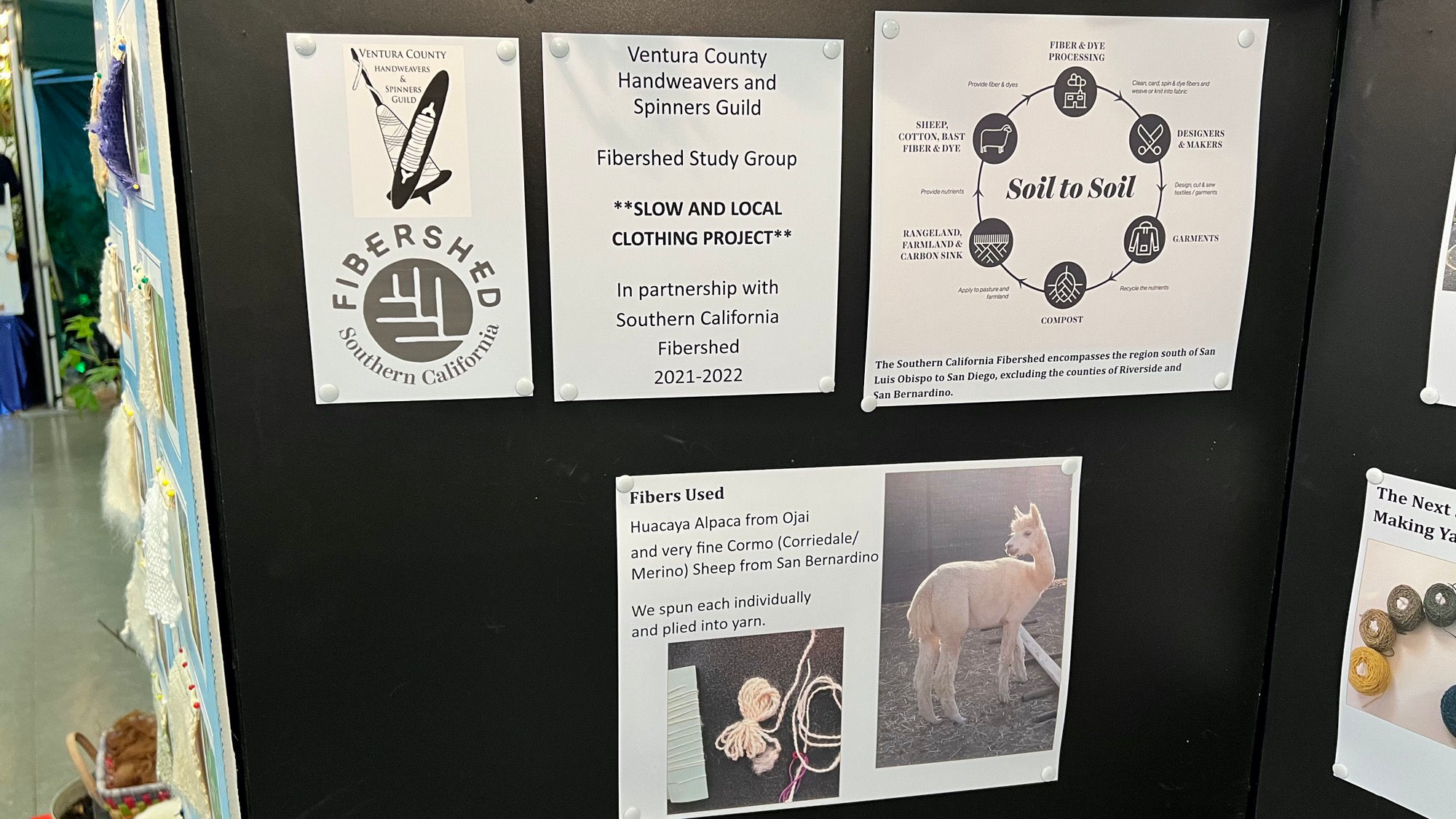
- Fiber & Dye Processing
Clean, card, spin, & dye fibers and weave or knit into fabric - Designers & Makers
Design, cut, & sew textiles / garments - Garments
Recycle the nutrients - Compost
Apply to pasture and farmland - Rangeland, Farmland, & Carbon Sink
Provide Nutrients - Sheep, Cotton, Bast, Fiber, & Dye
Provide fiber & dyes\
Fibers Used
Huacaya Alpaca from Ojai and very fine Cormo (Corriedale / Merino) Sheep from San Bernardino
We spun each individually and plied into yarn.
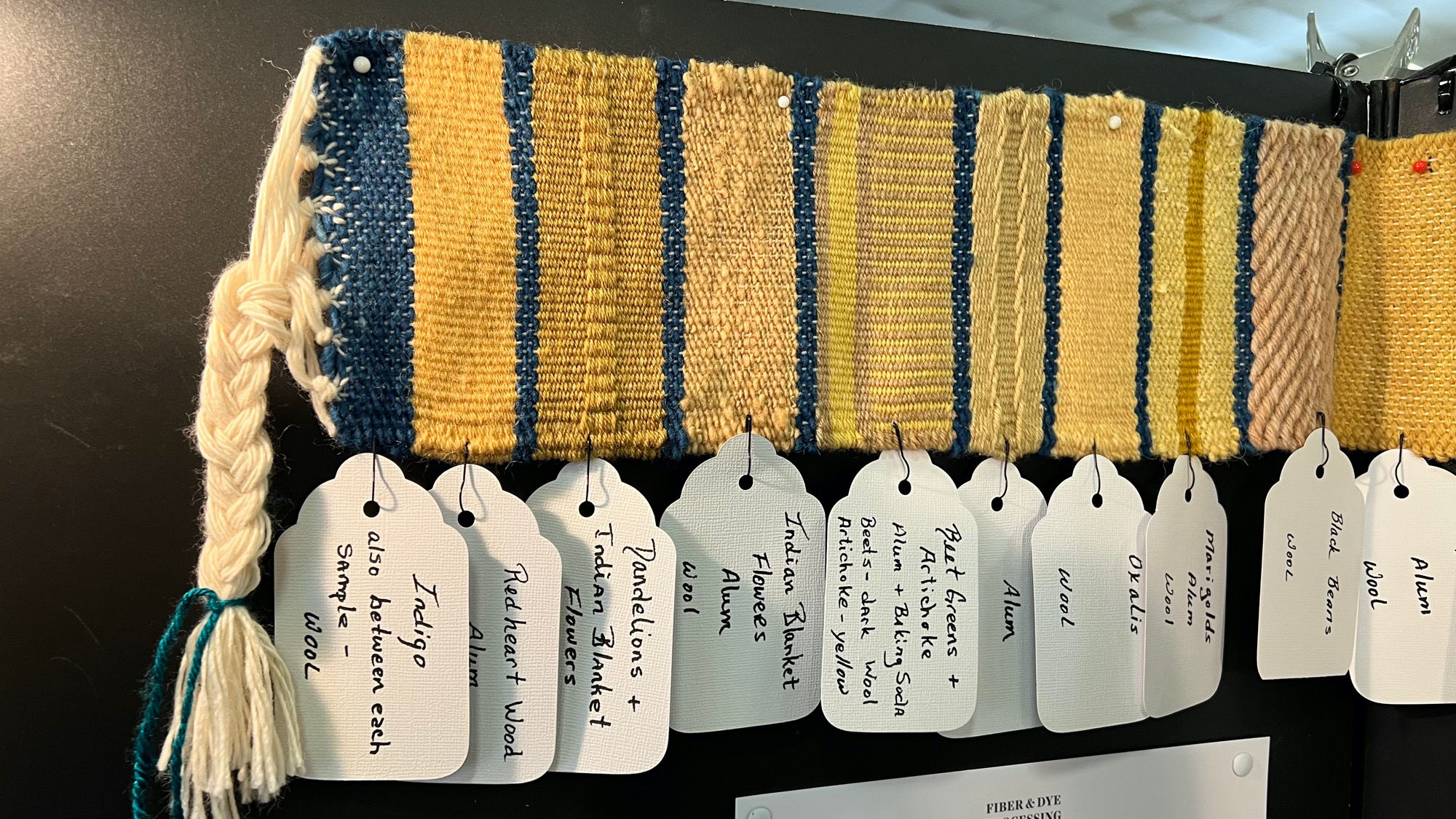
- Indigo (also between each sample) - Wool
- Red Heart Wood Alum
- Pandelions + Indian Blanket Flowers
- Indian Blanket Flowers Alum Wool
- Beet Greens + Artichoke Alam + Backing Soda Beats - (Dark Artichoke) - (Yellow Wool)
- Alum
- Oxalis Wool
- Marigolds Alum
- Black Beans Wool
- Mint Alum Wool
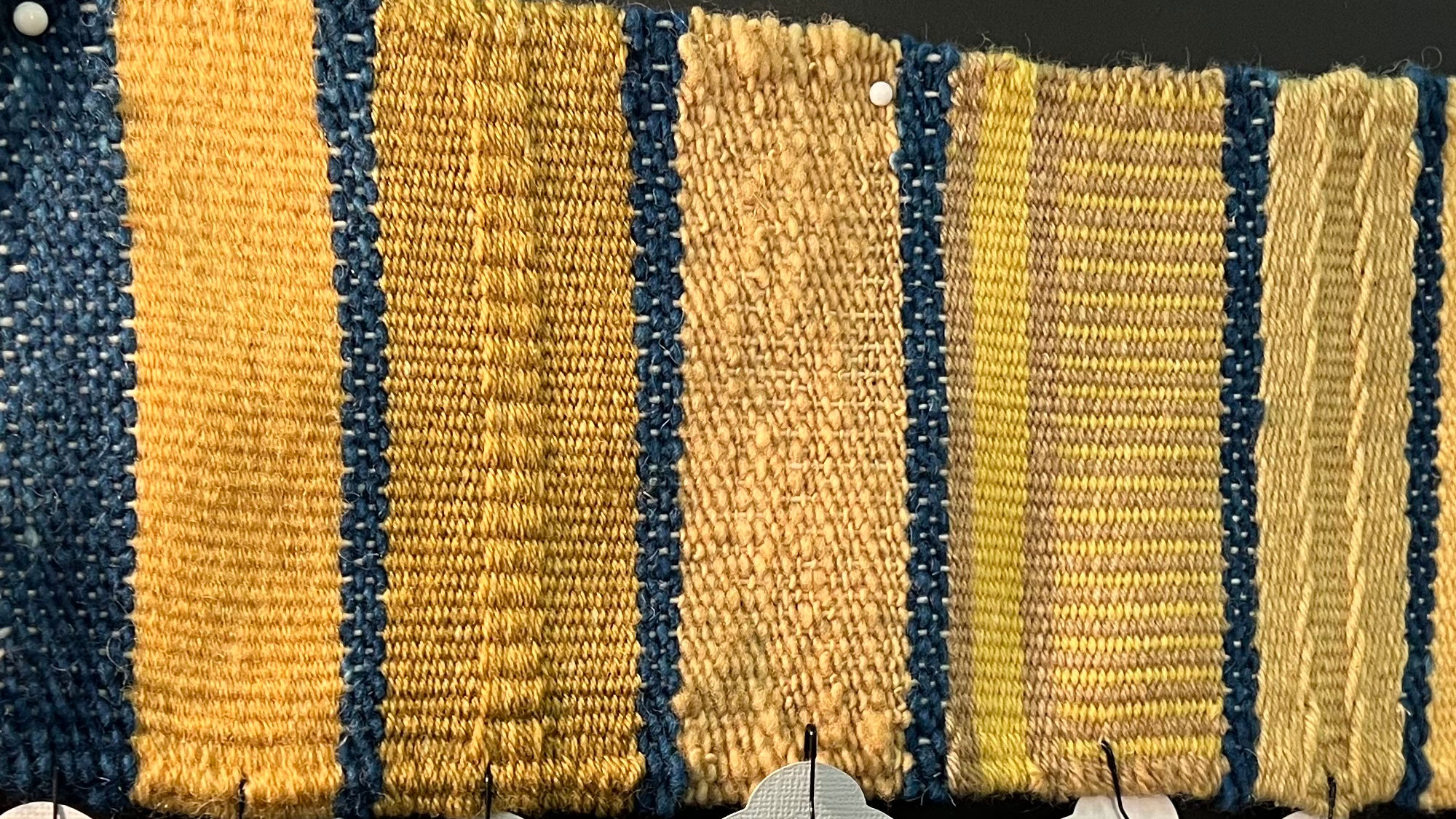
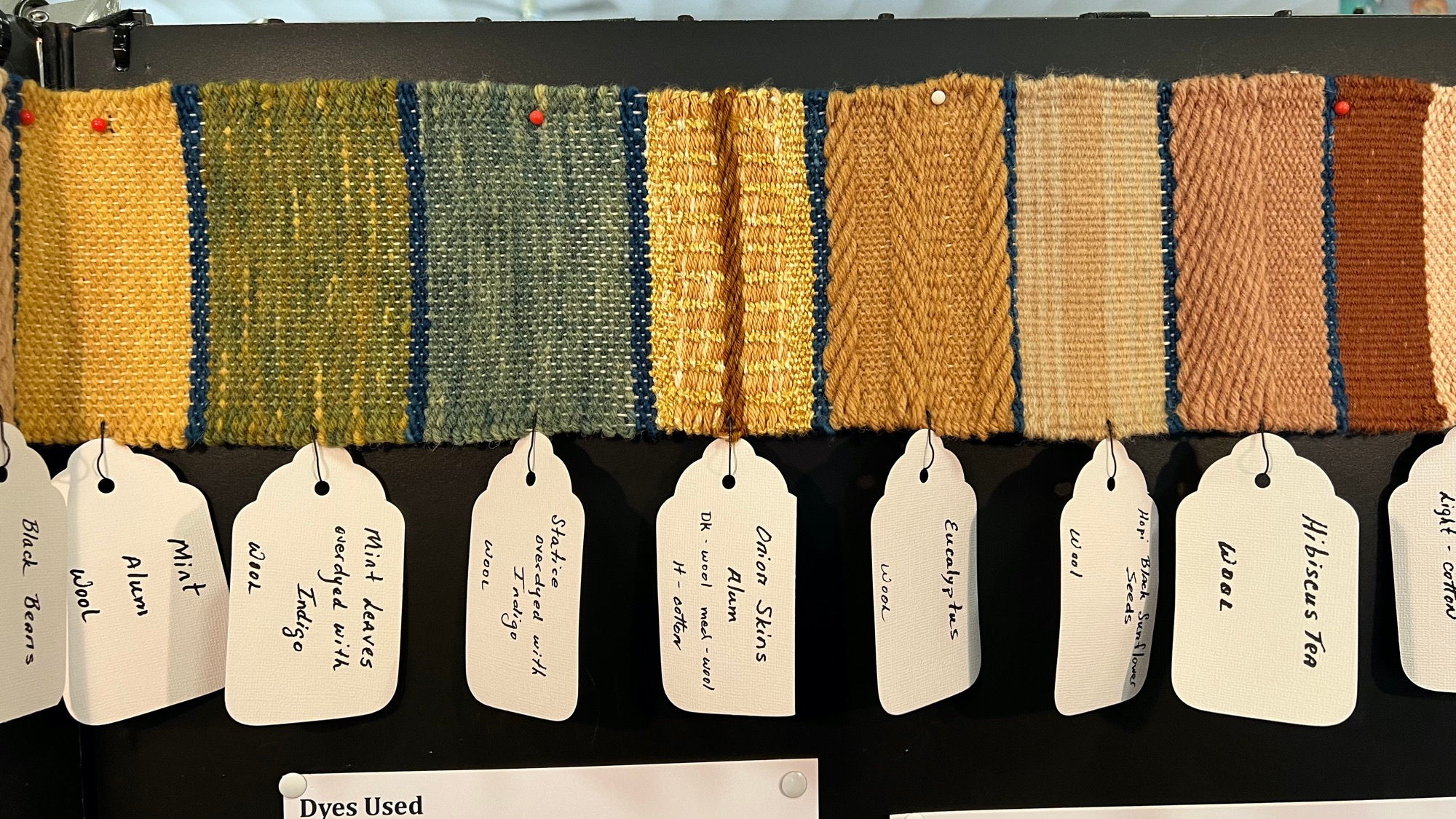
- Black Beans Wool
- Mint Alum Wool
- Mint Leaves Overdyed with Indigo Wool
- Statice Overdyed with Indigo Wool
- Onion Skins Alum DK Wool (Med - Wool) (H - Cotton)
- Eucalyptus Wool
- Hopi Black Sunflower Seeds Wool
- Hibiscus Tea Wool
- Avocado Skins + Pits (Dark - Wool) (Light - Cotton)
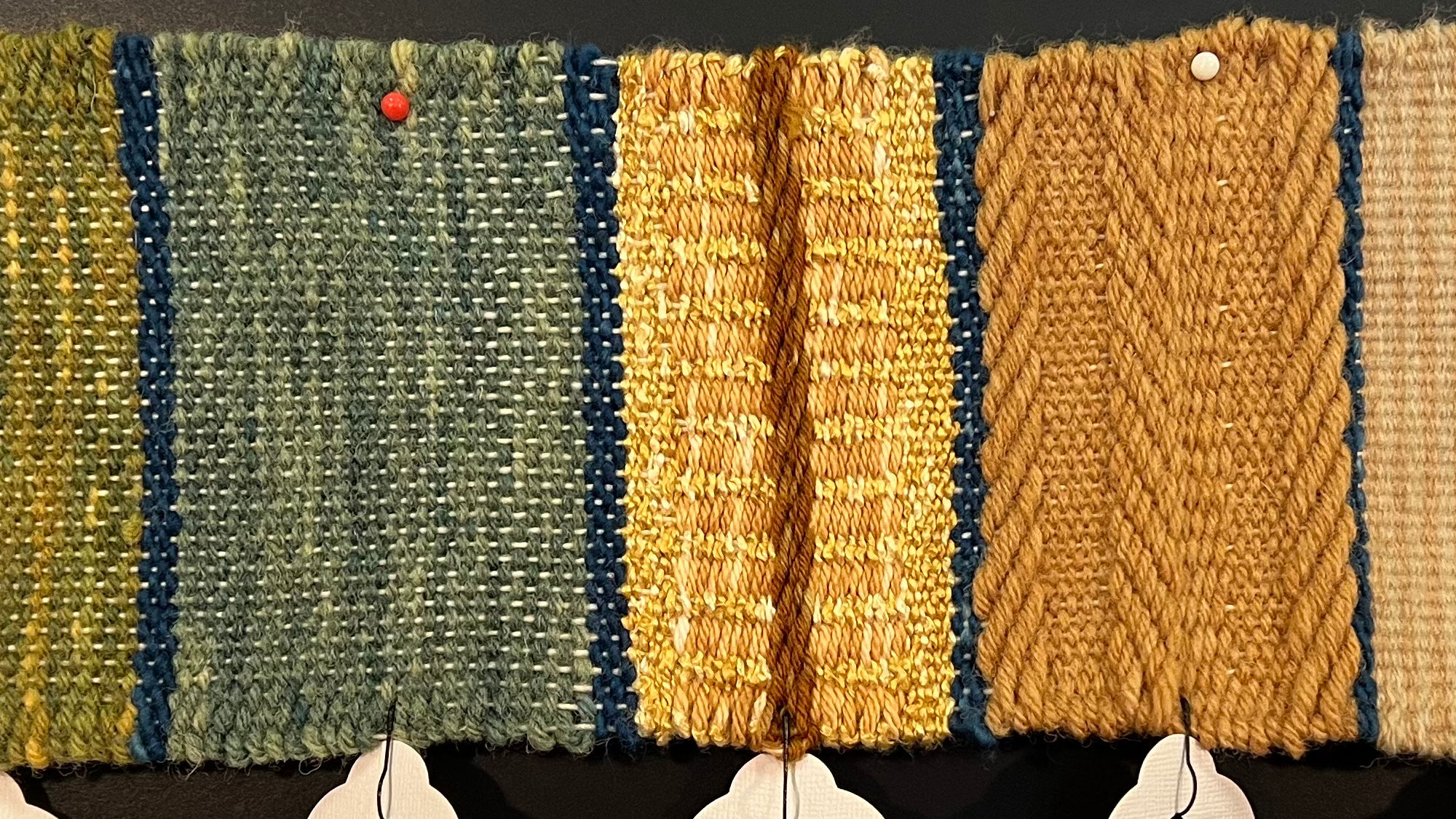
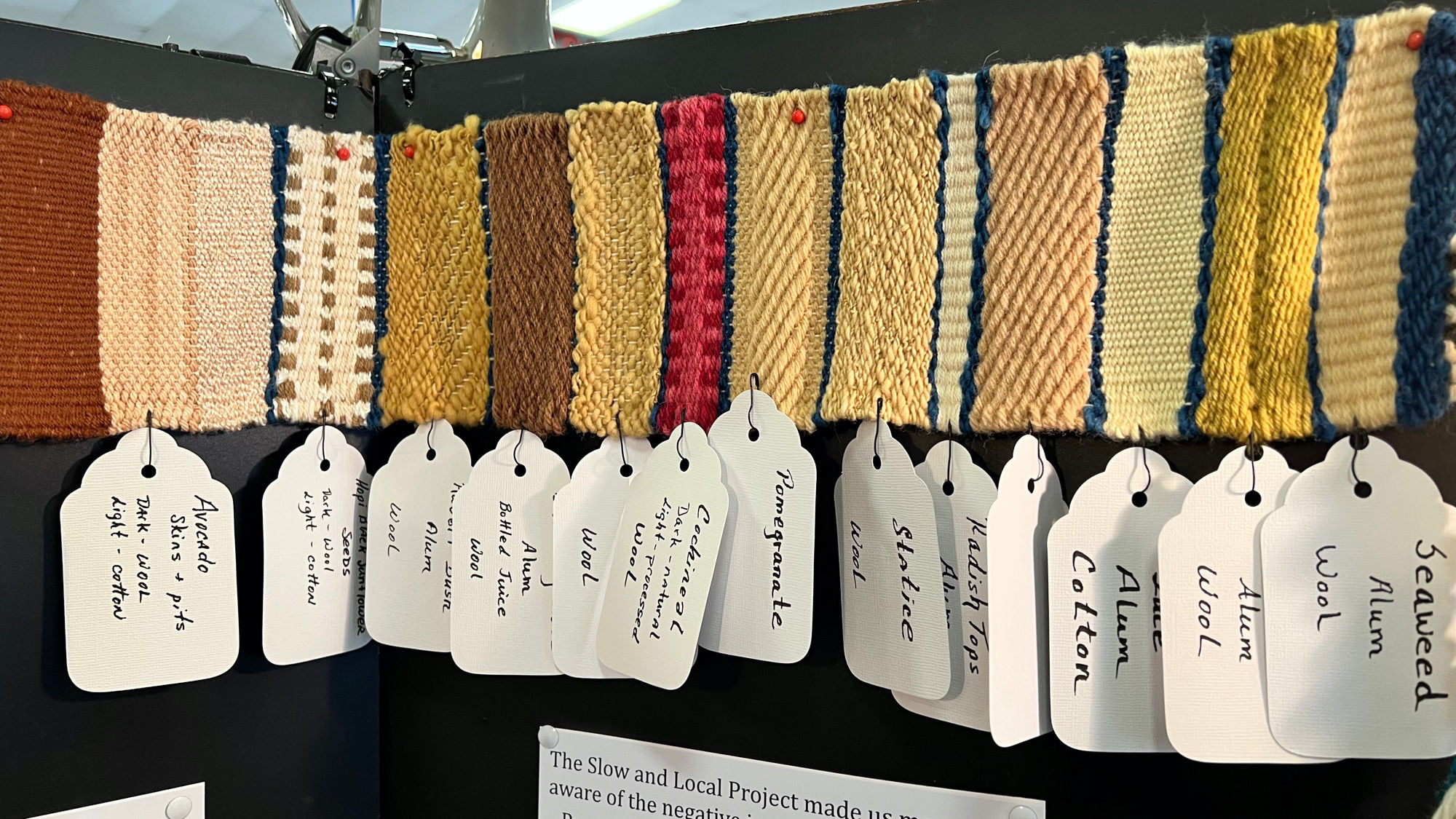
- Avocado Skins + Pits (Dark - Wool) (Light - Cotton)
- Hopi Black Sunflower Seeds (Dark - Wool) (Light - Cotton)
- - Alum Wool
- - Wool
- Cochineal (Dark - Natural) (Light - Processed) Wool
- Pomegranate
- Statice Wool
- Radish Tops Alum
- -
- - Alum Cotton
- - Alum Wool
- Seaweed Alum Wool
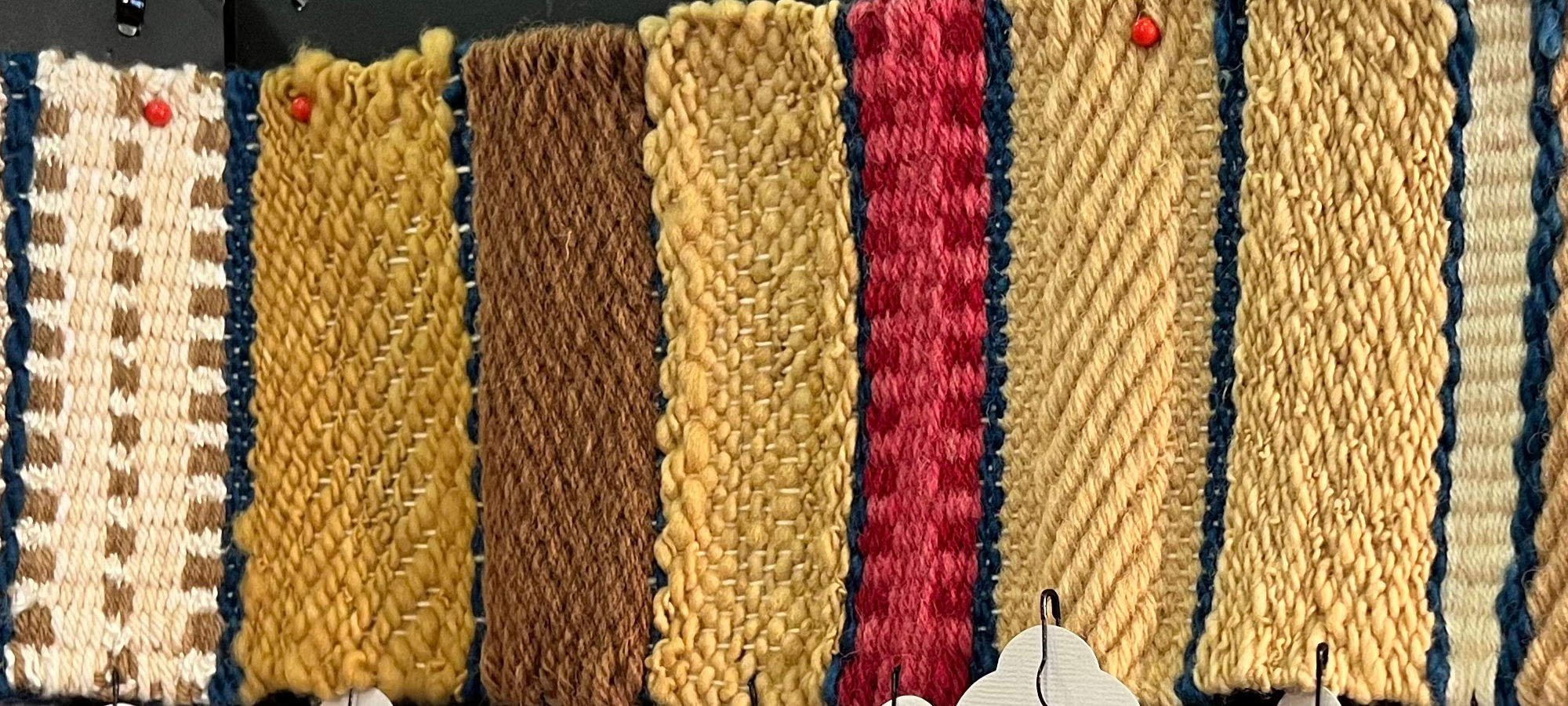
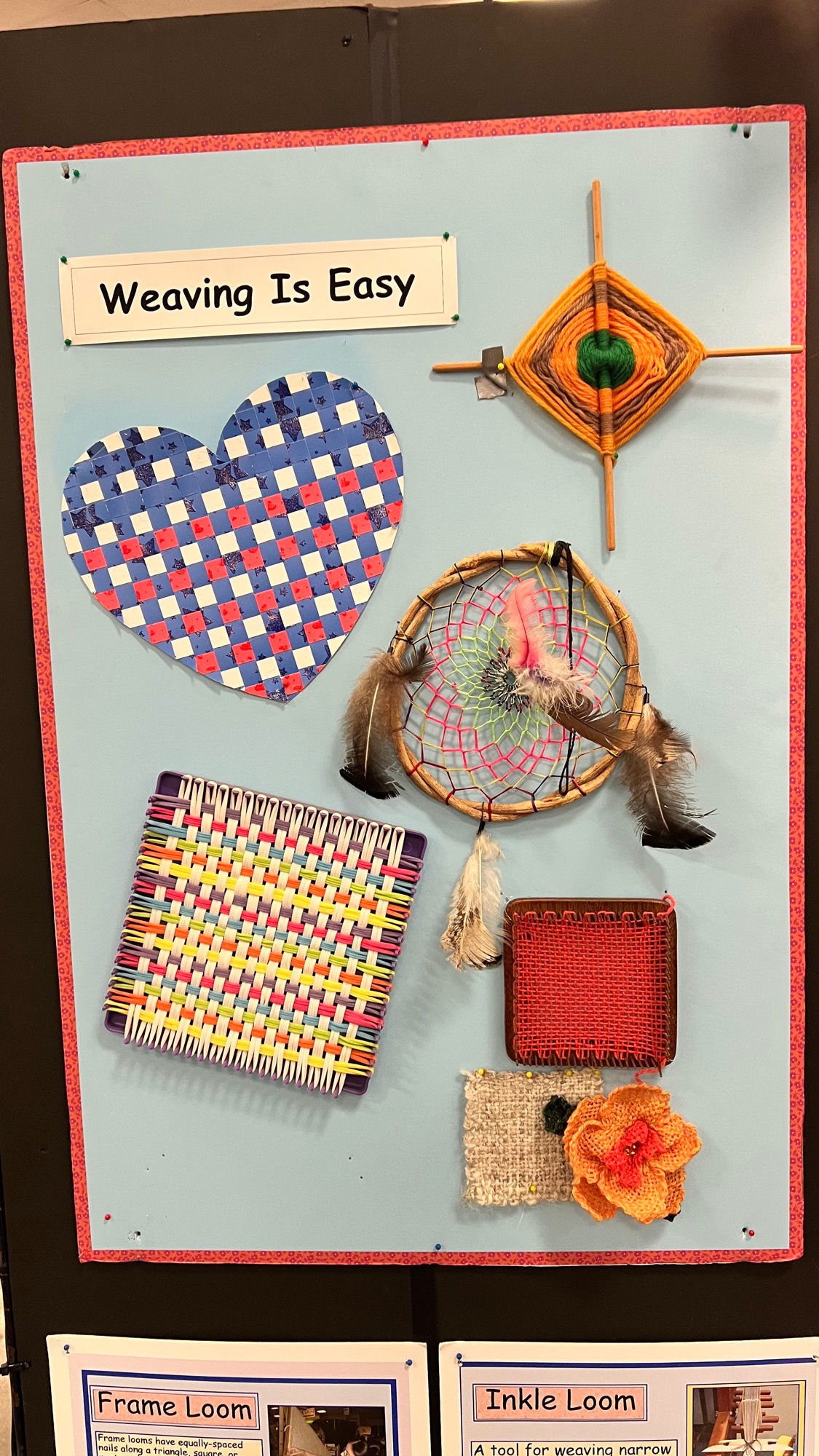
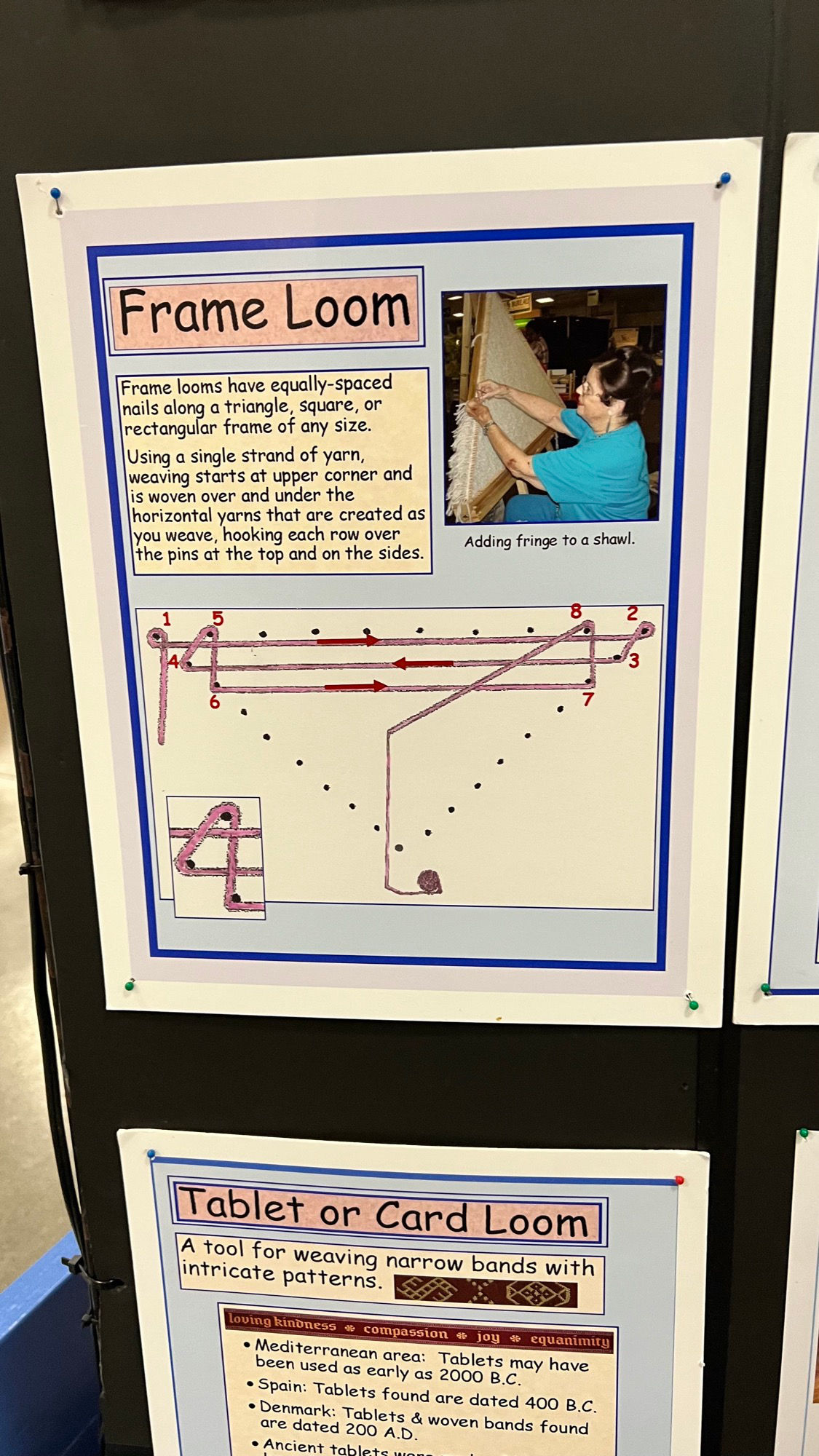
Frame looms have equally-spaced nails along a triangle, square or rectangular frame of any size.
Using a single strand of yarn, weaving starts at upper corner and is woven over and under the horizontal yarns that are created as you weave, hooking each row over the pins at the top and on the sides.
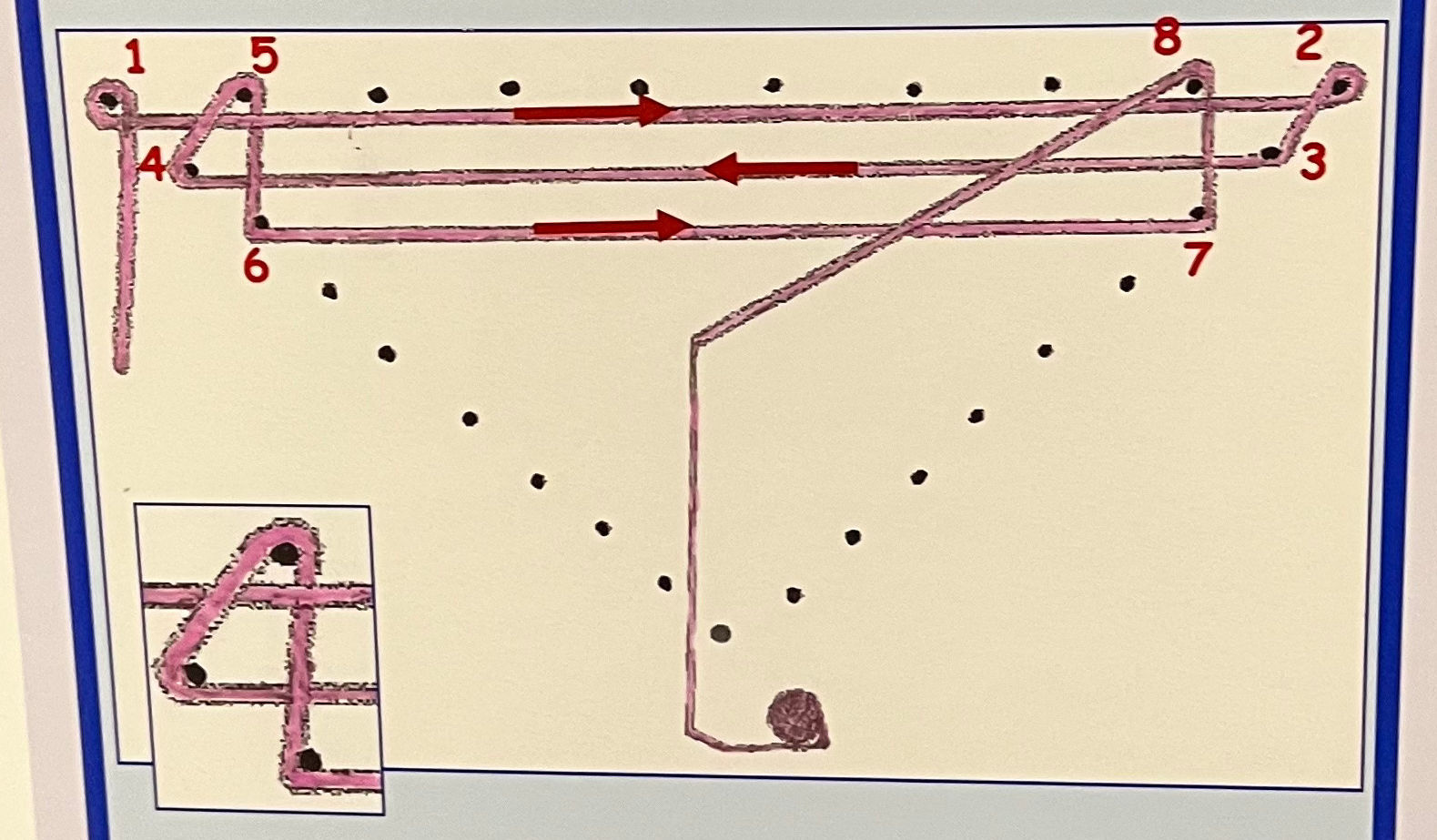
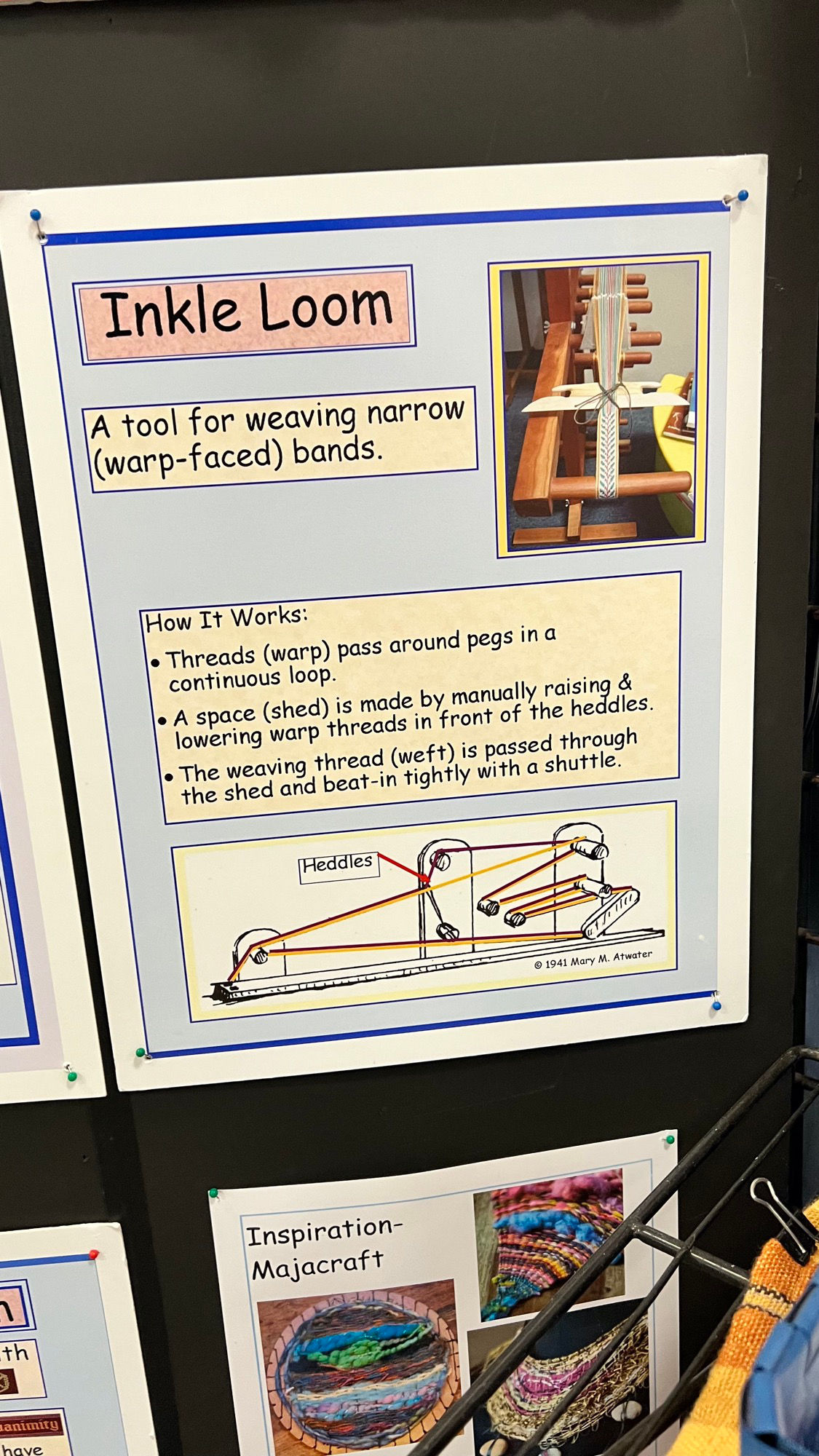
A tool for weaving narrow (warp-faced) bands.
How it Works
- Threads (warp) pass around pegs in a continuous loop.
- A space (shed) is made by manually raising & lowering warp threads in front of the heddles.
- The weaving thread (weft) is passed through the shed and beat-in tightly with a shuttle.
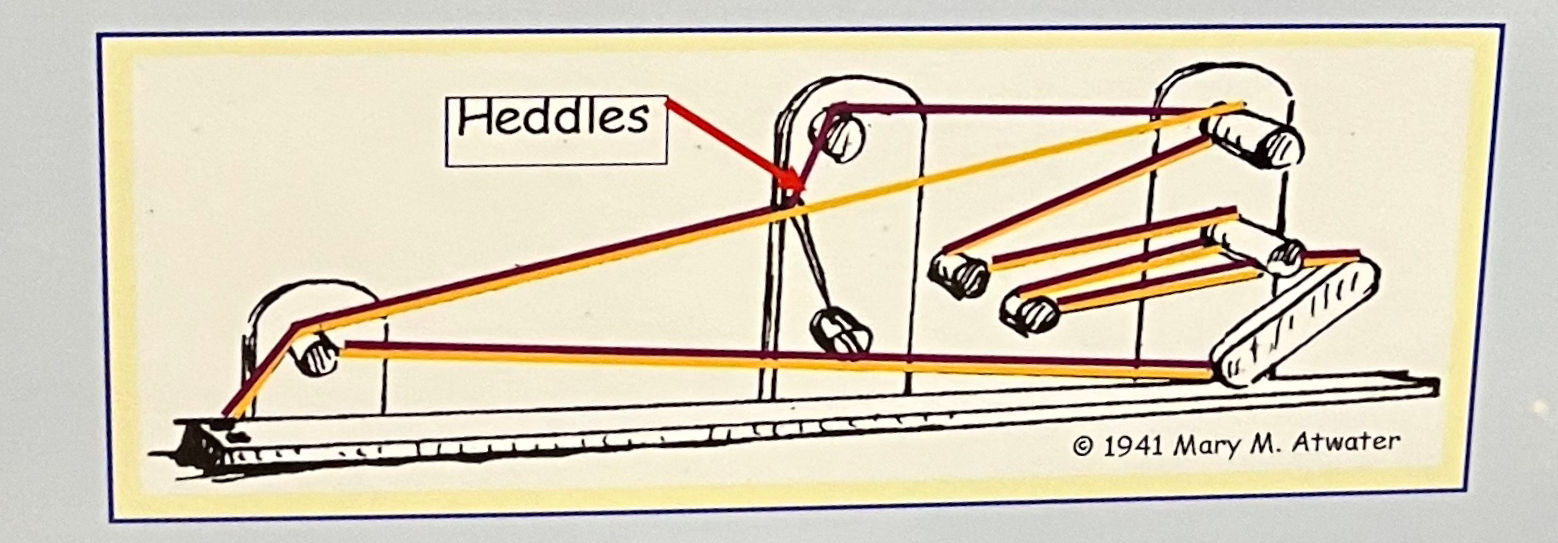
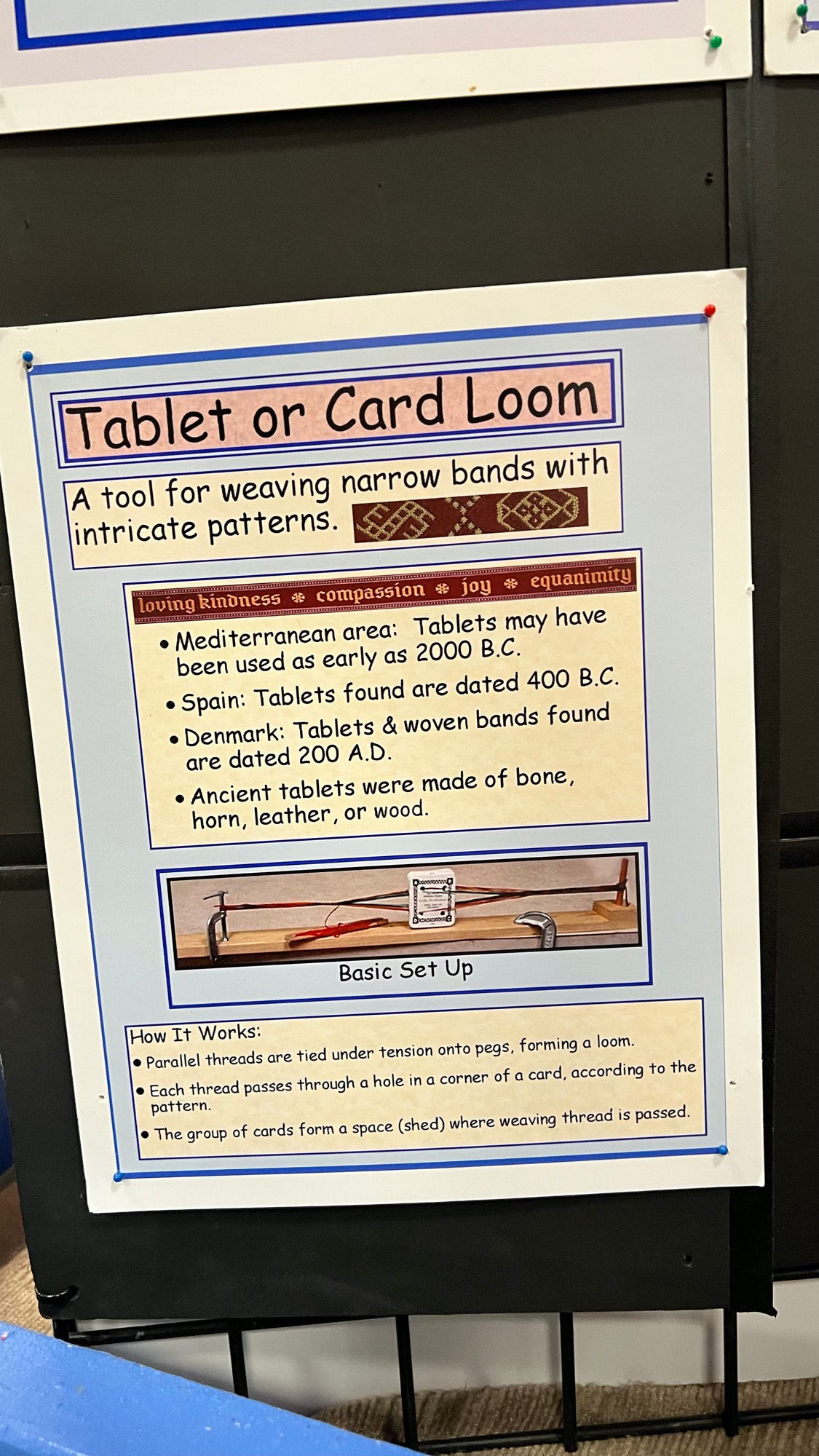
A tool for weaving narrow bands with intricate patterns
- Mediterranean area: Tablets may have been used as early as 2000 B.C.
- Spain: Tablets found are dated 400 B.C.
- Denmark: Tablets & woven bands found are dated 200 A.D.
- Ancient tablets were made of bone, horn, leather, or wood.

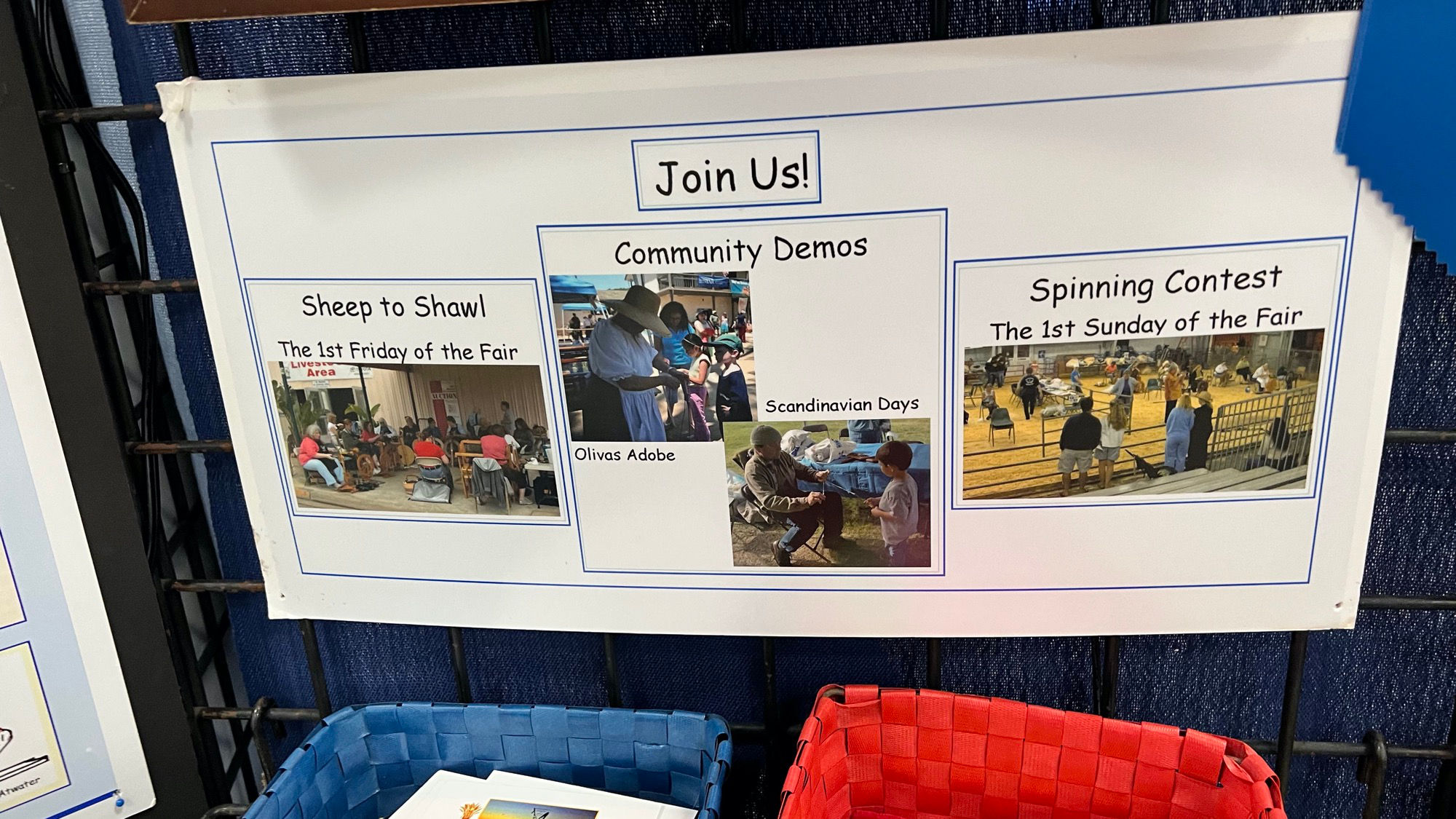
- Sheep to Shawl
- The first Friday of the Fair
- Community Demos
- Scandinavian Days
- Olivas Adobe
- Spinning ContestThe first Friday of the Fair
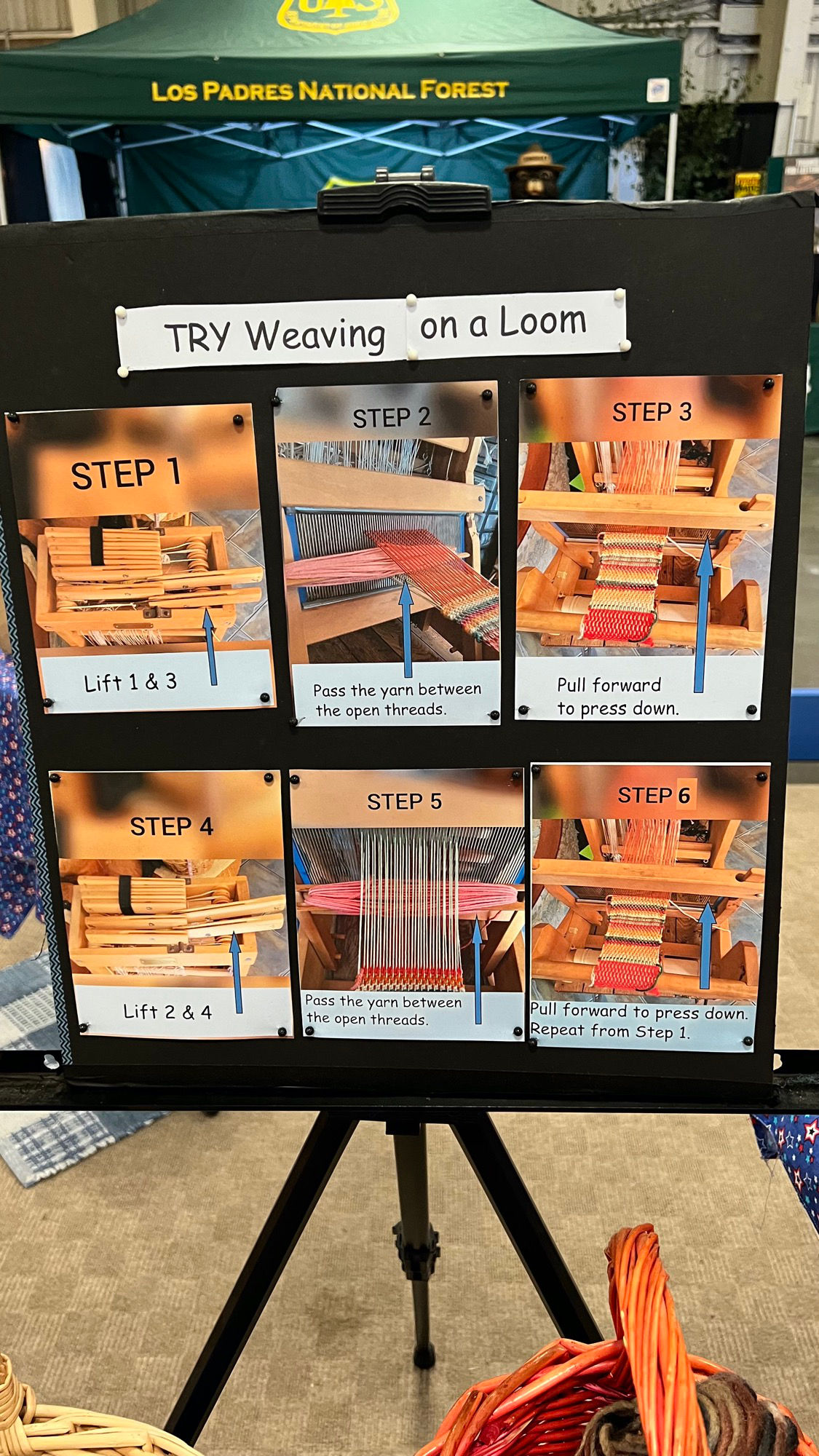
- Step 1 Lift 1 & 3
- Step 2 Pass the yarn between the open threads
- Step 3 Pull forward to press down
- Step 4 Lift 2 & 4
- Step 5 Pass the yarn between the open threads
- Step 6 Pull forward to press down. Repeat from Step 1
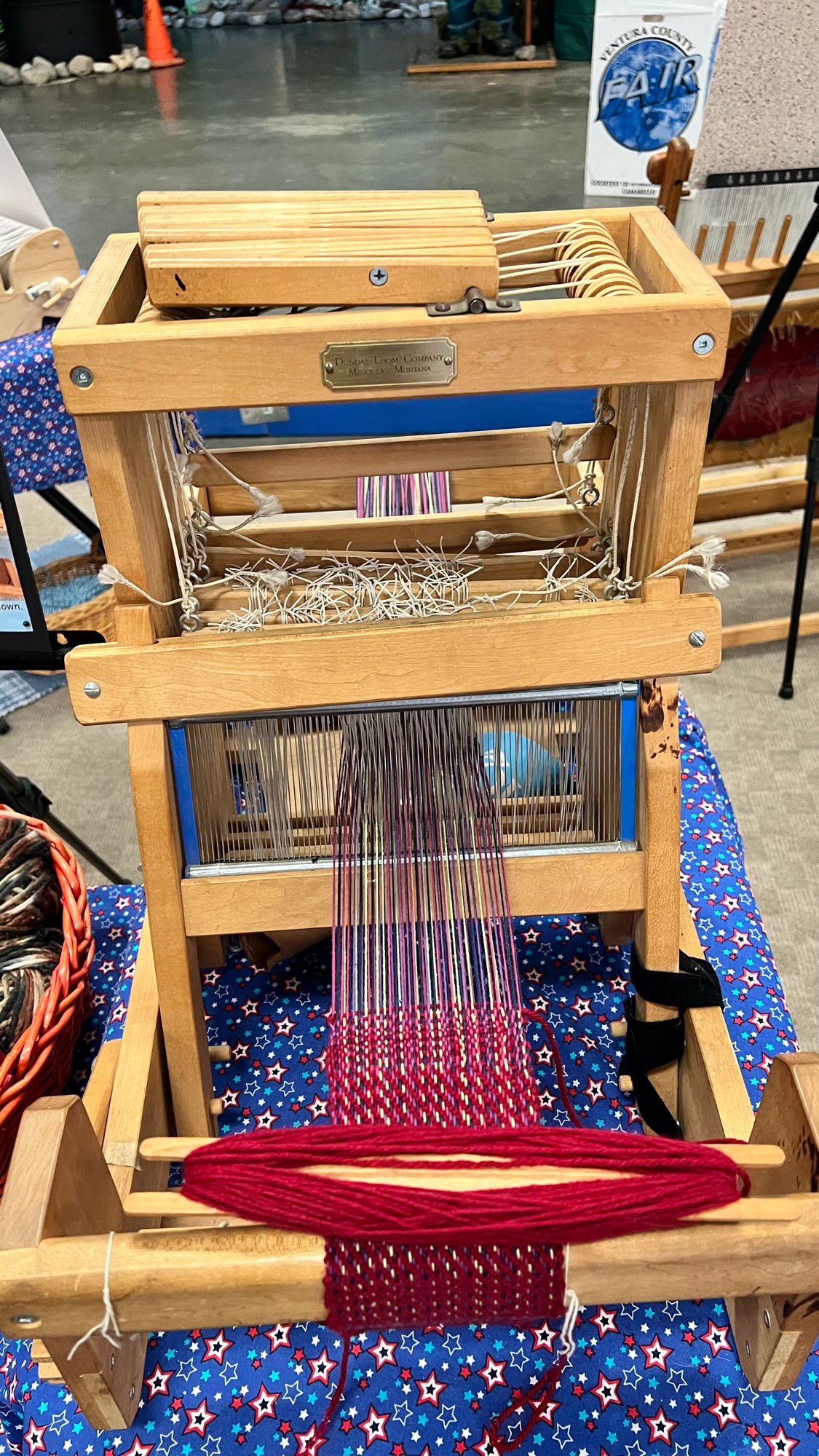
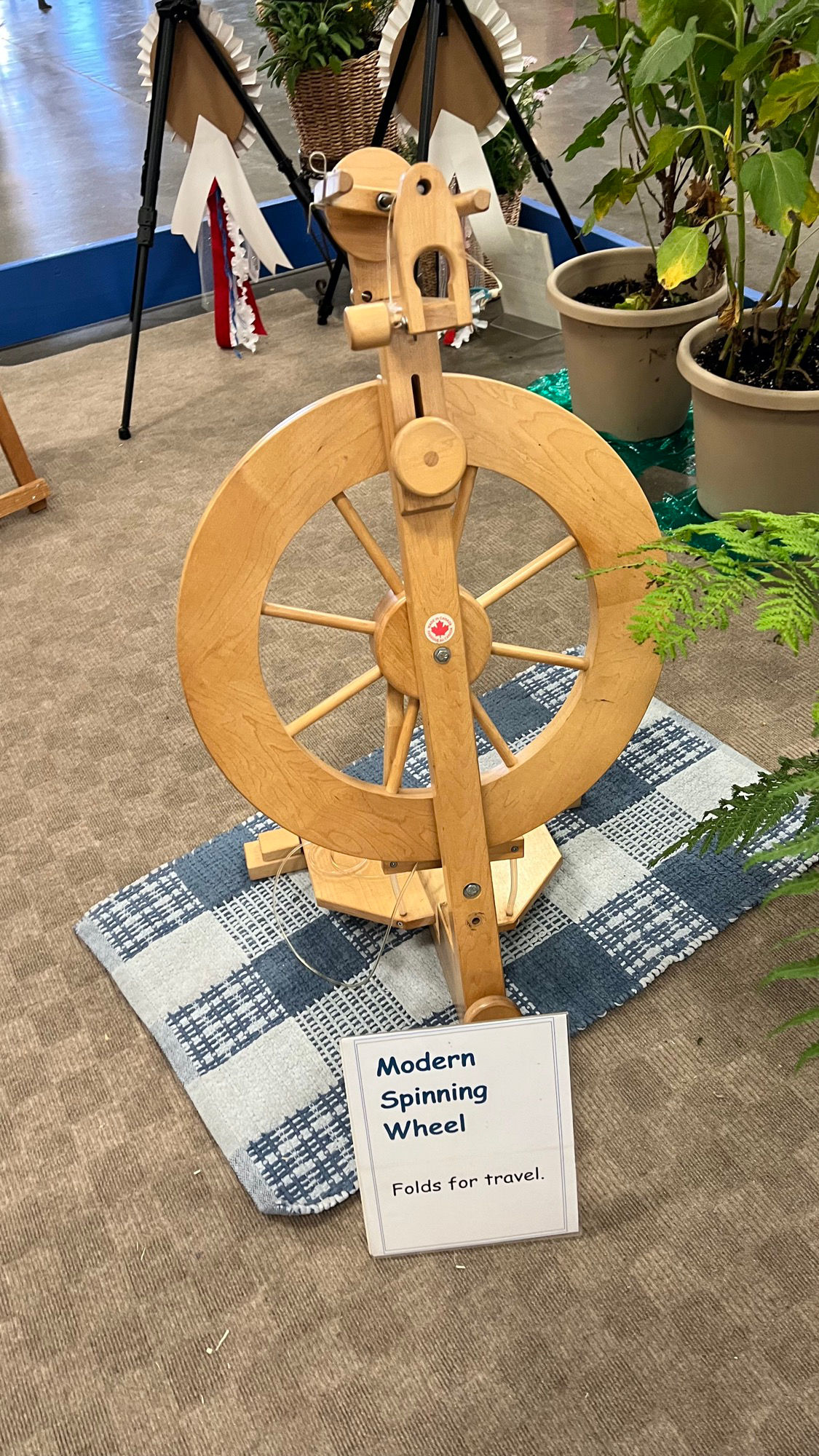
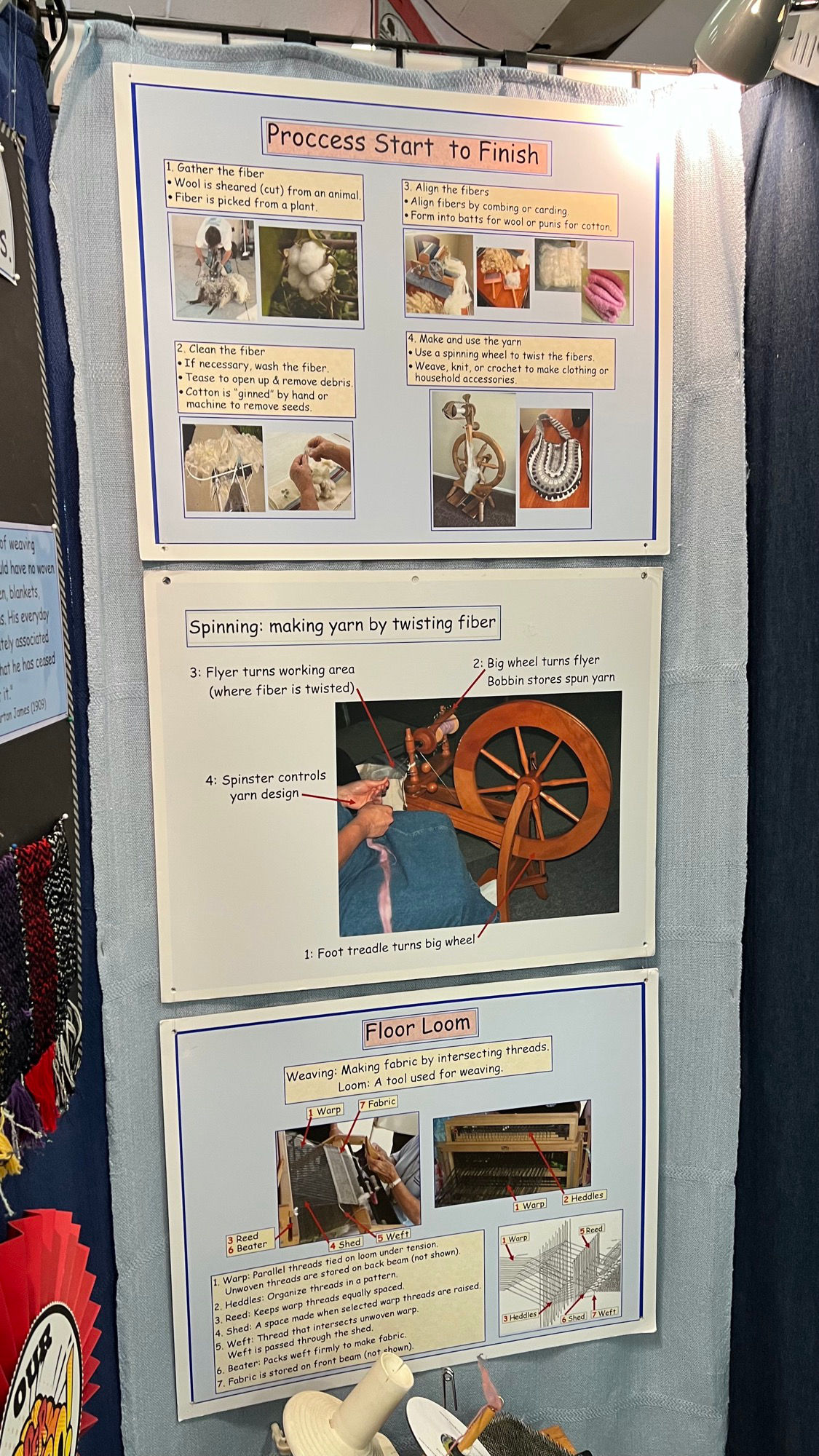
Process Start to Finish
- Gather the Fiber
- Wool is sheared (cut) from an animal
- Fiber is picked from a Plant
- Clean the Fiver
- If necessary, wash the fiber
- Tease to open up & remove debris
- Cotton is "ginned" by hand or machine to remove seeds
- Align the Fibers
- Align fibers by combing or carding
- Form into batts for wool or punis for cotton
- Make and use the yarn
- Use a spinning wheel to twist the fibers
- Weave, knit, or crochet to make clothing or household accessories
Spinning: - Making Yarn by Twisting Fiber
- Foot treadle turns big wheel
- Big wheel turns flyer
- Flyer turns working area (where fiber is twisted)
- Spinster controls yarn design
Weaving: - Making fabric by intersecting threads
Loom: - A tool used for weaving
Floor Loom
- Warp: Parallel threads tied on loom under tension. Unwoven threads are stored on back beam (not shown).
- Heddles: Organize threads in a pattern.
- Reed: Keeps warp threads equally spaced.
- Shed: A space made when selected warp threads are raised.
- Weft: Thread that intersects unwoven warp. Weft is passed through the shed.
- Beater: Packs weft firmly to make fabric.
- Fabric is stored on front beam (not shown).
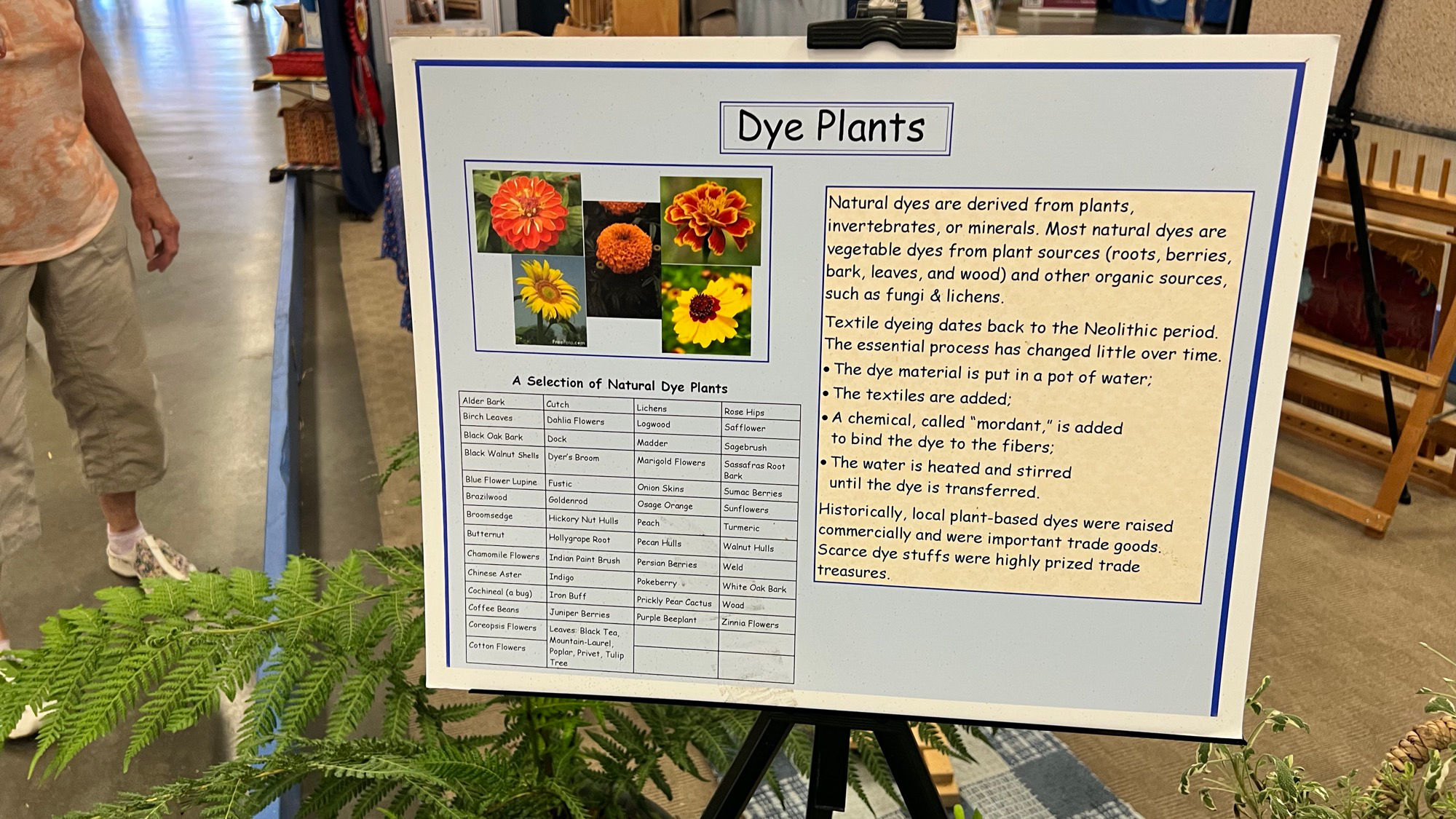
Natural dyes are derived from plants, invertebrates, or minerals. Most natural dyes are vegetable dyes from plant sources (roots, berries, bark, leaves, and wood) and other organic sources, such as fungi & lichens.
Textile dyeing dates back to the Neolithic period. The essential process has changed little over time.
- The dye material is put in a pot of water;
- The textiles are added:
- A chemical, called "mordant," is added to bind the dye to the fibers;
- The water is heated and stirred until the dye is transferred.
Historically, local plant-based dyes were raised commercially and were important trade goods Scarce dye stuffs were highly prized trade treasures.
A Selection of Natural Dye Plants
- Alder Bark
- Birch Leaves
- Black Oak Bark
- Black Walnut Shells
- Blue Flower Lupine
- Brazilwood
- Broomsedge
- Butternut
- Chamomile Flowers
- Chinese Aster
- Cochineal (a bug)
- Coffee Beans
- Coreopsis Flowers
- Cotton Flowers
- Cutch
- Dahlia Flowers
- Dock
- Dyer's Broom
- Fustic
- Goldenrod
- Hickory Nut Hulls
- Hollygrape Root
- Indian Paint Brush
- Indigo
- Iron Buff
- Juniper Berries
- Leaves: Black Tea
- Mountain-Laurel,
- Poplar, Privet, Tulip
- Tree
- Lichens
- Logwood
- Madder
- Marigold Flowers
- Onion Skins
- Osage Orange
- Peach
- Pecan Hulls
- Persian Berries
- Pokeberry
- Prickly Pear Cactus
- Purple Beeplant
- Rose Hips
- Safflower
- Sagebrush
- Sassafras Root
- Bark
- Sumac Berries
- Sunflowers
- Turmeric
- Walnut Hulls
- Weld
- White Oak Bark
- Woad
- Zinnia Flowers
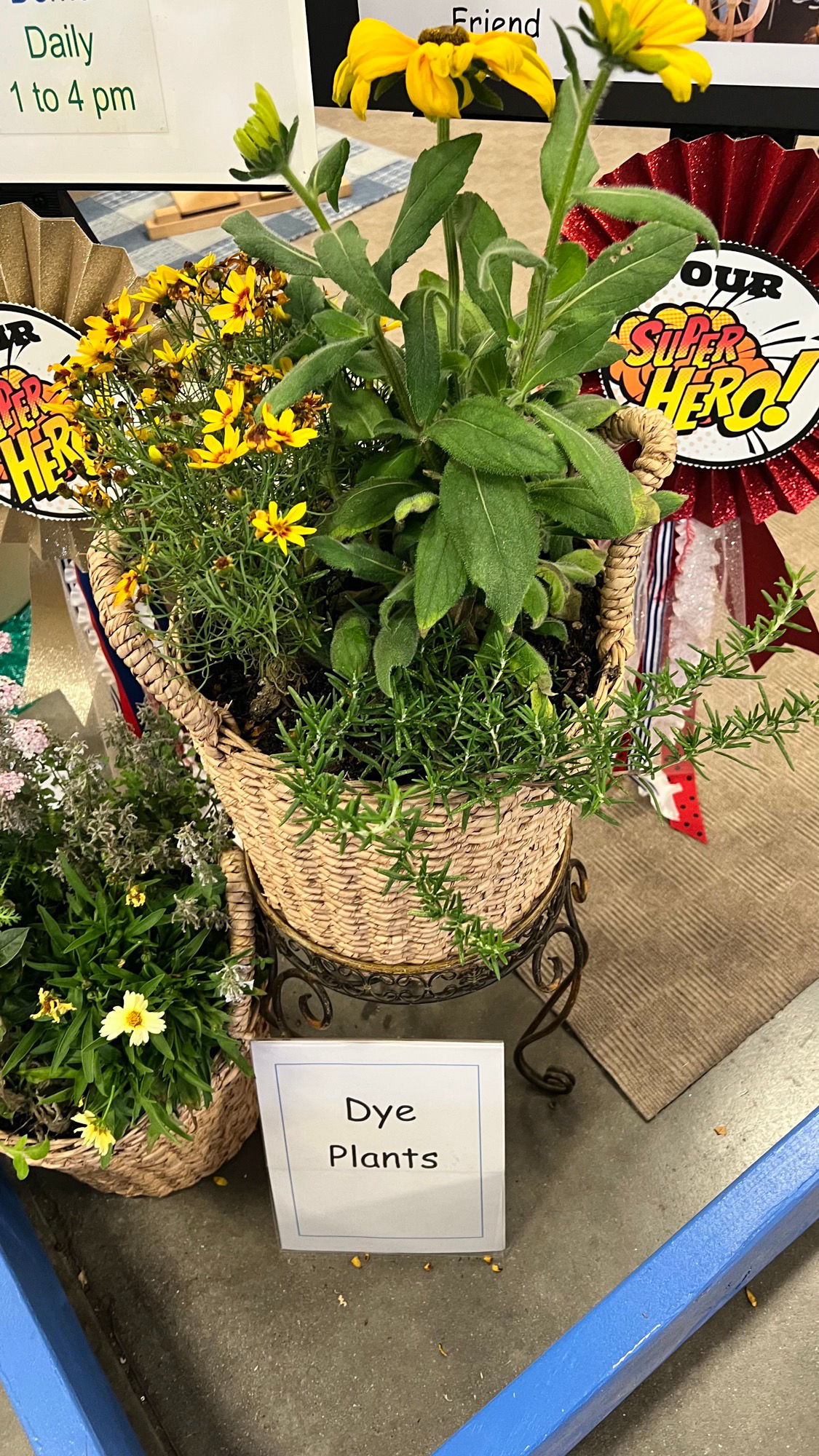
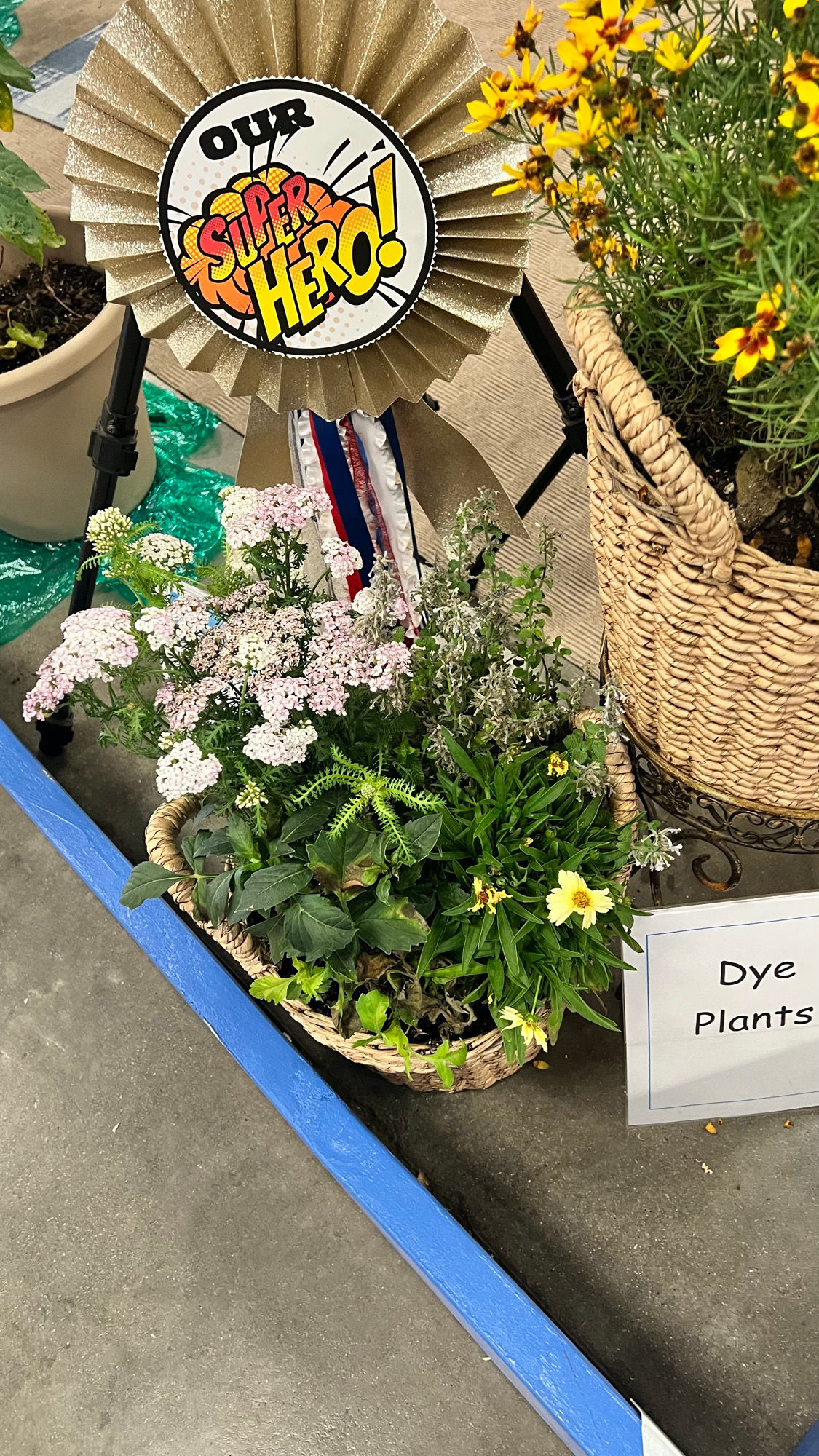
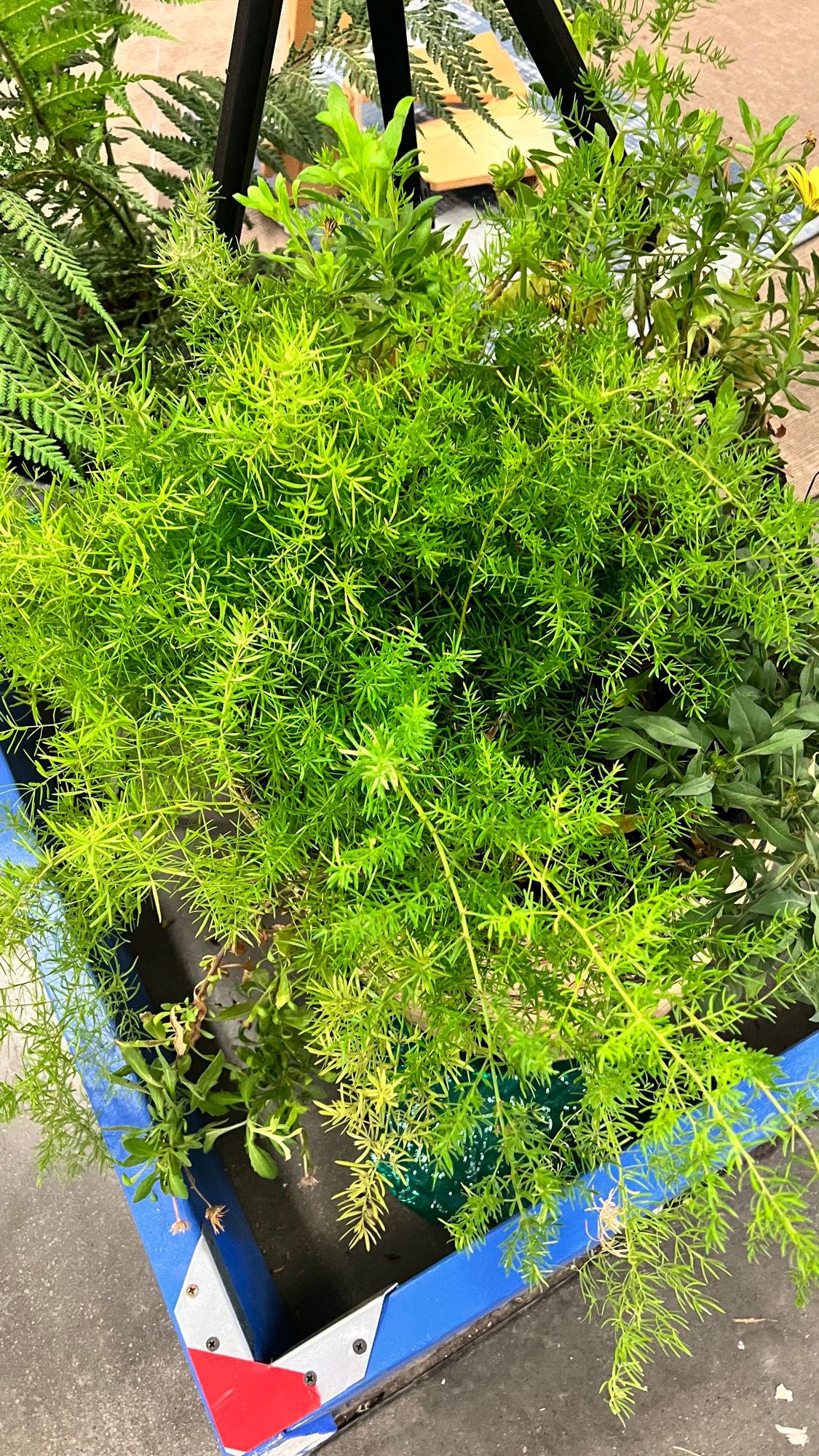
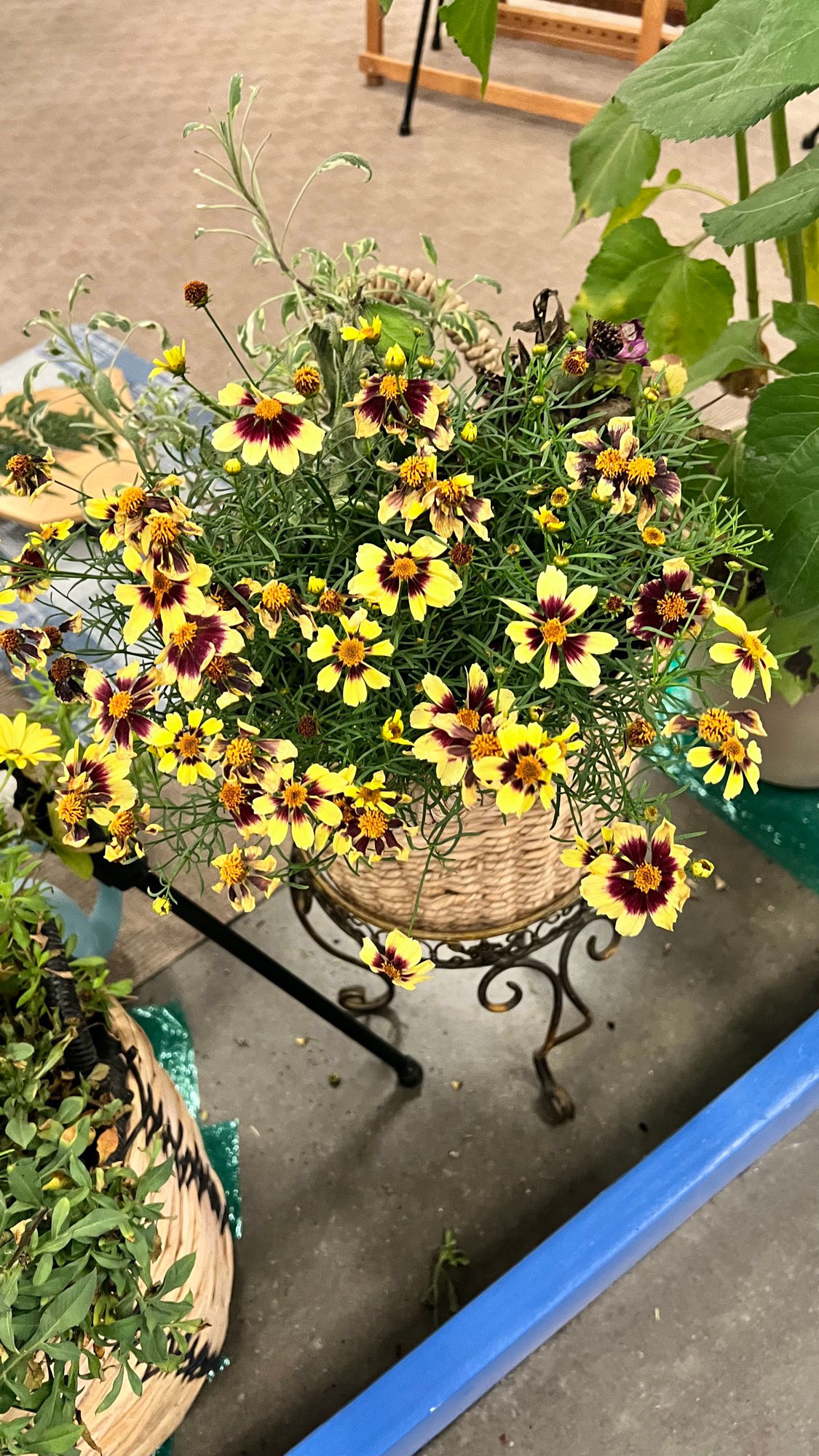
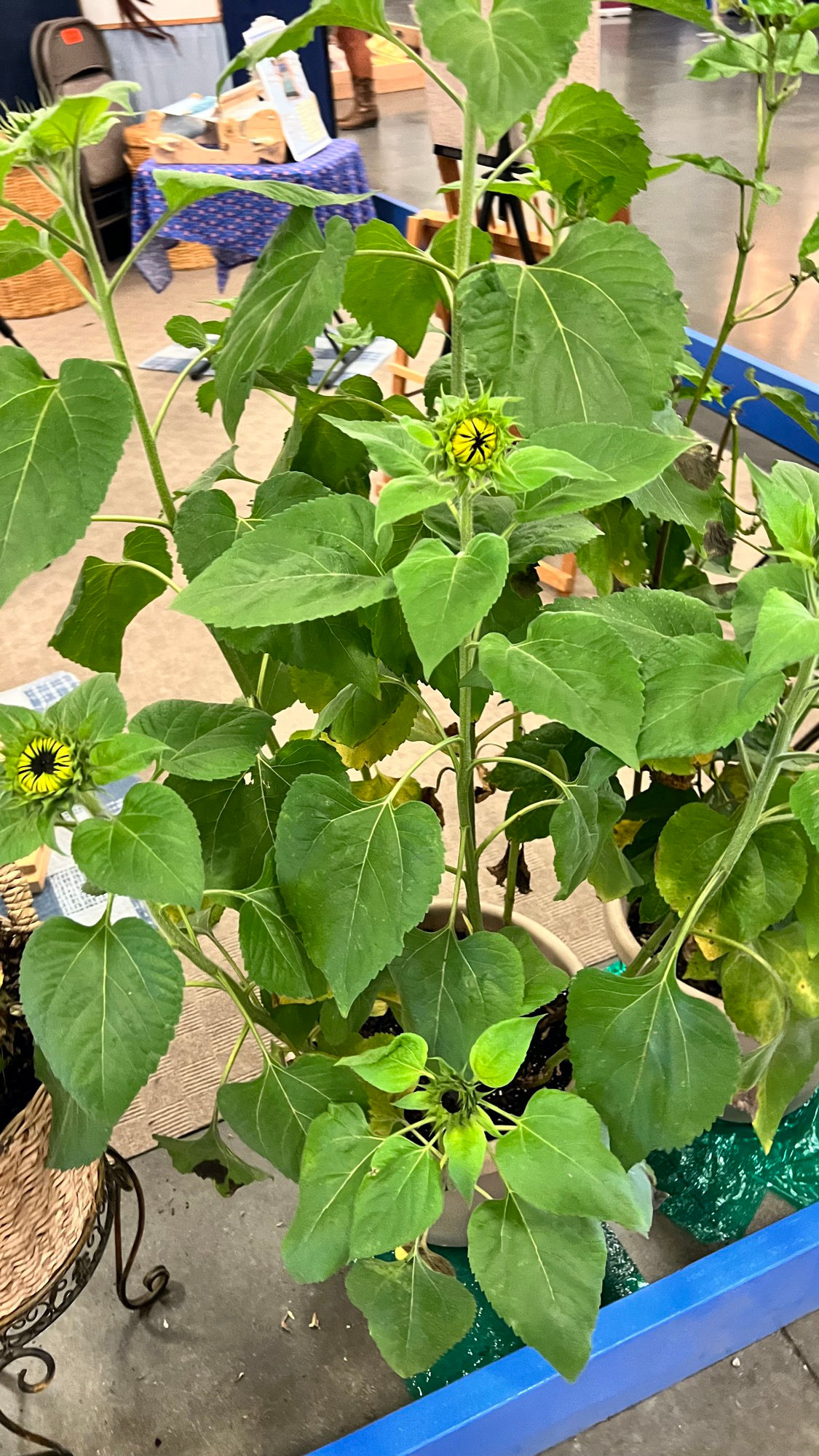
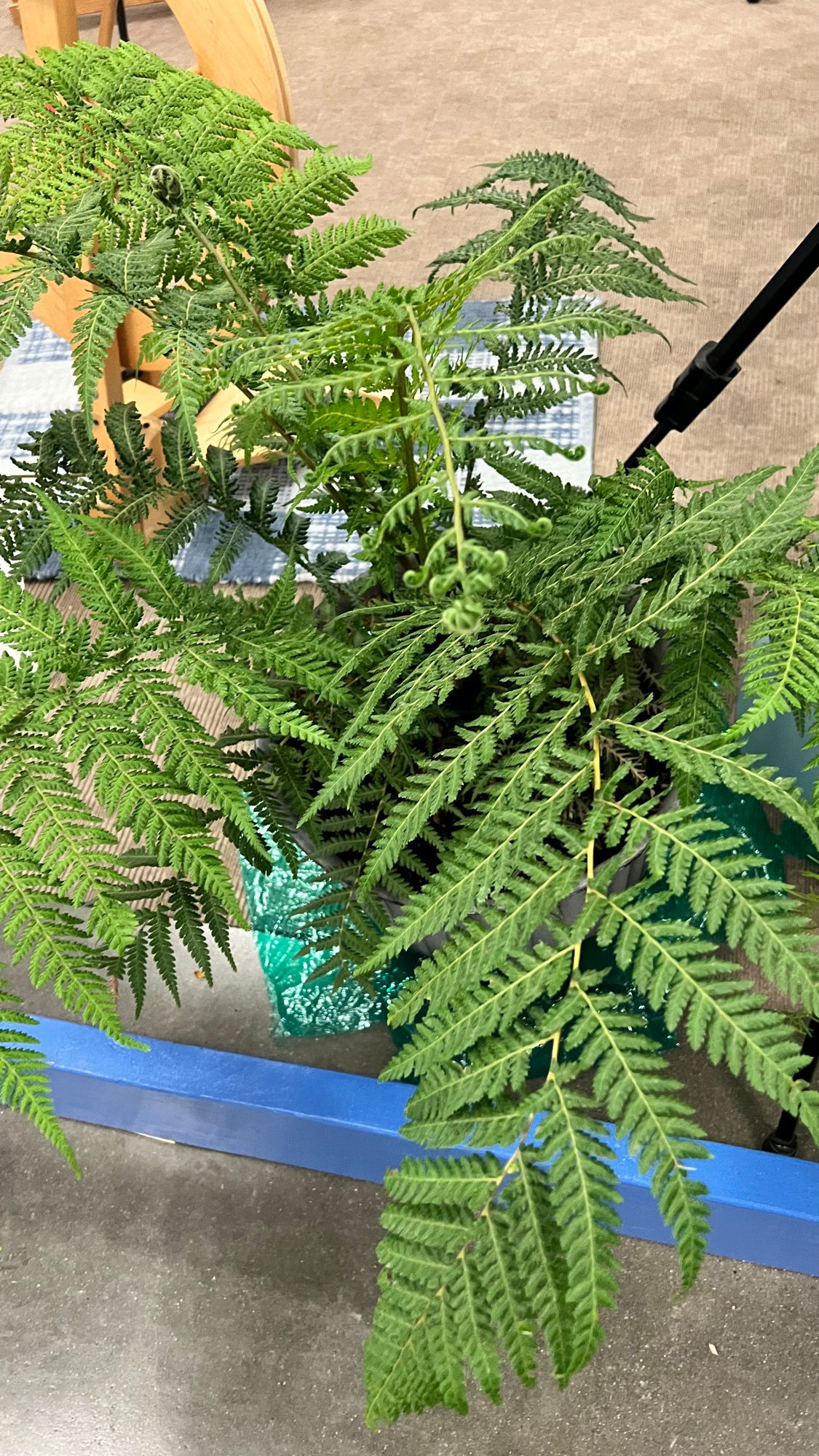
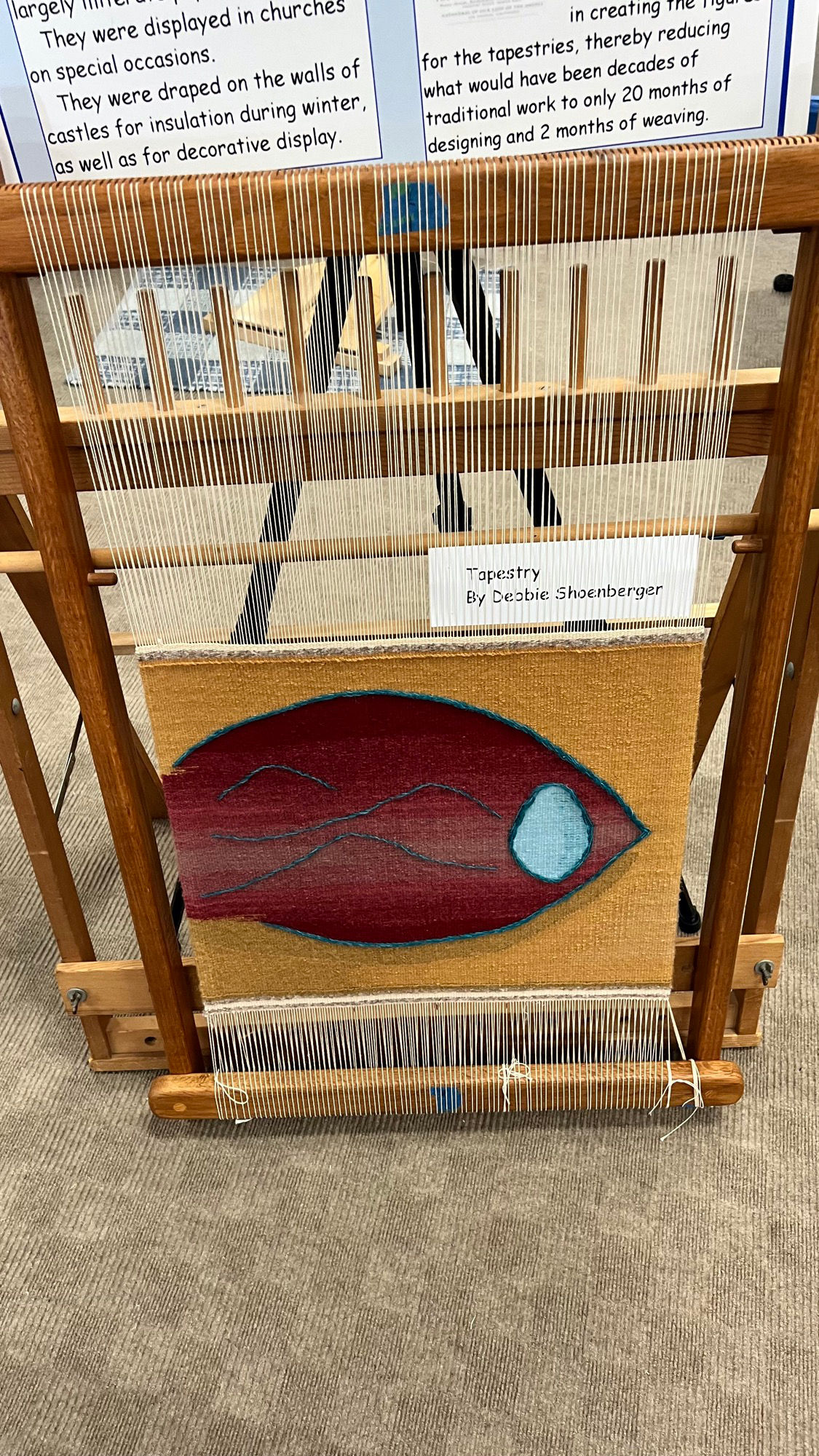
By Debbie Shoenberger
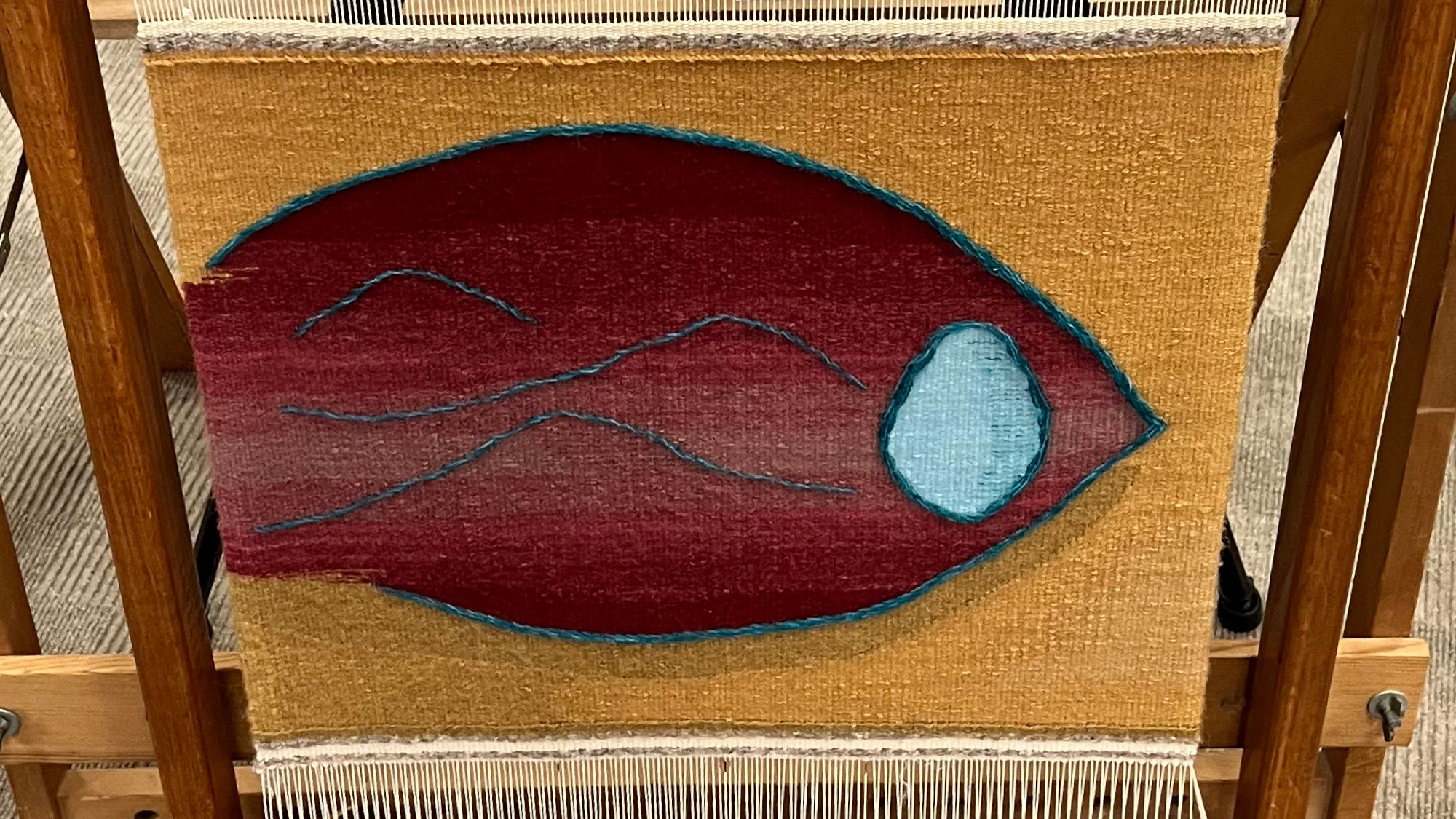
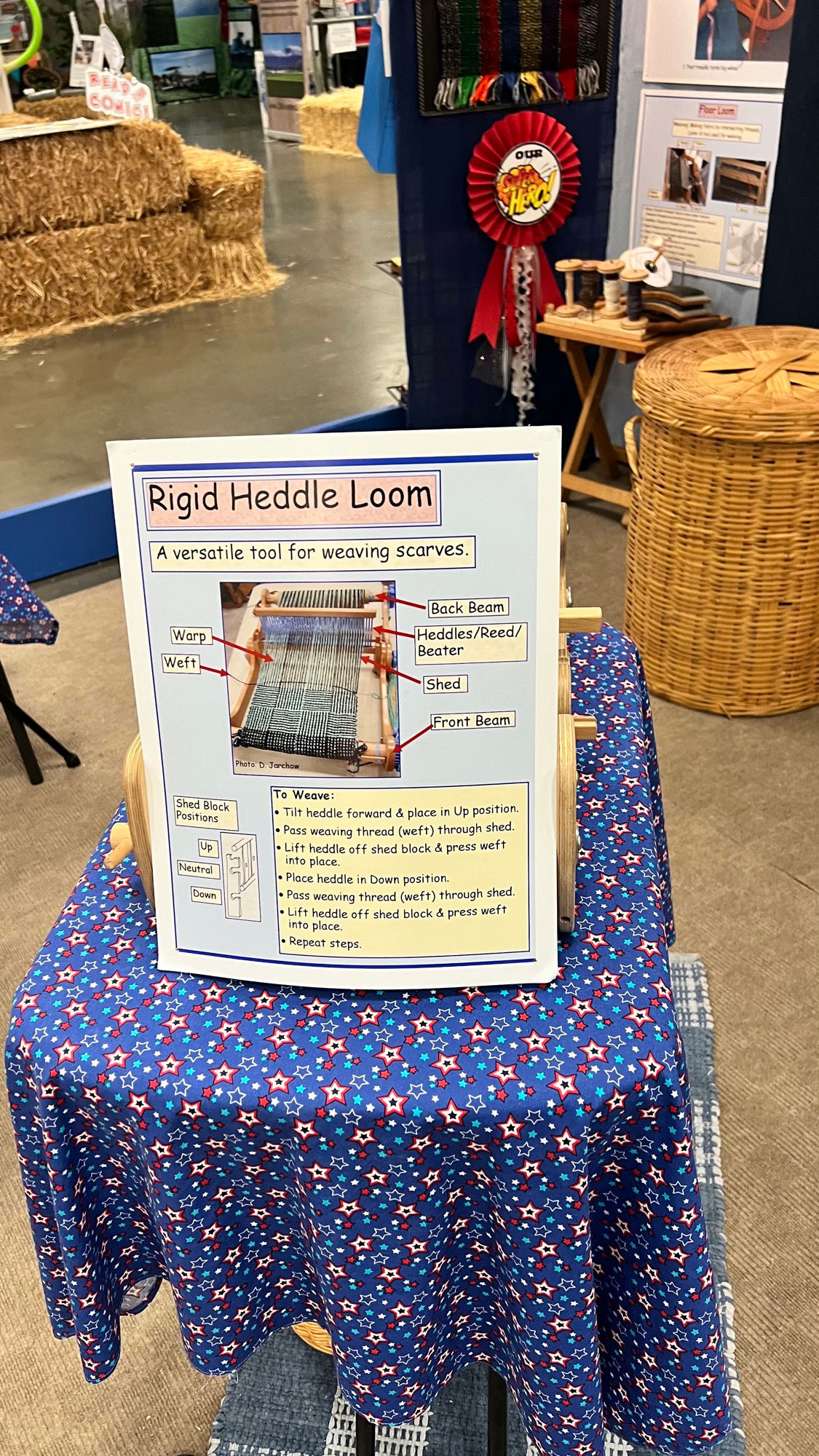
A versatile tool for weaving scarves
To Weave:
- Tilt heddle forward & place in Up position.
- Pass weaving thread (weft) through shed.
- Lift heddle off shed block & press weft into place.
- Place heddle in Down position.
- Pass weaving thread (weft) through shed.
- Lift heddle off shed block & press weft into place.
- Repeat steps.
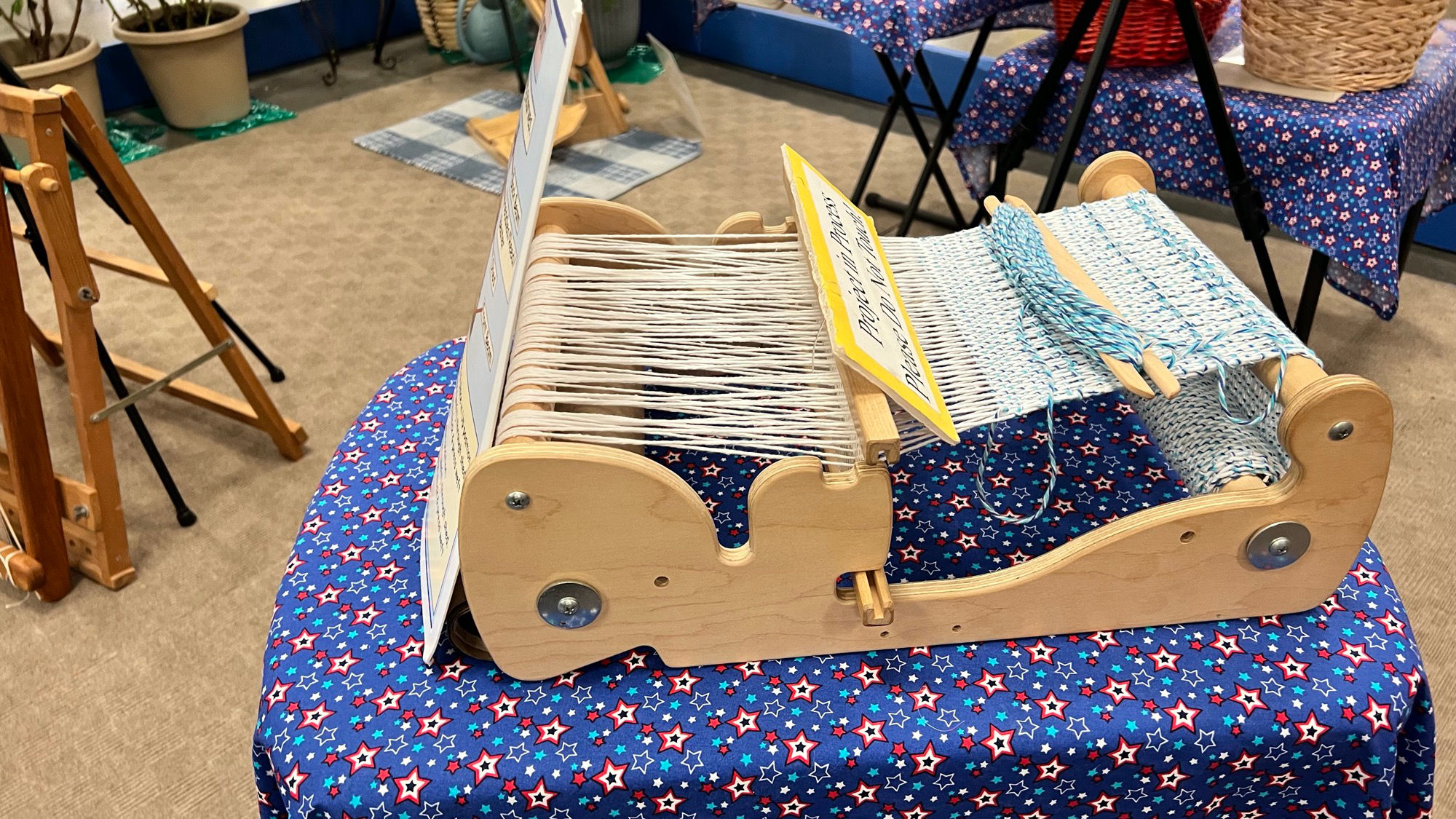
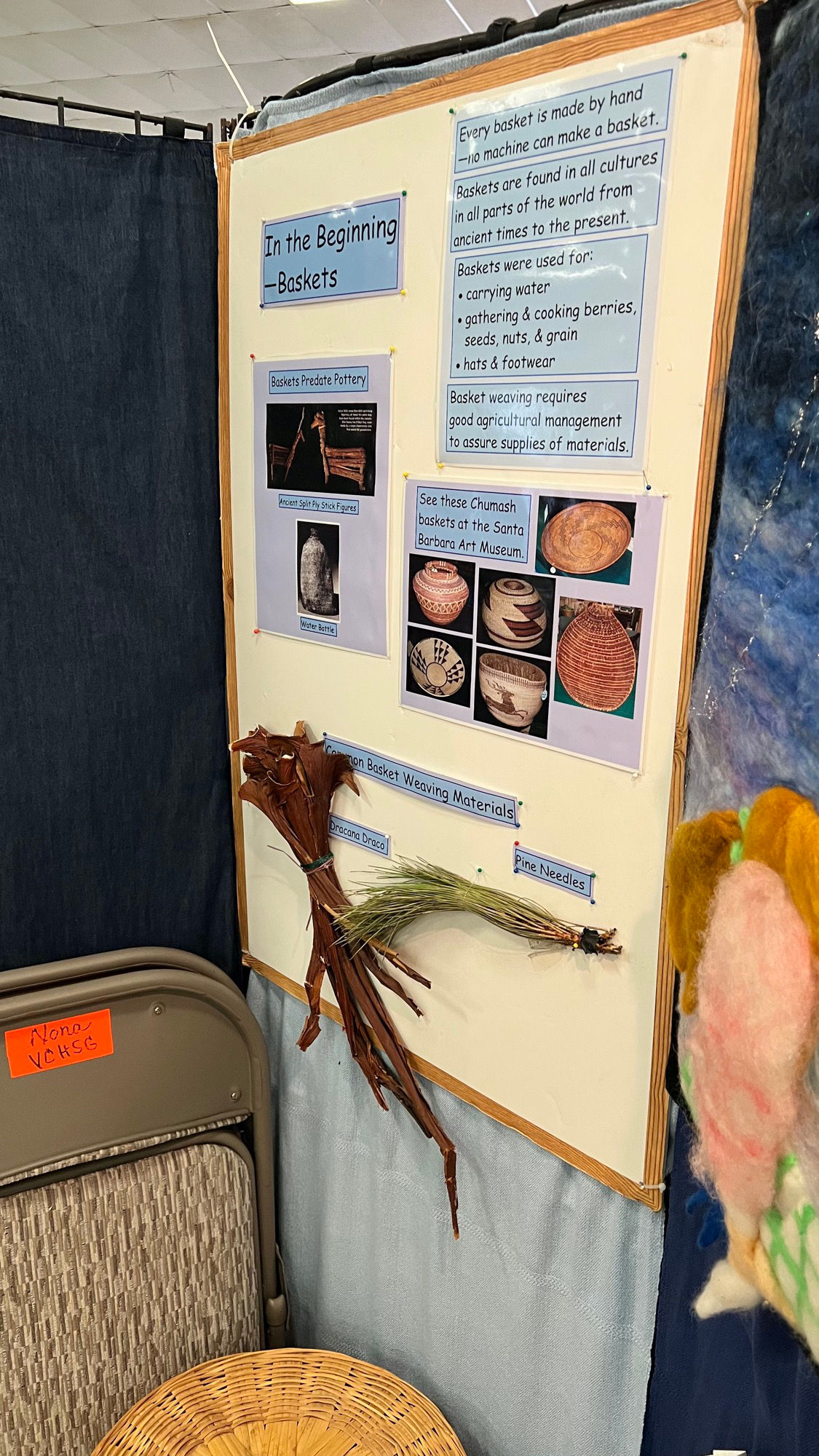
- Baskets Predate Pottery
- Ancient Split Ply Stick Figures
- Water Bottle
Basket Facts
- Every Basket is made by hand - no machine can make a basket.
- Baskets are found in all cultures in all parts of the world from ancient times to the present.
- Baskets were used for:
- Carrying Water
- Gathering & Cooking Berries, Seeds, Nuts, & Grain
- Hats & Footwear
- Basket Weaving requires good agricultural management to assure supplies of materials
Chumash Indians
See these Chumash baskets at the Santa Barbara Art Museum
Common Basket Weaving Materials
- Dracana Draco
- Pine Needles
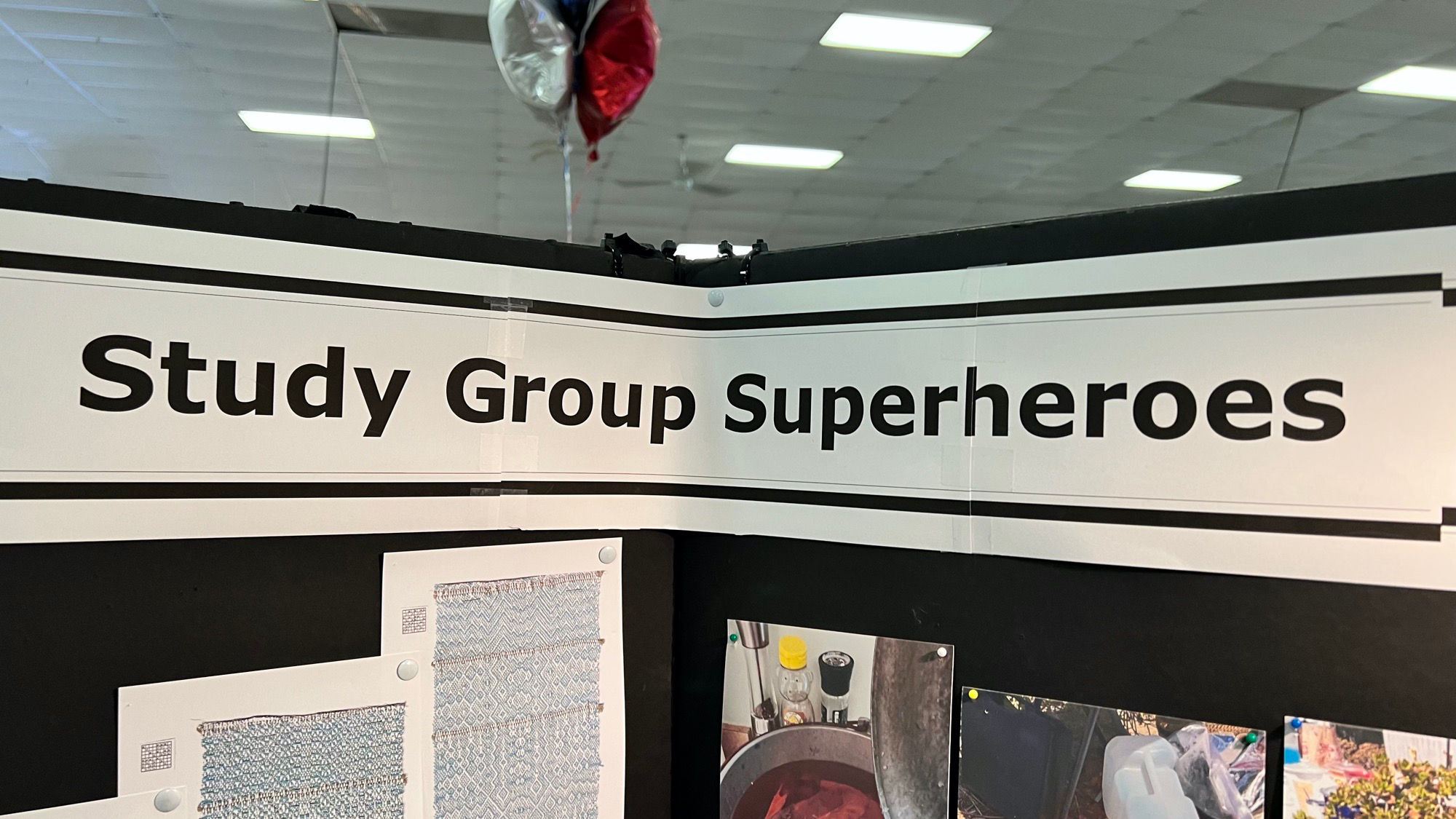
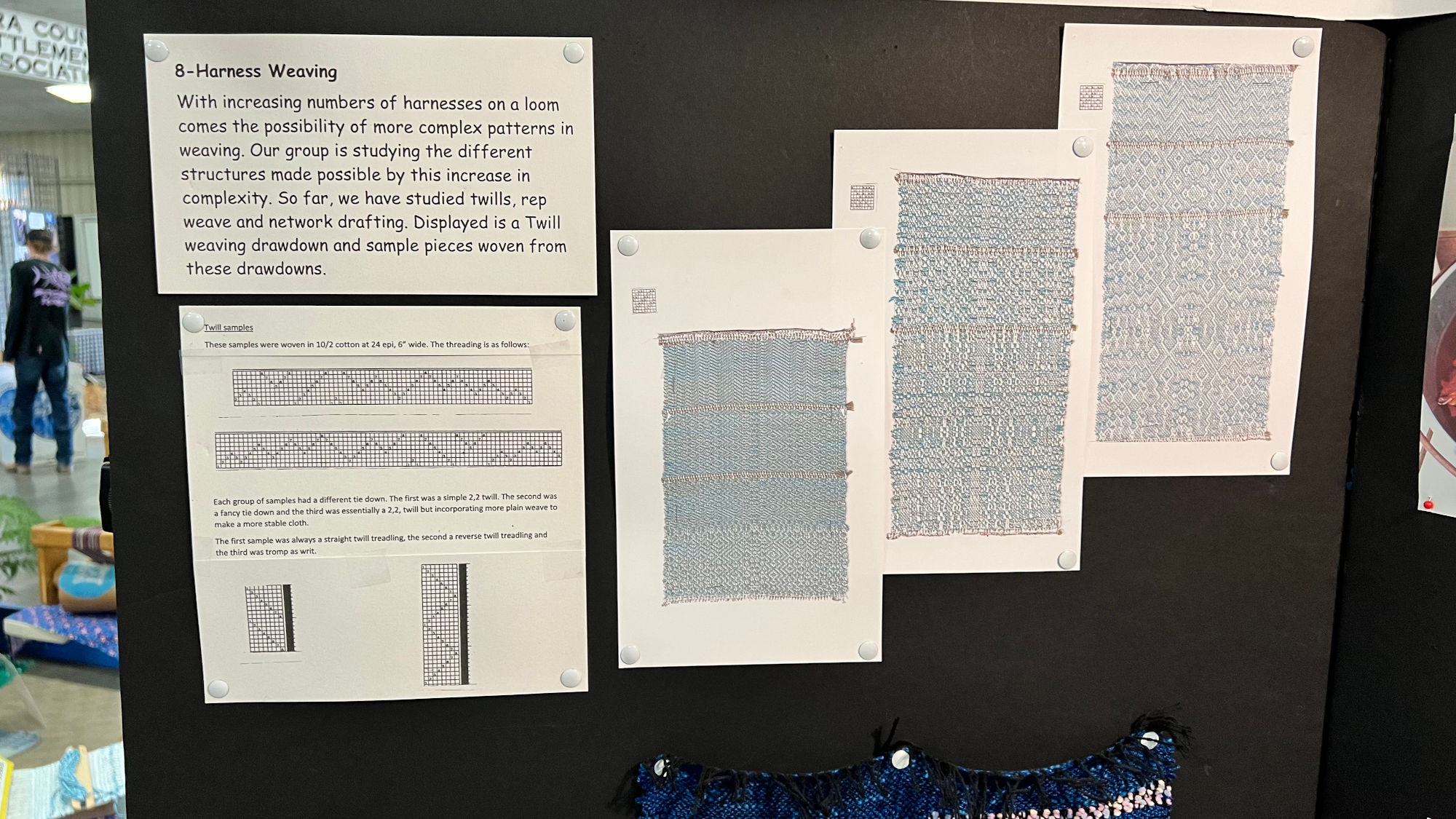
With increasing numbers of harnesses on a loom comes the possibility of more complex patterns in weaving. Our group is studying the different structures made possible by this increase in complexity. So far, we have studied twills, rep weave and network drafting. Displayed is a Twill weaving drawdown and sample pieces woven from these drawdowns.
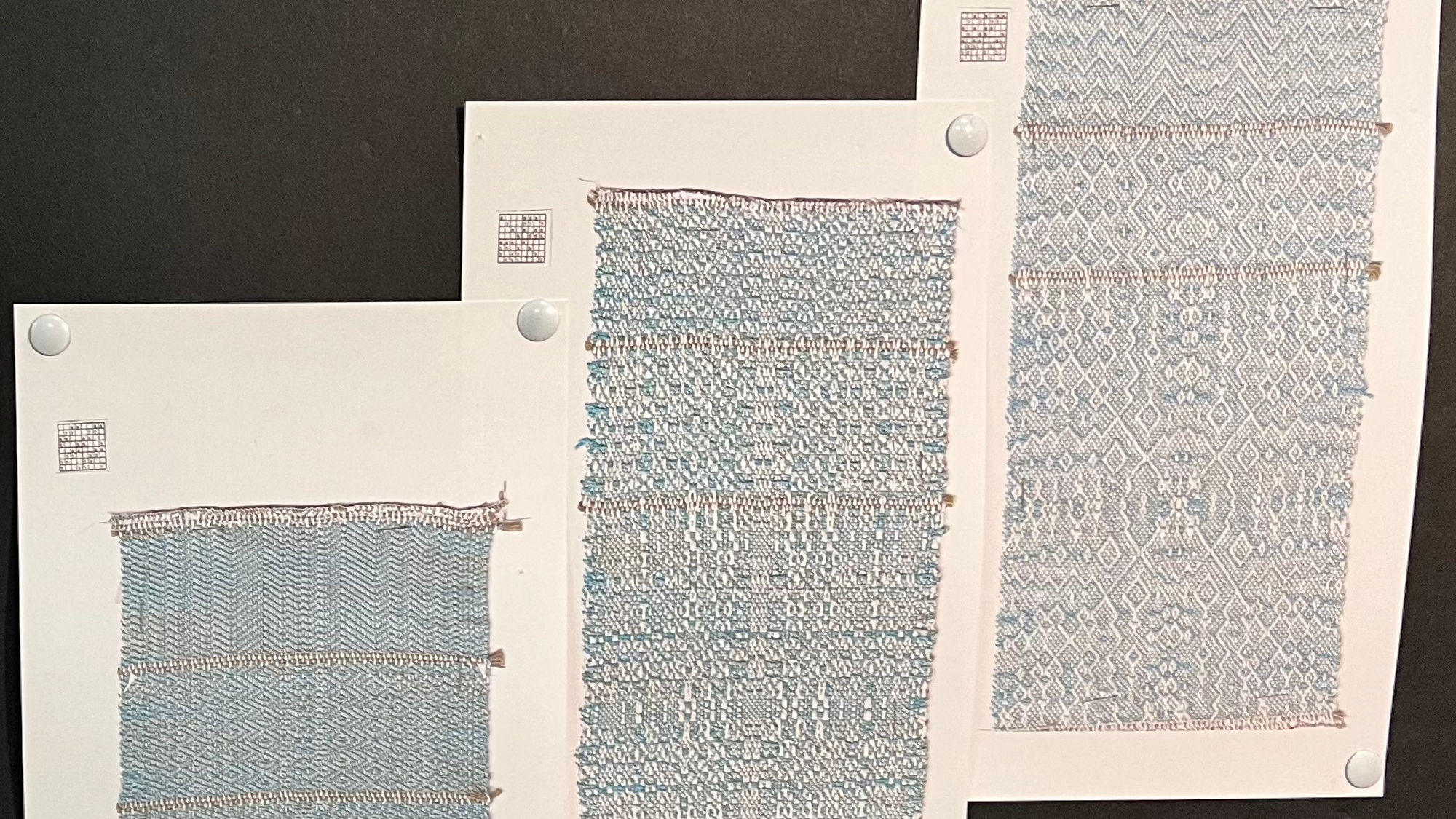
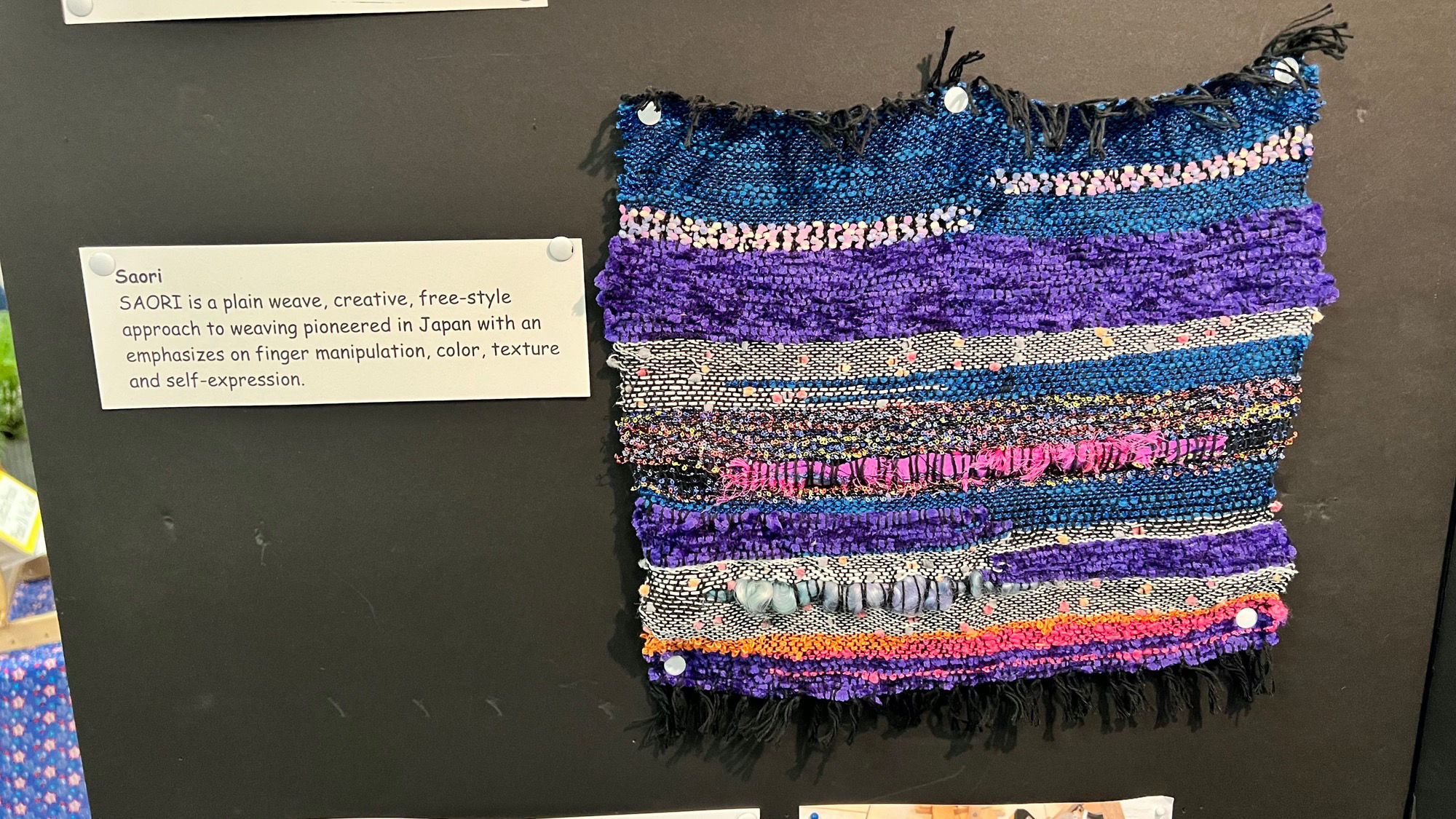
SAORI is a plain weave, creative, free-style approach to weaving pioneered in Japan with an emphasizes on finger manipulation, color, texture and self-expression.
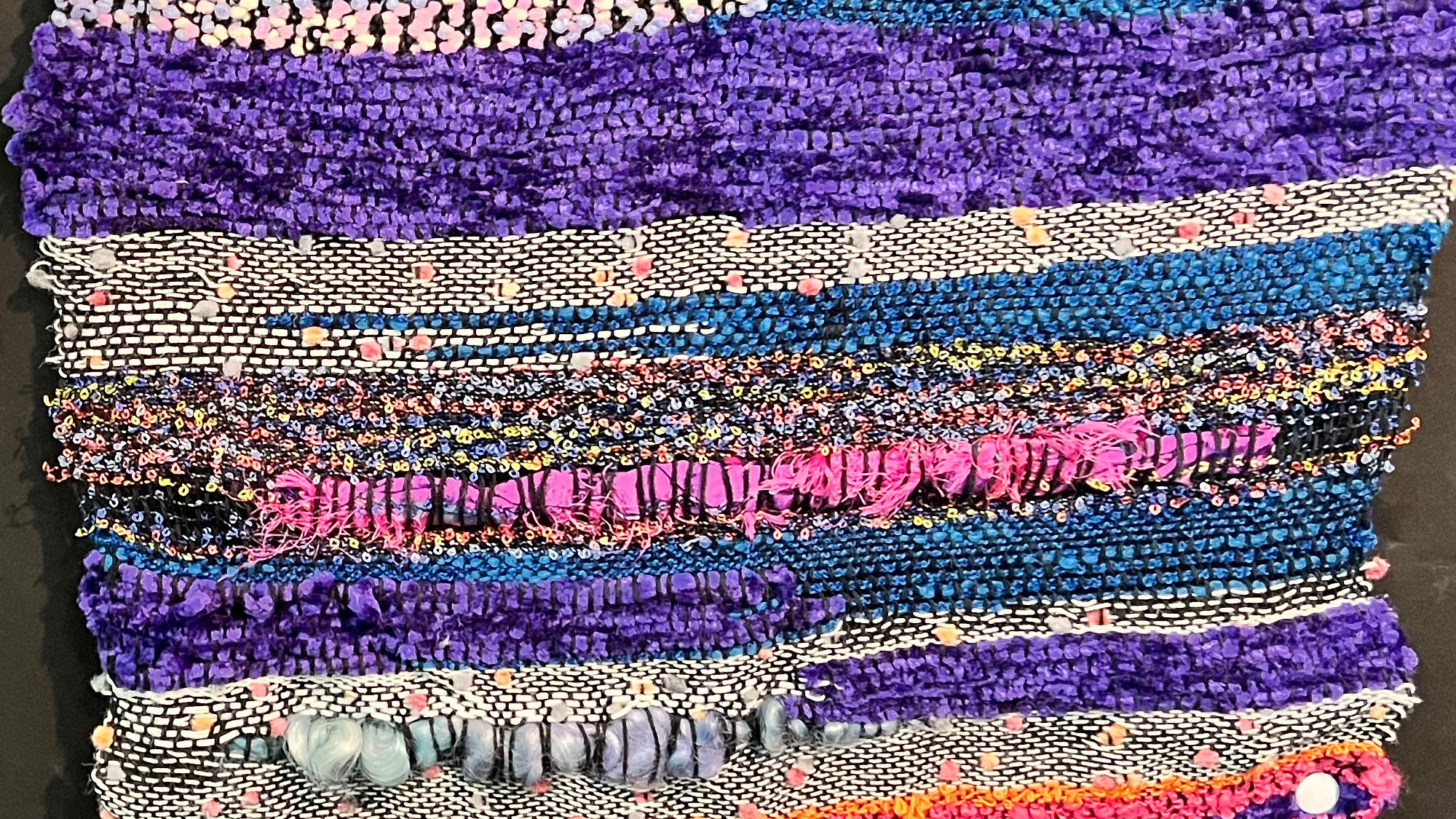
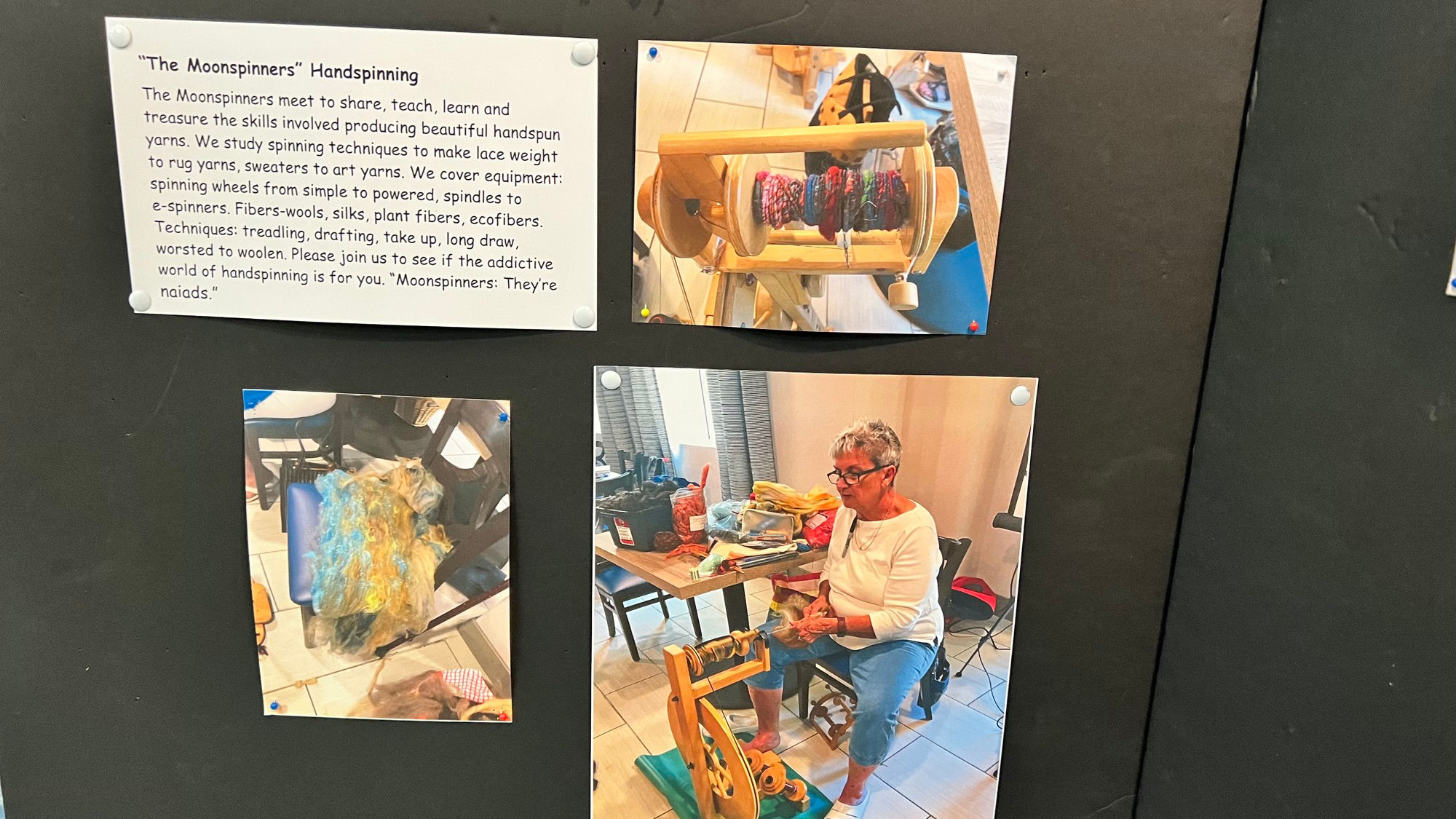
The Moonspinners meet to share, teach, learn and treasure the skills involved producing beautiful handspun yarns. We study spinning techniques to make lace weight to rug yarns, sweaters to art yarns.
We cover equipment: spinning wheels from simple to powered, spindles to e-spinners. Fibers-wools, silks, plant fibers, ecofibers. Techniques: treadling, drafting, take up, long draw worsted to woolen.
Please join us to see if the addictive world of handspinning is for you. "Moonspinners: They're naiads."
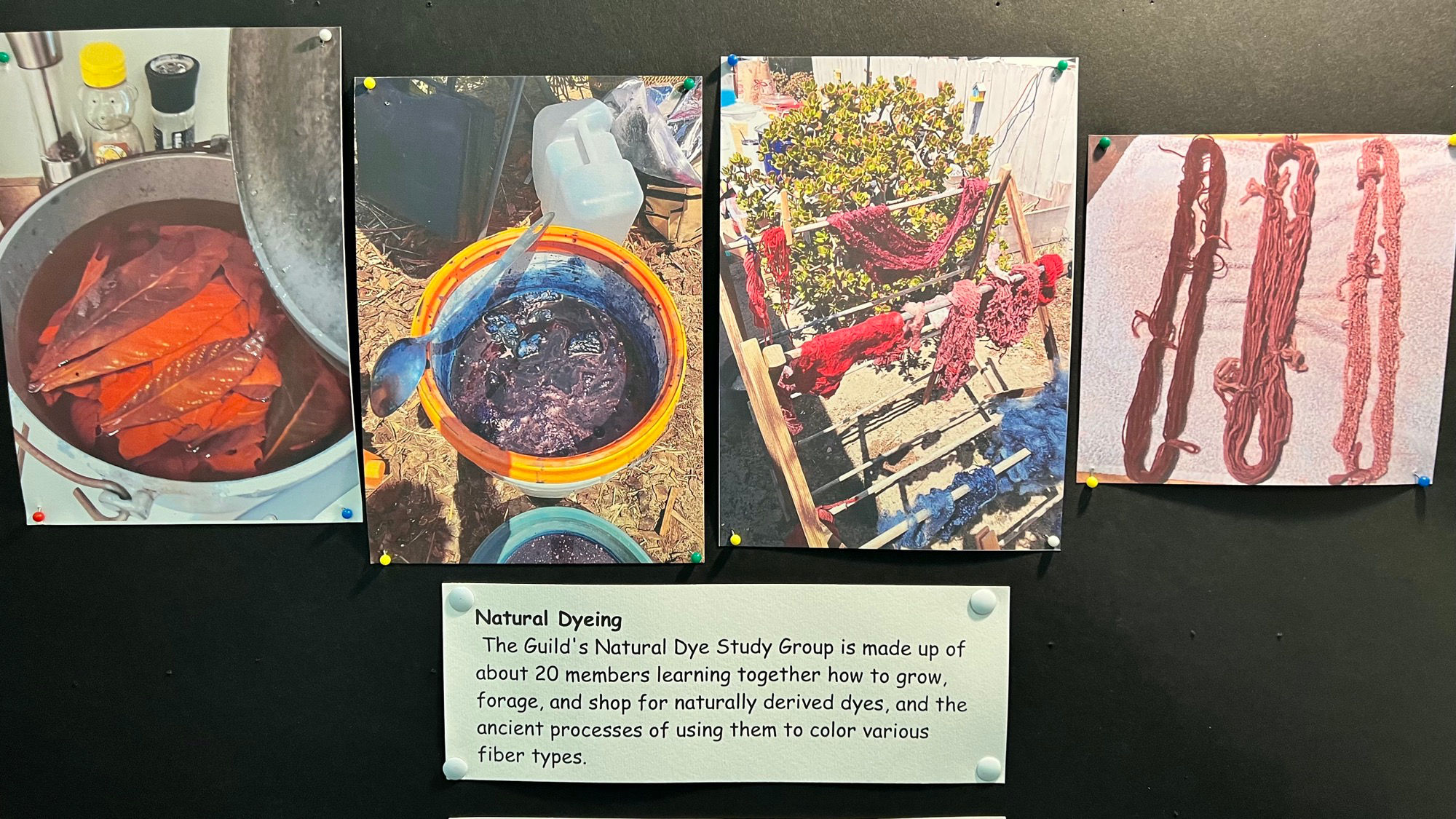
The Guild's Natural Dye Study Group is made up of about 20 members learning together how to grow, forage, and shop for naturally derived dyes, and the ancient processes of using them to color various fiber types.
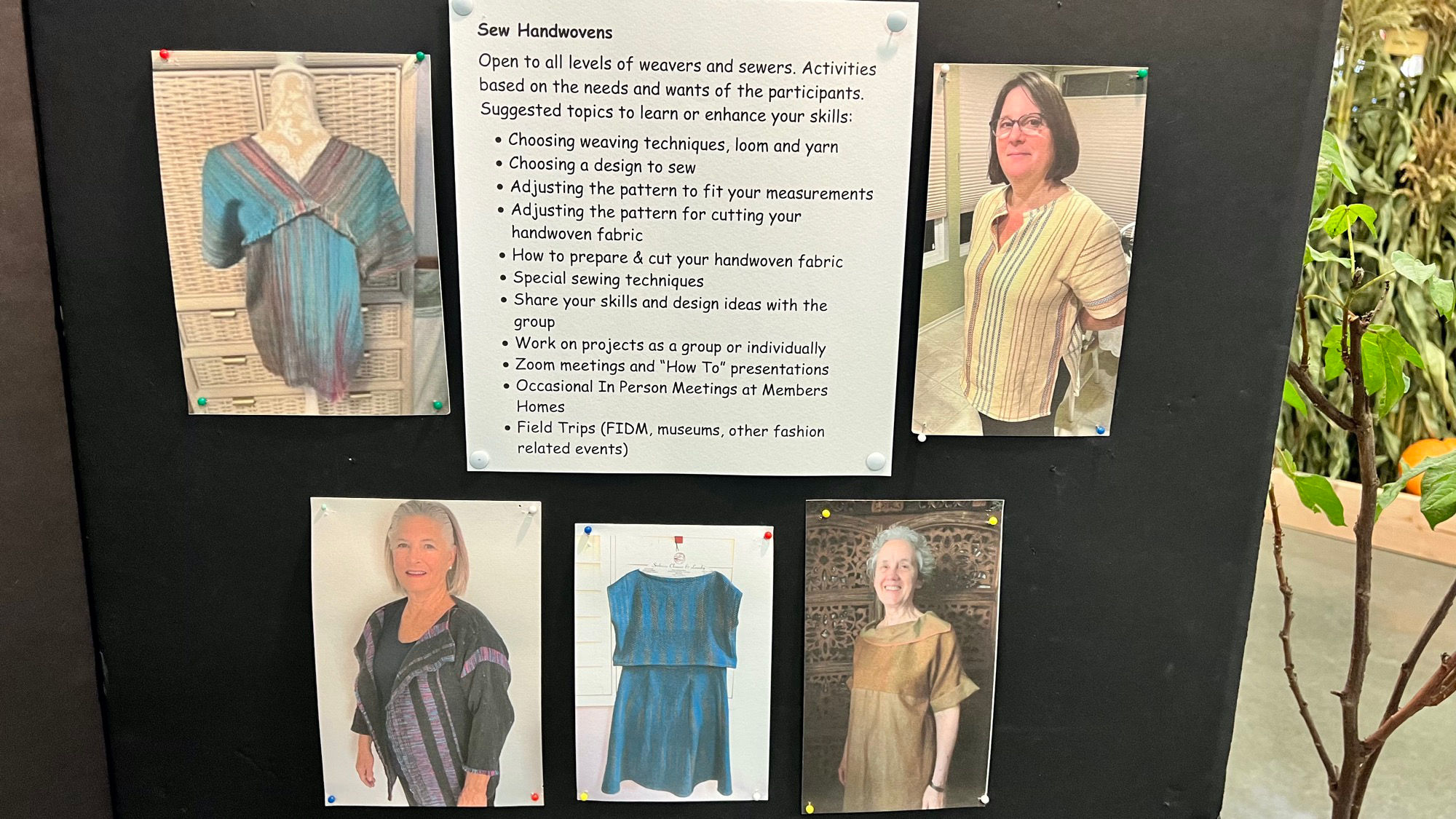
Open to all levels of weavers and sewers. Activities based on the needs and wants of the participants. Suggested topics to learn or enhance your skills:
- Choosing weaving techniques, loom and yarn
- Choosing a design to sew
- Adjusting the pattern to fit your measurements
- Adjusting the pattern for cutting your handwoven fabric
- How to prepare & cut your handwoven fabric
- Special sewing techniques
- Share your skills and design ideas with the group
- Work on projects as a group or individually
- Zoom meetings and "How To" presentations
- Occasional In Person Meetings at Members Homes
- Field Trips (FIDM, museums, other fashion related events)
Ventura County Handweavers & Spinners Guild:
Founded in 1970, the Ventura County Handweavers & Spinners Guild is an all volunteer organization dedicated to the education and promotion of fiber arts, with a focus on weaving and spinning. With an active membership of over 50 members, the guild participates in community events and sponsors a variety of educational programs and workshops in a broad range of textile-related crafts.Guild meetings are usually held the fourth Saturday of each month except November and December. Board meetings begin at 8:30 a.m., with the general meeting following at 9:30 a.m. A fiber-related program is presented at each meeting, often with a workshop continuing through the afternoon. Visitors and new members are always welcome.
Guild Study Groups
- Sewing with Handwoven
Open to all levels of weavers and sewers. Activities based on the needs and wants of the participants. Suggested topics to learn or enhance your skills:Choosing weaving techniques, loom and yarn ~Choosing a de-sign to sew ~ Adjusting the pattern to fit your measurements ~ How to prepare & cut your handwoven fabric ~ Special sewing techniques ~ Share your skills and design ideas with the group ~ Work on projects as a group or individually.
- Weaving with 8 Harness
Our vision is to have an in depth study of complex weave structures. Each month a person in the group will research a structure of their choosing and lead the discussion at that month’s meeting. Then we can all go away, warp up our looms and spend the rest of the month weaving that structure. Requirements for the study group: An 8 harness loom and the ability to warp and weave this loom. Weaving software would be helpful, but is not necessary.- Saori Weaving
This study group will explore incorporating SAORI concepts and techniques into weaving and encourage members to embrace their own uniqueness with their weaving. Members should have basic weaving skills and ability to warp a loom for plain weave.
What is SAORI?
SAORI is a plain weave, creative, free-style approach to weaving pioneered in Japan. SAORI emphasizes finger manipulation, color, texture and self-expression. SAORI is a great stash buster so the more fiber and yarns you have the better!- Natural Dying
The VCHSG Dye Garden is open to VCHSG members and VCHSG Fibershed Study Group Members. Current plantings include indigo, marigold, amaranth, madder, and more! The VCHSG Natural Dye Study Group would like to be scientific in our endeavors to work with local fibers.- Moonspinners Study Group
"Moonspinners. Sometimes, when you’re deep in the countryside, you meet three girls in the dusk, spinning. They each have a spindle, and on to these they are spinning their wool, milk-white, like the moonlight. Only when all the wool is washed and wound again into a white ball in the sky, can the moonspinners start their work once more, to make the night safe for all."- New Groups Coming Soon
The Ventura County Handweavers and Spinners Guild is in the process of organizing more study groups for a diverse selection that appeals to our member's varied interests and educational goals.https://vchsg.org/
https://www.facebook.com/groups/217550911640209/
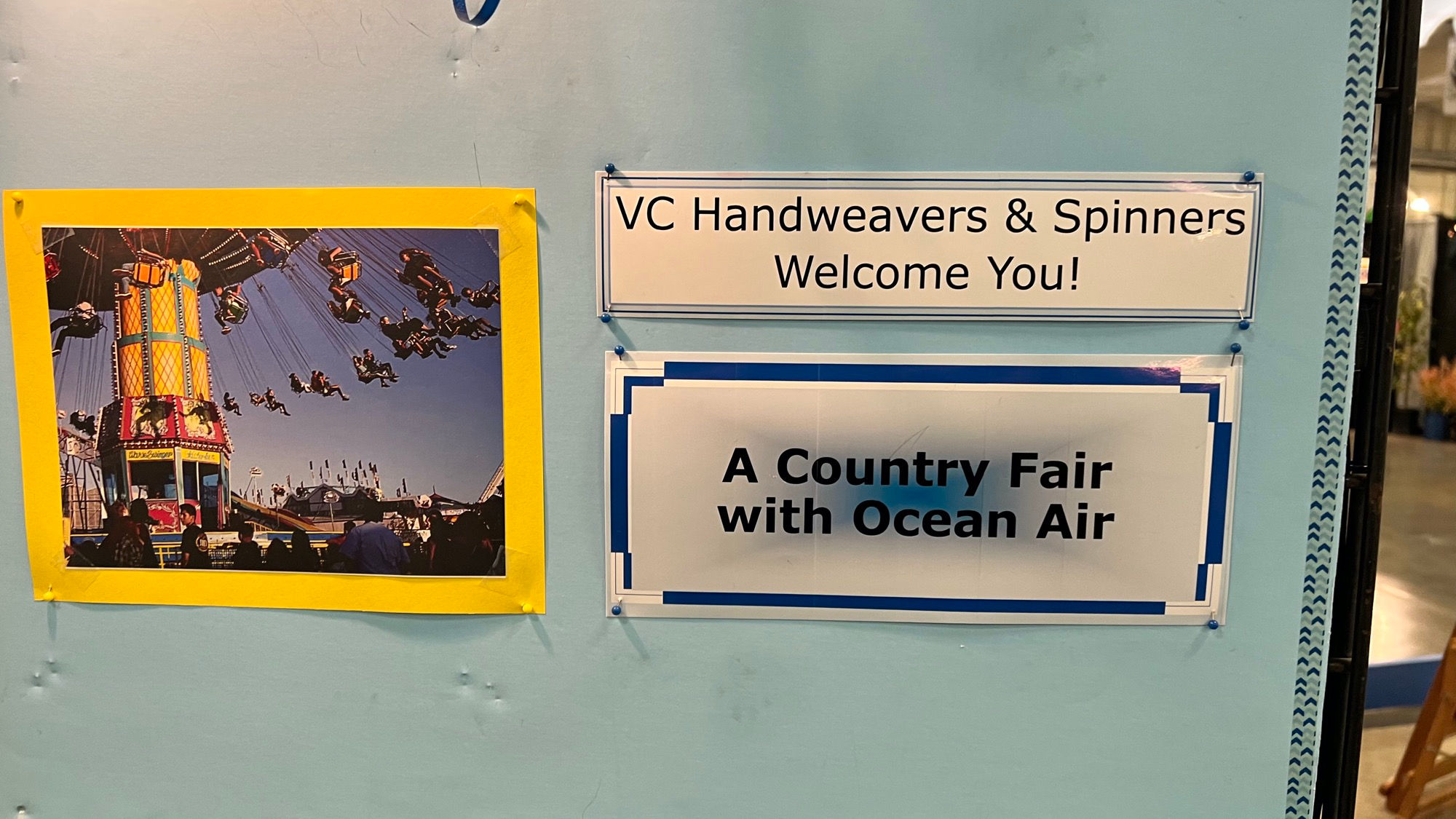
A Country Fair with Ocean Air




